



Creativeworks London PhD in Residence at Furtherfield
Download a pdf of the research here
Furtherfield believe that through creative and critical engagement with practices in art and technology people are inspired and enabled to become active co-creators of their cultures and societies.
VisitorsStudio, first developed in 2003 with artist programmer Neil Jenkins, is multi-media co-creation software which aims to work towards Furtherfield’s wider goals by providing a site for real-time collaborative creation, dialogue, polemic and networked performance and play.
A new 3 month residency project at Furtherfield in partnership with Creativeworks London has invited Alex Reynolds, an AHRC funded PhD student from Kingston University, to help conceptually redesign VisitorsStudio according to contemporary developments in software and changes in social interaction and exchange associated with ubiquitous mobile technologies; and to inform the rebuild of the site as a Free and Open Source project.
The project, entitled ‘Reviewing and Open-Sourcing VisitorsStudio’ will principally involve analysing other projects similar to VisitorsStudio and consulting with its users to help identify new features for design and interaction which could help productively rethink the online creation space. The project will also mean considering ways VisitorsStudio can most effectively provoke artistic engagement with contemporary social and cultural questions.
Through her research, Alex will be working to rethink the design and functionality of VisitorsStudio and will be producing ideas for a possible new site model by the end of the project in mid-June 2013.
Your opinions are important to this project! If you would like to offer your ideas about how we can best redesign VisitorsStudio for 2013 please feel free to get in touch by emailing Alex at alexandra.reynolds@kingston.ac.uk.
http://www.visitorsstudio.org
http://www.creativeworkslondon.org.uk/cw-news/phd-in-residence-round-one-awards/
http://fada.kingston.ac.uk/research/degrees/research_students.php
Some have proposed Jennifer Chan to be part of what has been termed as the post-internet era. But, this is an inadequate representation of the spirit, criticality and adventure at play in her work. Chan’s awareness and use of the Internet reflects a way of life, that situates its networks as a primary resource. Chan lives amongst various worlds and engages in different shades of being; a self-described ‘amateur cultural critic’, a net artist, a media artist, and academic. Her work exists both online and in physical realms, it is always present and contemporary. This is because her work lives in a world where the scripting of official art definitions loses its power. People have exploited technology to facilitate new behaviours where the artist or art amateur redefine what art is on their own terms. We are now in a post-art context. It reflects a very real, societal shift. Mainstream art culture no longer owns the consciousness of art, Chan and others like her are pulling it apart.
Marc Garrett: In your video Interpassivity a kind of docu-performance made for the exhibition REALCORE, you’re in a park spraying a brown cardboard box, silver. As you go through the process of walking around the box whilst spraying it, you comment on the object’s formal aspects. But, what you mainly discuss are your own personal views about contemporary art. It then becomes apparent that the box is a prop for the performance, enabling the subject to be explored.
Alongside your interpretations of the work my own thoughts on the subject feel as though they are included in the conversation. I know as a viewer, that the artist is not aware of my thoughts on the matter. However, it feels like there is space for me to be a part of the conversation. Not literally through a feedback system or interaction, but as an individual considering your personal questions. The artwork knows I am experiencing it, it knows that a consciousness out there is somehow engaging with its dialogue.
It is clear you are in tune with the feeling of dysfunction. You say, “I need to spit out some creative truth”. On hearing this, I was not sure whether this was a parady, irony or an expression of despair, or all these. You also say “contemporary art is removed from our everyday feelings”. As you express these words I begin the view the box as a symbol of contemporary art as a centralized, institutional monolith? So, before I unwittingly place my own meanings onto the work could you tell us what it means to you?
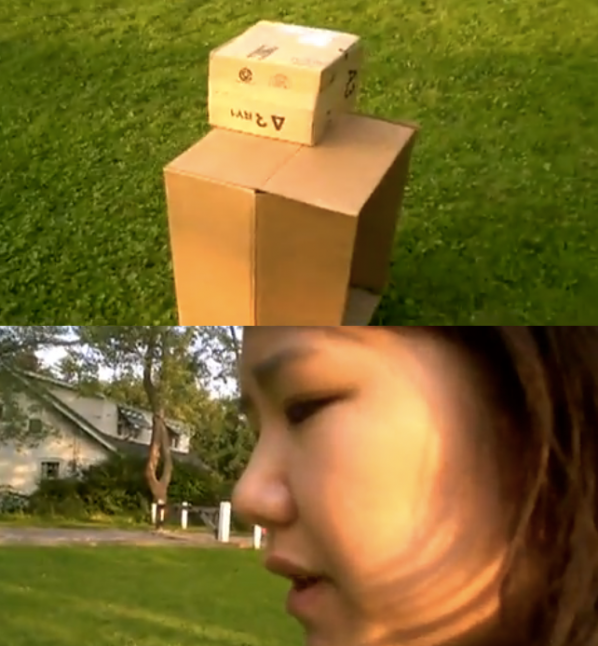
Jennifer Chan: Interpassivity is the instance of something cueing an audience to feel a certain way, such as canned laughter to stand in for humoured social reaction to jokes in a sitcom– even when it’s not funny. I titled it that because I felt like another art student trying to convince herself or the viewer what she made is art. I feel embarrassed about this self-aware but privileged complaining. A few people have found this work online and screened it, but I’m still mortified to watch it with them.
I made that video because I think a lot of contemporary art is sterile, mannered and removed from emotion. I wasn’t thinking of Donald Judd at that point but I could see the box standing in as a poor attempt at work, like his work. What I was working on (or seven years of art education) had little to do with what was happening in my life. (So to answer your question, yes, it is despair) Using my flipcam and talking over it was immediate for recording those ideas. It’s also a big trope of Canadian video art… a breathy voiceover conveys something serious and personal.
re: REALCORE. The title came about as a play on the idea of “real life”, or face-to-face life away from keyboard. Likewise, users would say “irl”(in real life), or “so real~” in Facebook comment threads to joke about the divide between online/offline contexts. The curator David Hanes felt the video was important to contextualize my use of sincerity and clichés, I was not being ironic in my intention. Arielle Gavin and Jaakko Pallasvuo thought it was questionably ironic and an emotive perspective on the Internet as a form of new sincerity.
I later found that someone wrote a paper by someone who coined “realcore” as a kind of amateur user-generated porn, which is a cool double-meaning. The “interpassivity” video was used to promote the show online but I showed my kitschy found footage videos on twisted pizza box plinths for the show. This was my fuck-you to geometric minimalism and boring white plinths, but I suppose it resulted in a different take of it…
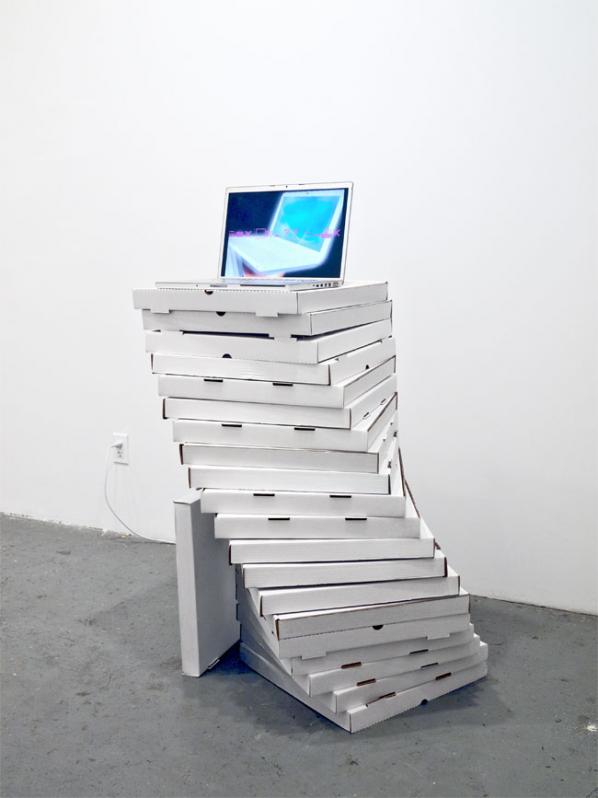
MG: In one of your recent videos “Grey Matter” when watching it felt like I was immediately pulled into a remixed world of teenage celebrity, products and brands, dripping in an orgasmic noise of techno-capitalism. Most of it is found footage, images, video and sound remixed into an edited compilation. Running through the video in between the high octane fuelled cuts and glitches, are messages to the Internet user who chances upon the video. These messages feel like they are from an individual voice but also of a multitude – caught up in a constant state of mediated folk hedonism.
What intentions lie behind this work as an artistic explorer of the entertainment culture you have remixed?
JC: Grey Matter is a first person account on feeling politically inactive online while having access to a wealth of information. I wanted to use remix in a confessional manner, so I combined obscure nostalgic media with embarrassing statements. The video begins with sped up footage of early 3D simulator ride called “Millennium Bug”. Y2K was the first technological “crisis” I recalled with clarity when I was growing up. The rest of the video includes cynical commentary on online spaces I’ve engaged with in the past year. (shopping on aliexpress.com and lurking people on OkCupid) “Little Prince” is compressed 25 times and sped up by 400%. I included old profile pics and some summary text from my OkCupid profile–I thought it was quite telling about how I wanted to be seen online and irl. I think it’s possible to feel mutually exclusive feelings at the same time, or maybe the experience of being active on different social networks produces a kind of schizophrenia. Collaging Internet pop culture is a way to appreciate it-as artifacts-in a complex light, and to be critical of it by acting out within its language.
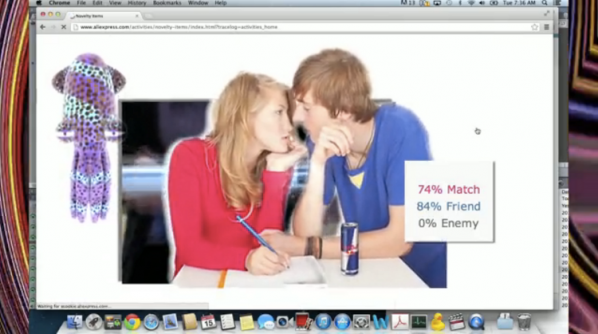
MG: What do you find fascinating about popular culture on the Internet?
JC: Anything minuscule has the potential to be popular amongst disparate users and they form vernaculars to talk about their interest in that. I find that desire relatable. That is what I think of as “community” online. It’s based on human interest and media fandom. Justin Bieber is made into something of a scapegoat for the first world’s shortcomings; people who like his image/music idolize him, and people who hate him are waiting for him to crack. Both are forms of fanaticism (one based on affinity; the other on hate-watching something.) Supercuts of Justin Bieber hairflips, object crushing fetishists, disease forums, long threads debating a detail…etc. I like the solipsism and intensity of all that.
MG: Can you share with us some of your critical insights and personal pleasures on this subject?
JC: Pop culture is paradoxical and audiences selectively enjoy it. (like teens dancing to hip hop with irreverence to its violent or sexist content.) Consuming and sampling pop allows people to indulge into its meanings, and through this there is a reconsideration of what “the masses” find important. Like the use of “users”, “masses” is what cultural studies calls everyone or everyone except-you. But every “user” has a specific relationship with interfaces and platforms, so they aren’t so homogenous.
Pop culture is also political. There was a time when more people voted for American Idol than the US elections, and if 10,000 people showed up to the 2012 cat video festival, entertainment is generally more seductive than current affairs–until there is a gatekeeping emergency (like mainstream media not covering the early days of Occupy). In terms of “internet pop culture”, perhaps traffic with social networking has overtaken porn and gambling online, but social news is also a kind of entertainment.

MG: Olia Lialina and Dragan Espenschied in their book Digital Folklore they celebrate everyday people’s use of personal computers with “glittering star backgrounds, photos of cute kittens and rainbow gradients”. They value the non-professionalism and amateur spirit that has come about from millions of people enjoying the Internet since it started. There is a difference now, the Internet masses have been shifted and prodded into large web 2.0 frameworks such as Facebook, and an abundance of personal web projects have been lost since.
And, like them do you find reassurance or a personal connection with the Internet Amateurs of the world?
JC: In context of new media art, it’s probably more accurate to think of amateurs as people who don’t self-identify as artists or technicians. What non-artists do with software and video appears facile, sincere, and intuitive. I make amateur-looking work to dialogue with that.. I like to say something dumb to say something serious. Something that’s made simplistically and filled with kitschy references can be packaged as critique that also appeals to non-art audiences.
I caught the tail end of the homepage-o-sphere/webring 1.0 period. Non-artists made personal websites out of a genuine interest in something. tumblr and pinterest is used in a same way today–to collect indiscriminately. Like 2.0 frameworks, the early internet also had free webpage hosting that users relied on (Geocities and Lycos). Personal website design isn’t over either; net artists still make them or bind together to create their own sites (like tightartists.com). I think I have an idea of what you mean though; it was less commercial and there weren’t as many distinct “most-visited” places online.
I made a lot of gothy dark art on DeviantArt before I knew about contemporary art, and my sensibility towards Photoshop was more romantic and impulsive without the baggage of art education. Maybe this “revival” cult of amateur-looking digital folklore happened because I/we exoticize that kind of amateur production. Web vernaculars have also become stylized and this aesthetic is shared with seapunks and filmmakers. Artists need to adapt to that.
MG: What do you feel is still alive and open for everyday online expression and play, in respect of what Lialina and Espenschied perceive as Digital Folklore?
JC: I think a lot of emerging artists have a greater awareness of obsolescence and upgrade culture than we give them credit for–while still complacent to the socialization structures on Facebook. Many seem more interested in navigating these networks to question their inner control mechanisms than overthrowing them or innovating new ones. It can be simple things like friending as many users as possible, looping webcam feeds, archiving and re-uploading banned content on different platforms, having an anonymous/alternate personas/using multiple accounts…etc. People like glitchr and Ian Aleksander Adams are always looking for ways to use a system against its intended functions in the same way jodi did all the cheat moves in max payne CHEATS ONLY. I admire glitch practices for that.
There’s also the possibility for re-appropriating anything to rebrand or critique particular communities. I think Angela Washko and Jaakko Pallasvuo are doing this in a compelling way that covers a large territory between art and Internet culture.
MG: So, what are you working on at the moment?
JC: <–for some reason this sounds less perverted than if I were an old guy doing this to teen girls but its really just as perverse–>
I’m observing what young adult/teen boys do on YouTube: bulking up, performing dares, talking about how to pick up a White/Asian girls etc. I’m also making a video about Asian guys (both diasporic, Asian American, and more specifically, Korean and Taiwanese men) and their interpretations of mediated masculinity. There is something disturbingly tantalizing in terms of how they have learned to look at the webcam as if they are boy band stars yet they are not fully grown men. A lot of this is informed by growing up in Hong Kong, and knowing that fashion and romance, is inspired by many “neighbouring” cultural media from Japan, Korea and Taiwan even though American/British influence is also prominent in the club scene.
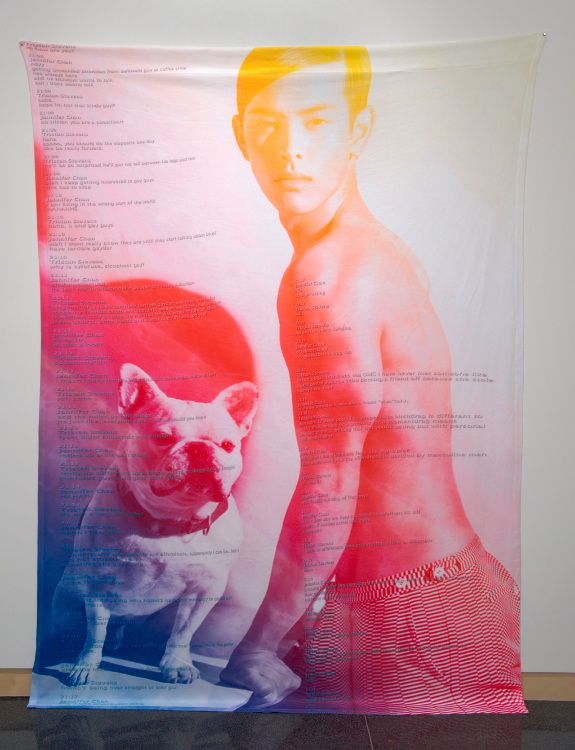
Here are two images from my late installation that will foreshadow this interest. It’s chat text over layered on modified fashion and makeup adverts targeted at Korean and Chinese men, and printed onto micro-fibred bedding. I feel like they’re treated as pleasant freak shows on tumblr but this imagery is a banal, idealized kind of masculinity in Asia. I think western facial features are really common amongst these popular images of Asian-ness, and most would tend to read it as aspiring to western culture, though the hyperfemme “doll” look or metro-masculinity has been a regional style since the 90s.
Chan’s work reflects an emerging condition described by Zizek as “interpassivity” in which our engagement with interactive experience has lost traction and is replaced with “its shadowy and much more uncanny supplement/double “interpassivity””[1], a “Fetish between structure and humanism”[ibid]. We are pulled into a paradox, where ‘interaction and passivity’ are joined together as spectacle of constant mediation. Millions have joined online centralized, megastructures such as Facebook, and this is not a black and white situation. Many are coerced from social and consumer pressures into the state of being seen as interacting. As the futuristic time machine streams onwards at high-speed, agency slouches into a spurious and distant dream. Others and the same are enjoying the flow for the sake of self expression within these scripted frameworks.
Chan’s work critiques, plays with, and exploits this networked, social intervention, as well as her viewers’ desires. Her imaginative palette revivifies questions about agency, passivity, sexuality, privacy, individuality, behaviour, networked consumption and its production. These remixed artworks have much material to work with, as the endless ether of everyday noise is uploaded and distributed through blogs and social networking sites; then returned into the ether as cut-ups where a transforming culture is engaged in its own mutation.
Its noise engages us whether we enjoy it or not, in the medium of “interpassivity”, and we all find ourselves caught within this spectacular enticement driven by the Netopticon. “On a holiday trip, it is quite common to feel a superego compulsion to enjoy, one “must have fun” — one feels guilty if one doesn’t enjoy it.”[ibid]
Jennifer Chan – http://www.jennifer-chan.com/
Heavy MetaVernacular video after the popularization of the internet
http://jennifer-chan.com/index.php?/curatorial/heavy-meta/
SELF-LOVE A non-consensual exhibition of emerging net art
http://jennifer-chan.com/index.php?/curatorial/self-love/
New Insularity Peer backpatting. A screening of works by friends and users whose works I admire.
http://jennifer-chan.com/newinsularity.html
Feeling VideoThe affective appeal of antisocial video
http://jennifer-chan.com/index.php?/curatorial/feeling-video/
Trivial Pursuits Distracting “new media art”
http://jennifer-chan.com/index.php?/curatorial/trivial-pursuits/
+ See images from the event on flickr.
Part of the Movable Borders: Here Come the Drones! exhibition at Furtherfield Gallery.
In a post-national age, where “territorial and political boundaries are increasingly permeable”[1], what has become of the borderline? How is it defined, and what technologies are used to control it?
Movable Borders is an ongoing research project that begins to explore possible answers to these questions through facilitating discussions around the ‘reterritorialisation’ of the borderline in the information age. Participants are invited to investigate the use of cybernetic military systems such as remotely piloted aircraft (drones) and the Disposition Matrix, a dynamic database of intelligence that produces protocological kill-lists for the US Department of Defense.
The Reposition Matrix aims to reterritorialise the drone as a physical, industrially-produced technology of war through the creation of an open-access database: a ‘reposition matrix’ that geopolitically situates the organisations, locations, and trading networks that play a role in the production of military drone technologies.
During the workshop, participants will investigate the weapons industry and intelligence agencies that operate in the background of the drone campaigns ongoing in the Middle East. Information will be gathered through a diverse range of sources – from corporate publications to leaked document repositories. The information gathered during the research session will then be used as the basis for the collaborative development of a new world map: a diagram that exposes the complex networks of control and influence that exist at the core of the drone campaigns.
Cartographers, designers, artists, activists, political scientists, journalists, and anybody with a strong interest in understanding and discussing the materiality of the drone wars are invited to participate.
Participants will be able to gain an understanding of the geopolitical complexity of the war through collaborative research, discussion, and mapmaking sessions. Those who attend the workshop will also become contributors to an ongoing project – the formulation of an open-access database cataloging the information discovered during the series of workshops.
Furtherfield Gallery – Saturday 18 May 2013, 1-5pm
Visiting information
To book your place please contact Alessandra (Furtherfield).
Dave Young
Dave Young is an artist, musician and researcher currently studying the Networked Media course at the Piet Zwart Institute in Rotterdam, NL. His research deals with the Cold War history of networked culture, exploring the emergence of cybernetic theory as an ideology of the information age and the influence of military technologies on popular culture.
Furtherfield Gallery is supported by Haringey Council and Arts Council England.
Curated by Rosa Menkman & Furtherfield.
Opening Event: Saturday 8 June 2013, 2-5pm
with Glitch Performance by Antonio Roberts at 3pm
Open Friday to Sunday 11-5pmContact: info@furtherfield.org
DOWNLOAD PRESS RELEASE
IMAGES OF THE OPENING ON FLICKR
READ Glitch as a Symbolic Art Form BY ROB MYERS
WATCH VIDEO OF THE OPENING
“The glitch makes the computer itself suddenly appear unconventionally deep, in contrast to the more banal, predictable surface-level behaviours of ‘normal’ machines and systems. In this way, glitches announce a crazy and dangerous kind of moment(um) instantiated and dictated by the machine itself.” Rosa Menkman [1]
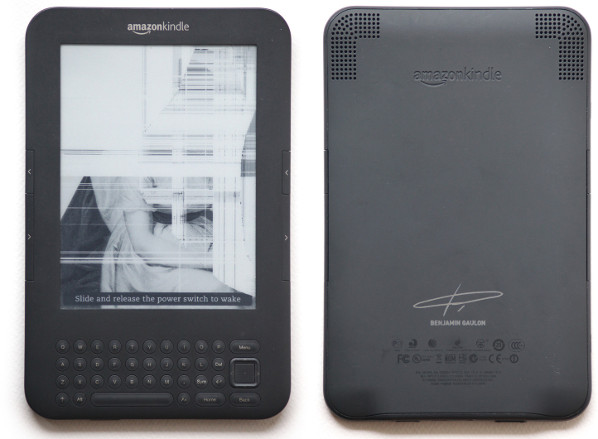
Glitches are commonly understood as malfunctions, bugs or sudden disruptions to the normal running of machine hardware and computer networks. Artists have been tweaking these technologies to deliberately produce glitches that generate new meanings and forms. The high-speed networks of creation and distribution across the Internet have provided the perfect compost to feed this international craze. The exhibition shows various approaches by artists hacking familiar hardware and their devices which include mobile phones, and kindles. They disrupt both the softwares and the digital artefacts produced by these softwares, whether it be in the form of video, sound and woven glitch textiles.
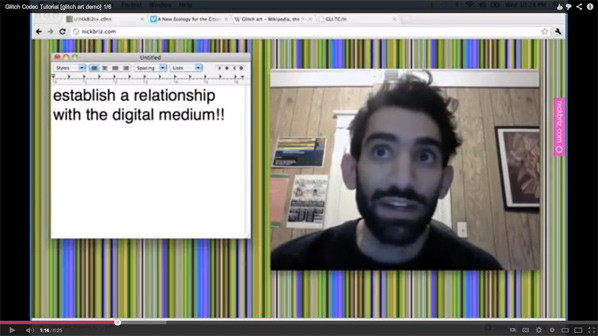
Glitch art subverts the way in which we are supposed to relate to technology, causing playful, imaginative disruptions. It is a low-tech and dirty media approach with a punk attitude. These artists appropriate the medium and forge expressions that go beyond what the mainstream art world expects artists to do, it is unstoppable – it is Glitch Moment/ums.
Copies of Rosa Menkman’s groundbreaking Glitch Art critique The Glitch Moment(um) will be available for purchase during the exhibition.
![numbermunchers from the untitled [screencaptures] series by Melissa Barron](http://www.furtherfield.org/wp-content/uploads/2013/04/melissabarton.jpg)
Empty Spinning Circle become Full (part b) (2012) from the Further Abstract series by Alma Alloro
One Square in colors (2012) from the Further Abstract series by Alma Alloro
untitled [screencaptures] (2010) by Melissa Barron
The Glitch Codec Tutorial by Nick Briz
KindleGlitched (2012) by Benjamin Gaulon
Thoreau Glitch Portrait (2011) by José Irion Neto
Copyright Atrophy (2013) by Antonio Roberts
What Revolution? (2011) by Antonio Roberts
Beyond Yes and No (2013) by Ant Scott
Glitch artists and enthusiasts are invited to add their work to GLI.TC/H 0p3nr3p0.net, a Glitch Art repository coded by and developed by Joseph ‘Yølk’ Chiocchi & Nick Briz. The submissions will be showcased during Glitch Moment/ums at Furtherfield Gallery. To include your work in the 0P3NR3P0 component of Glitch Moment/ums submit a link to any visually wwweb based file (html, jpg, gif, youtube, vimeo, etc.) and your piece will automatically be included in the line-up (one work per artist).
This new IRL exhibition has been organised in collaboration with Nick Briz and Joseph ‘Yølk’ Chiocchi.
SUBMIT && SHOW on 0P3NR3P0.NET.
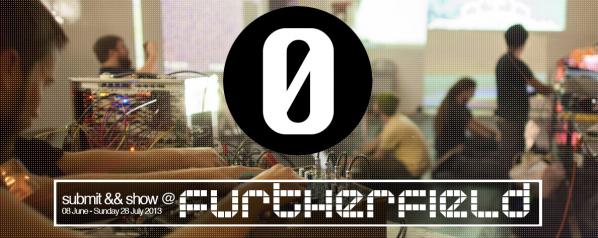
Alma Alloro
Alma Alloro (IL) is an artist, musician and performer from Tel Aviv. She is rooted in the backyard of popular culture using diversified media from drawing, installation, music, and animation to internet; her recent works focus on the correlation between old media and new media.
Melissa Barron
Melissa Barron is an artist living and working in Minneapolis, Minnesota. She studied at the School of the Art Institute of Chicago where she focused on new media and fiber. In her work she combines these two fields by reinterpreting hacked Apple 2 software through different fiber techniques. Her work has been shown at various international events, including the Notacon hack festival in Cleveland, Ohio, GLI.TC/H in Chicago and ISEA 2011 in Instabul.
Nick Briz
Nick Briz is a newmedia artist, educator and organiser based in Chicago IL. His work has been shown internationally at festivals and institutions, including the FILE Media Arts Festival (Rio de Janeiro, BR); Miami Art Basel; the Images Festival (Toronto, CA) and the Museum of Moving Image (NYC). He has lectured and organized events at numerous institutions including STEIM (Amsterdam, NL), the Museum of Contemporary Art Chicago, Marwen Foundation and the School of the Art Institute of Chicago. His work is distributed through Video Out Distribution (Vancouver, CA) as well as openly and freely on the web.
Benjamin Gaulon
Benjamin Gaulon is an artist, researcher and art college lecturer. He has previously released work under the name “Recyclism”. His research focuses on the limits and failures of information and communication technologies; planned obsolescence, consumerism and disposable society; ownership and privacy; through the exploration of détournement, hacking and recycling. His projects can be softwares, installations, pieces of hardware, web based projects, interactive works and are, when applicable, open source.
José Irion Neto
José Irion Neto is native of Santa Maria, in southern Brazil. His first contact with computers was in 1982 using a machine equivalent to Sinclair ZX Spectrum. He has an academic background in Media Advertising and worked for some years as a Graphic Designer. Today, he has been working with advertising only occasionally, focusing on creating posters, dedicating most of his time on developing Glitch Art. He has worked and researched Glitch since 2008.
Antonio Roberts
Antonio Roberts is a British digital artist whose artwork focuses on the errors and glitches generated by digital technology. Many people would simply discard such artefacts but Antonio preserves these errors and displays them as art. With his roots in free culture he develops his techniques using open source and freely available software and shares his knowledge through the development of software.
Ant Scott
Ant Scott (UK) is a glitch artist and co-author of the first glitch aesthetics coffee table book Glitch: Designing Imperfection (New York: MBP, 2009). His work is informed by cognitive distortions.
Rosa Menkman
Rosa Menkman is a Dutch visualist who focuses on visual artifacts created by accidents in digital media. The visuals she makes are the result of glitches, compressions, feedback and other forms of noise. By combining both her practical as well as an academic background, she merges her abstract pieces within a grand theory artifacts (a glitch studies), in which she strives for new forms of conceptual synthesis of the two. In 2011 Rosa wrote Glitch Moment/um, a notebook on the exploitation and popularization of glitch artifacts (published by the Institute of Network Cultures), organized the GLI.TC/H festivals in both Chicago and Amsterdam and co-curated the Aesthetics Symposium of Transmediale 2012.
Furtherfield Gallery
McKenzie Pavilion, Finsbury Park
London N4 2NQ
T: +44 (0)20 8802 2827
E: info@furtherfield.org
Furtherfield Gallery is supported by Haringey Council and Arts Council England
MOVABLE BORDERS: THE REPOSITION MATRIX workshop
organised by Dave Young
Saturday 18 May 2013, 1-5pm
BOOKING ESSENTIAL. Please register with Alessandra.
The devices that once populated the creepy dystopian futures of science fiction have broken through into our daily reality.
Drones of dozens of different types are becoming a part of everyday life. They scout our public (and private) spaces, carrying out surveillance or reconnaissance in the service of nation states and as unmanned robotic tools, armed with missiles and bombs, acting in defence of “national security”.
According to a European commission document drones will be commonplace in the skies within a decade. There are already many companies building these airborne, robotic spies for military and police use and this has “prompted concerns from civil liberties groups, who fear that the unmanned aircraft will result in more forms of surveillance.” [1]
During the three weeks of Movable Borders: Here Come the Drones! people are invited to view artworks and join a workshop by artists who are contemplating how drones are changing the way we see and relate to each other and the world around us.
Artworks and projects by Bureau of Inverse Technology (US & AU), Lawrence Bird (US), Patrick Lichty (US), Dave Miller & Gavin Stewart (UK), The Force of Freedom (NL) and Dave Young (NL).
Bit Plane by Bureau of Inverse Technology (Natalie Jeremijenko and Kate Rich) is an early artistic reflection on the relation between technology and surveillance and, as such it can be seen as a precursor to the emerging DIY surveillance video enabled by the new availability of drones. The bit plane is a radio-controlled model airplane, designed by the Bureau and equipped with a micro-video camera and transmitter. In 1997 it was launched on a series of sorties over the Silicon Valley to capture an aerial rendering. Guided by the live control-view video feed from
the plane, the pilot on the ground was able to steer the unit deep into the glittering heartlands of the Information Age.
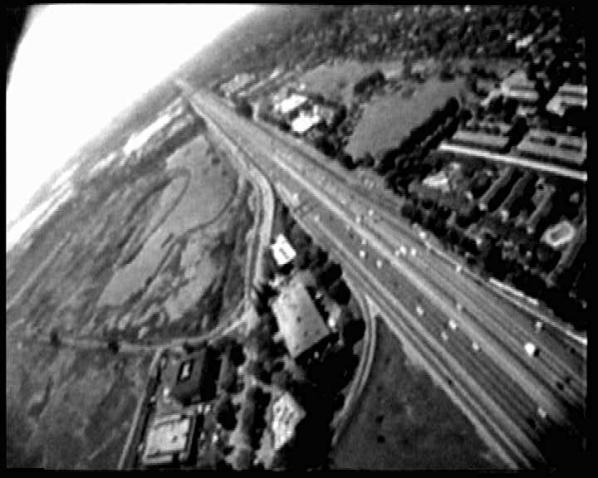
Parallel by Lawrence Bird uses Google Earth to track the 49th parallel, i.e. the prairie border between Canada and the United States. The digital projection invites open interpretations: it is a film about parallel countries; parallel modes of imaging and imagining; parallels between political, technical and visual territories. Obvious digital anomalies in the video, caused by satellite interference, allow for further speculation and imaginative readings.
The Private Life of a Drone by Patrick Lichty is a video travelogue recorded by flying video drones, exploring the area surrounding the Virginia Center for the Creative Arts in Amherst, Virginia (US).
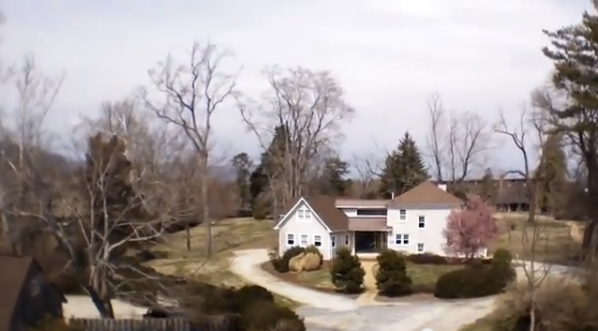
Lines by Dave Miller and Gavin Stewart draws on an emergent cultural interest in drones to explore related issues around privacy, mediation, power, security, morality, legality and others in all aspects of contemporary life. Lines aims to encourage and affect public debate.
TELEWAR is a book and video collaboration between Dave Young and The Force Of Freedom collective. The project tries to make some sense of the uses, effects and developments of the new warfare technologies, like military drones, through the analysis of news reports, military drone culture, drone speak and network theory.
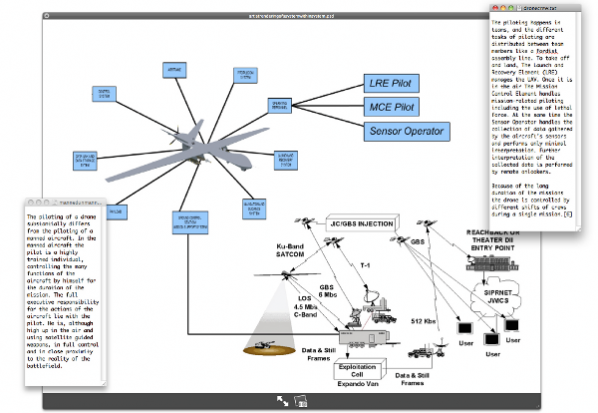
Movable Borders – The Reposition Matrix by Dave Young provides the central installation and information resource of the exhibition.
In a post-national age, where “territorial and political boundaries are increasingly permeable”[2], what has become of the borderline? How is it defined, and what technologies are used to control it?
Movable Borders is an ongoing research project that begins to explore possible answers to these questions through facilitating discussions around the ‘reterritorialisation’ of the borderline in the information age.
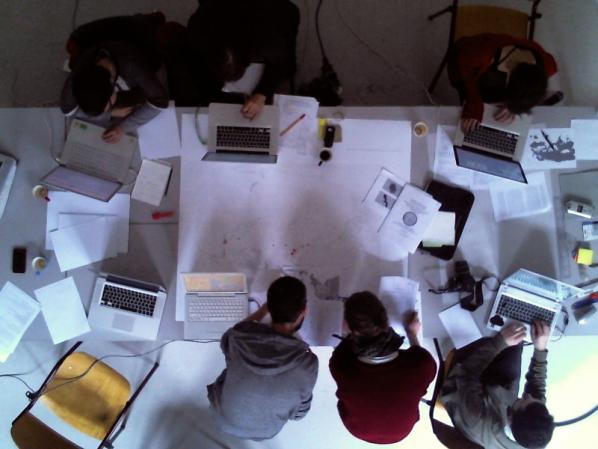
The Reposition Matrix aims to reterritorialise the drone as a physical, industrially-produced technology of war through the creation of an open-access database: a ‘reposition matrix’ that geopolitically situates the organisations, locations, and trading networks that play a role in the production of military drone technologies.
Alongside the installation Dave Young will be holding a workshop on the subject of drones on Saturday 18 May, 1-5pm – BOOKING ESSENTIAL. More info here.
Lawrence Bird
Lawrence Bird is a designer, instructor and writer with an interest in cities and their image. He has trained in architecture (B.Arch), social sciences and urban design (MSc), and history and theory of architecture (PhD). He has recently completed the SSHRC-funded postdoctoral project Beyond the Desert of the Real, based in Winnipeg, Canada. The project focused on desolate urban sites, elicited visual narratives from city residents and graduate students of architecture in response to them, experimented with representations of the city based on these narratives, and used these strategies as points of departure for urban design and urban landscape proposals. Lawrence also makes films, and is currently developing a hybrid film and animation project WPG_POV.
Bureau of Inverse Technology
The Bureau of Inverse Technology (aka BIT) is an organisation of artist-engineers whose stated aim is to be an information agency servicing the “Information Age”. Bureau engineers are involved from design to deployment and documentation of radical products based on commercially available electronic entertainment components such as cameras, radios, networks, robots, sensors, etc. Though its work has long been publicly available, the composition of the Bureau itself is shrouded in some mystery, for some years cloaking its identity in anonymity. In 2004 the Bureau initiated a “retreat from anonymity” when radio journalist and BIT co-founder Kate Rich took up a three month Research Fellowship at Piet Zwart Institute for Media Design Research, Rotterdam in 2004. Current Bureau products include BIT Radio, Feral Robotic Dogs and the Despondency Index.
Patrick Lichty
is a technologically-based conceptual artist, writer, independent curator, animator for the activist group The Yes Men, and Executive Editor of Intelligent Agent Magazine. He began showing technological media art in 1989, and deals with works and writing that explore the social relations between us and media. Venues in which Lichty has been involved with solo and collaborative works include the Whitney & Turin Biennials, Maribor Triennial, Performa Performance Biennial, Ars Electronica, and the International Symposium on the Electronic Arts (ISEA). Patrick also works extensively with virtual worlds, including Second Life, and his work, both solo and with his performance art group Second Front, has been featured in Flash Art, Eikon Milan and ArtNews. He is also an Assistant Professor of Interactive Arts & Media at Columbia College Chicago, and resides in Baton Rouge, LA.
Dave Miller
Dave Miller is a South London based artist and currently a Research Fellow in Augmented Reality at the University of Bedfordshire. Through his art practice Dave draws out the invisible forces that make life difficult. His work is about caring and being angry as an artist. His art enables him to express feelings about the world, to attempt to explain things in a meaningful, yet subjective way, and make complex information accessible. Recurrent themes in his work are: human stories, injustices, contentious issues and campaigning. Recently he has been very bothered by the financial crisis.
Gavin Stewart
Gavin Stewart is Lecturer in Digital Media at the University of Bedfordshire, poet and writer. He is the current convener of the Interactive Media Group. His research interests are the aesthetics of digital texts and the impact of corporate digital media on our understanding of community. Gavin is course leader in BA Media Production and currently teaches units in Media and Cyberculture and Print, Culture and Technology at MA Level. Gavin is is also the co-organiser of the Playful Paradox mini-festival, the End of Journalism conference and the Under the Mask: Perspective on the Gamer conference series.
The Force Of Freedom
The Force Of Freedom is a Rotterdam based collective founded by Micha Prinsen and Roel Roscam Abbing in 2009. In their work they react critically but playfully to new emerging technologies and developments on the internet.
Dave Young
Dave Young is an artist, musician and researcher currently studying the Networked Media course at the Piet Zwart Institute in Rotterdam (NL). His research deals with the Cold War history of networked culture, exploring the emergence of cybernetic theory as an ideology of the information age and the influence of military technologies on popular culture.
Furtherfield Gallery
McKenzie Pavilion, Finsbury Park
London N4 2NQ
T: +44 (0)20 8802 2827
E: info@furtherfield.org
Furtherfield Gallery is supported by Haringey Council and Arts Council England.
Drake Music launches a making day to inspire the creation of more accessible musical instruments.
On Sunday 21 April Drake Music will run a hackday to create and share new instruments that break down disabling barriers to music making. Run in partnership with Furtherfield and Music Hackspace, makers will have the opportunity to work towards one of two prizes for the most innovative work.
Hacking To Make Music Accessible Day is part of Drake Music’s new R&D programme, which aims to:
As of January 2013, there are only 6 widely available solutions for accessible music making. In contrast an orchestra is made up of at least 19 instrument types; rock and pop frequently use 4 or more types; and the instruments used in world, electronic, jazz and folk music add up to a rich and diverse pallet of choice for most aspiring musicians. This disparity needs to be bridged, in particular with the development of more expressive musical instruments for those facing barriers to music making.

Hacking To Make Music Accessible is developed with and supported by Music Hackspace and Furtherfield. This event is also a precursor to a series of projects and initiatives which will be hosted at the WeShare Lab later this year.
“I have been bowled over by the enthusiasm and seriousness of the hacking community when faced with the question of how we can create and develop new tools to make music making accessible. This event is the first of many, and allows us to collaborate with the widest range of talent in creating the most innovative tools for a sector that desperately needs them. “ – Gawain Hewitt
For further information please contact Gawain Hewitt, Drake Music Associate Musician and Associate National Manager – Research and Development.
Drake Music breaks down disabling barriers to music through innovative approaches to making, learning and teaching music. Now in its 25th year, Drake Music continues to play a pioneering role in the development and imaginative use of Assistive Music Technology (AMT) to make music accessible. Drake Music is the only organisation in England specialising in the use of AMT to break down (physical/societal) barriers to participation.
Our focus is on nurturing creativity through exploring music and technology in imaginative ways. We put quality music making at the heart of everything we do, connecting disabled and non-disabled people locally, nationally and internationally. Drake Music is an Arts Council NPO.
The London Music Hackspace originated as a subgroup of the London Hackspace as a place to share thoughts, knowledge, technologies, processes and aesthetics on music and audio. We foster innovation by gathering skilled professionals and facilitating exchanges between disciplines, from software development to music installations and production. The Music Hackspace organises weekly events, including presentations and talks by artists and musicians, workshops, performances and unexpected collaborations. Music Hackspace are member of London Hackspace.
Drake Music and Furtherfield have come together to create WeShare, a new initiative building on the combined creative assets, specialisms and strengths of both our organisations. In a series of projects in the first phase of WeShare, supported by an organisational development grant from Arts Council England, we tested and piloted new ways of working and collaborating through projects such as Pecha Kucha Beta and Deconstructing Pecha Kucha. This year will see the launch of the WeShare Lab, which will support and host events similar to Hacking to Make Music Accessible.
WeShare has emerged from three years of successful partnership-working between Drake Music and Furtherfield who share a critical and creative engagement with art, music and technology with a focus on participation and collaboration. It aims to amplify the existing quality, reach and value of our organisations’ work, finding new ways to share knowledge, ideas, resources and opportunities; creating new ways of producing and sustaining socially engaged art and culture.
Furtherfield Gallery
McKenzie Pavilion, Finsbury Park
London N4 2NQ
T: +44 (0)20 8802 2827
E: info@furtherfield.org
Furtherfield Gallery is supported by Haringey Council and Arts Council England
About a year ago Eleanor Greenhalgh started her project The Dissolute Image (TDI), a speculative, poetic image hosting technique. By splitting images into individual pixels and distributing them, it enables banned content to be secretly posted on corporate social platforms. TDI enables users to post a single pixel on their own social media page. All the entries are tracked by TDI and each pixel will re-appear on a dedicated website, eventually re-forming the image. I asked Eleanor about her motivation and interest in censorship and hosting issues.
Annet Dekker (AD): Could you tell me a little bit about your background?
Eleanor Greenhalgh (EG): I did a fine art BA at Oxford Brookes in the UK where I started working on participatory projects. I consider myself somewhere between a curator and a facilitator, but it is a role that I haven’t quite worked out. From being involved in environmental activism, I became really fascinated by the way that these kinds of groups organized themselves. These were non-hierarchical groups that tried to avoid replicating the types of hierarchies which they’re opposing. It is a really fascinating process because it doesn’t always go so well.
AD: Could you give an example of such conflict?
EG: Facebook for example hides its ideological biases behind fluffy language of wanting to make it a community space that’s safe for everybody, so you’re not going to come across offensive material. Whereas you talk to an anarchist hosting collective, they will be honest and tell that they’re not hosting stuff that they disagree with, because they consider it part of their activism and they’re not going to give resources to a cause that they disagree with. So how does that relate to the demand for solidarity? It’s a recurring problem. If you believe in building some kind of alternatives, solidarity is essential. But where does your desire to show solidarity conflict with your own values, your own autonomy?
I think this is a source of deep ambivalence. On the one hand being autonomous, while at the same time being deeply vulnerable to the collective – whether relying on others to host your data, to back you up on a demonstration, or just look after each other on a very physical level. I want to expose this vulnerability, this ambivalence, which you find between the two extremes of total autonomy or total solidarity. Rather than choosing one of them, I’m interested in looking in the middle and asking, why is it that being in the middle is so uncomfortable, and why is there this temptation to flee to one of these two extremes?
AD: Why is being in the middle uncomfortable? Isn’t that the place that most people choose to be in?
EG: I think social life puts us in the middle, whether we choose it or not. To give an example from a campaign I’m involved with, for abortion rights: we use the rhetoric of ‘bodily autonomy’. Yet, this ‘autonomy’ relies upon medical care given by others. It can only exist because of other people. What’s uncomfortable about this fact is that it confronts us with our own vulnerability. The fantasy of an asocial autonomy is seductive (and dangerous); the idea that we could be self-sustaining, without the need to do politics.
AD: During your time at Piet Zwart Institute in Rotterdam you focused a lot on the issues of censorship and hosting, both in The Dissolute Image (TDI) and in Volunteer Hosts, where you asked people to physically host files which they didn’t know the contents of. What is your interest in hosting?
EG: I became interested in hosting from two angles. Firstly from a social angle, and the power dynamics of who hosts what and why. Secondly from a physical angle, the fact that data needs to live somewhere and our reliance on hardware and services that we don’t own and have little control over. I’m interested in how that relates to people who are trying to articulate an alternative. Also asking the question of whether hosting something is the same as endorsing it.
I have been watching for example the work that Freedom Box has been doing, developing a small server that you can carry with you. The emphasis is that this is on your body and it is in your house, which makes it harder to seize data because different laws apply when something is in your house. I am exploring or even arguing for the beauty of this kind of approach – the beauty of the continued need for physical space. Hakim Bey (who is good at rhetoric if not politics) said that ‘the question of land refuses to go away’. Meaning, if we want to build an alternative then it has to live somewhere – somewhere physical. And yes, that includes ‘the cloud’ – another rhetorical device which obscures this fact. I don’t think this need for embodiment is a weakness or an inconvenience, as feminists have long argued (Karen A. Franck’s early critique of virtual reality comes to mind). The fantasy of disembodiment – whether geographical, sexual, technological – usually serves those who want to avoid discussions of how these spaces and bodies are governed.
AD: What were the reactions of people on TDI?
EG: People found it really fun, which I didn’t expect. Although, the project is still in a very early stage so not many pixels have been adopted, and it’s not possible to see what the image is. If and when the image ever is completed I wonder how those people will feel, if they will retract their ‘vote’, or whether it will just be like so many other things online where you click OK and then you forget about it. But in the early stages people seem to be very engaged by it and they like this rhetoric of showing solidarity and being part of it.
AD: How did you select the image(s)?
EG: The question of motivation is what interested me in choosing an image, because its very easy to stand up and say, ‘I disagree with censorship’, for example, but I don’t think it is as simple as to censor or not to censor. By asking people to adopt part of an image I’m trying to ask them the question of where they draw their own limits. If they will host something purely in the name of solidarity, or if they need to know a little bit more about it before they are willing to give their resources or their endorsements to it. Without giving away too much, I have tried to choose images in such a way that they would challenge the audience, so that people who are likely to say ‘yeah that’s great, I’m against censorship’, would stop and think a little bit about what they are willing to give a platform to.
AD: What is the role of people who participate in your projects?
EG: The question I came up against with Volunteer Hosts was figuring out what the investment would be for the people participating in it, and also how to keep track of the files. Also would this count as an archive, if there is no way of tracking the files that have been put in it? I think that could be quite nice as a gesture: that you create an archive which then is scattered and you have no way of knowing whether these USB keys have just been immediately wiped and had put more interesting things on there, or whether people really have faithfully held on to them, and maybe that is where gathering feedback becomes really important. It seems quite important to know, although there is also a beauty maybe in not knowing and somehow just surrendering your files.
I’m trying to experiment with how much you can remove something from its context, where it still has enough meaning to be engaging. There is something for me really beautiful about single pixels of which you’ve really have no idea what it could be. TDI has over 95,000 pixels, so it is highly unlikely that this image will ever be completed and that’s obviously built into the design of the project itself. The fact that it would take so long, and take so many people, for me is a source of beauty. I think it can be fine to use a type of game-like mentality to engage people, if you get them to think about it. I think if you agree to participate in something without really knowing what it is, you are probably going to be quite interested in finding out what it is, as that thing is gradually emerging. It’s the inherent excitement of thinking you have a stake in something, and therefore perhaps it will affect you. It is fascinating to take a whole and break it into lots of tiny pieces, or take tiny pieces and bring them together.
AD: So your main interest is in the conversation or a discussion?
EG: Yes, I think it is important to have some form in which that conversation happens. I try to capture the reactions of people who participate in the things that I make. That is maybe part of my background in facilitation, and my interest in counselling. The truth of something is in the feelings that it provokes. It is in trying to find out what the subject position is, or feels like, of somebody who is called upon to transmit the content of other people. What are the investments in there, why would you do it? What are the dilemmas that they face? At what point will you stop doing it, or under what conditions? Would you either withdraw your agreement, or put more conditions on it?
I’d like to argue for the value of simply reflecting, but also acknowledging my stake in it as an individual. I feel I have to try and resist a pragmatic attempt to somehow merely utilize the information, or to identify it as an activist act; there doesn’t necessarily need to be an outcome. It can be quite uncomfortable to admit that maybe you don’t have all the answers, or maybe there are contradictions in your approach. I’m trying to get to that point where those anxieties and uncomfortable feelings sit.
AD: How do you relate that back to yourself, what is your role?
EG: I am heavily influenced by my training as a facilitator, using an anarchist model where the facilitator is not the boss or the chair of the meeting but they are really in service to the group. In this model there are two qualities needed by a facilitator: being assertive and being neutral. It is an immensely powerful way of thinking, that you could be really assertive in, for example, designing a project and setting boundaries (kicking out spammers, people who are dominating the group), but at the same time being completely neutral in a sort of psychoanalytic way, while looking at the content. Anything that comes in, you hold in that space. On the other hand it is a complete contradiction; how can you be assertive and yet also neutral? You are always making decisions about what counts as spam versus what counts as a valid input. Perhaps it is a parallel dilemma to the one I mentioned, between solidarity and autonomy. These are the difficult and interesting questions of doing radical politics. Or doing any kind of democracy. So, while it is contradictory in many ways, I have seen this technique of neutral facilitation being used to incredible effect, and it’s one that I adopt. I think not having the answers, not determining the outcome, and being vulnerable to other people are beautiful ethical positions.
—-
+ For more information about Eleanor Greenhalgh: http://eleanorg.org/
Featured image: Five Thousand Feet is the Best by Omer Fast.
In perusing Honor Harger’s recent missive on drone aesthetics and James Bridle’s ongoing posts of drone images at Dronestagram, taken in context with the Glitch un-conference in Chicago, some new questions have come to mind. These questions have to do with conceptions of New Aesthetics in its various forms in terms of interaction with the program/device and its level of autonomy from the user. In my mind, there seems to be a NA continuum from generative programs that operate under the strict criteria of the programmer to the often-autonomous actions of drones and planetary rovers. As you can see, I am still chewing on the idea that The New Aesthetic as it seems to be defined, as encompassing all semi-autonomous aspects of ‘computer vision’. This includes Glitch, Algorism, Drone imagery, satellite photography and face recognition, and it’s sometimes a tough nugget to swallow that resonates with me on a number of levels.
First, image-creating technological agents are far from new, as Darko Fritz recently stated in a talk that algorithms have been creating images, in my opinion, within criteria of NA since the 60’s, and pioneers like Frieder Nake, A. Michael Noll, and Roman Verostko have been exploring algorithmic agency for decades. If we take these computer art pioneers into account, one can argue that NA has existed since the 60’s if one lumps in genres like Verostko’s ‘style’ of Algorism or the use of algorithms as aesthetic choice. A notch along the continuum toward the ‘fire and forget’ imaging (e.g. drones) is the Glitch contingent, which is less deterministic about their methodologies of data corruption aesthetics by either running a program that corrupts the media or they perform digital vivisection and watch what little monster they’ve created. Glitchers exhibit less control over their processes, and are much more akin to John Cage, Dada or Fluxus artists in their allowance of whimsical or chance elements in their media.

However, as we slide along the spectrum of control/autonomy from the lockstep control of code to the less deterministic aesthetics of face recognition, drone imaging, robotic cameras, Google Street View cams, Mars Rovers and satellite imaging, things get murkier. Autonomic aesthetics remind me of the ruby-hued Terminator T500 vision generated by intelligent agents running the ‘housekeeping’ on the machine platform. I consider this continuum from Algorism to Glitch to autonomous robotic agents under an NA continuum of aesthetics is important insofar as it defines a balance of agency between the operator and the ‘tool’. For me this is the difference between the high degree of control of the Algorist, the ‘twiddle and tweak’ sensibility of the Glitcher, and the gleaning from the database of pseudo-autonomous images created by Big Imaging created by drones and automatic imaging. Notice I use the term ‘pseudo’ in that there are operators flying the platforms or driving the car, while the on-board agents take care of issues like pattern/face recognition and target acquisition. We also see this in Facebook, as recent technological changes as of 2012 have introduced face recognition in the tagging of images. From this, a key issue for me in this discussion of what began as a nebulous set of terms (the criteria of NA as defined by the global conversation) is that of agency and autonomy, and how much control the New Aestheticist gets in the execution of their process. Another important point is that I am not calling the ‘New Aestheticist’ an artist or curator, but something in between, but I’ll get to that later as this is also an issue of control of intent.
Back to this idea of autonomy between the subject, the ‘curator’ and the viewer, what interests me is the degree of control or not that the person creating, tweaking, or gleaning the image has over the creation or contextualization of that image. In the case of the Algorist, this is the Control end of the spectrum, where the artist takes nearly full control of the process of creation of the image, unless there is a randomization function involved in the process, and that it itself is a form of control – very Cybernetic in nature. Agency is at a maximum here, as the artist and machine are in partnership. Roman Verostko is a prime example of this, as he explores intricate recursive images created by ink pen plotters using paints in the pens. What he, and the AI-driven AARON, by Harold Cohen, for that matter, are machine painting.
The next step down the autonomy spectrum would involve the use of ‘glitch’ tools and processes that distort, disturb, and warp digital media. The process involves executing a given intervention upon the medium, such as saving it improperly, hex editing its code to corrupt it, or as Caleb Kelly writes, ‘crack’ the media. There are differing degrees of disturbance of the media to inject chance processes into it, from a more ‘algoristic’/programmatic application of programs upon the media to directly changing the internal data structure through manipulating the information through hex code and text editors. The resultant process is an iterative ‘tweak and test’ methodology that still involves the user in the process to varying degrees. Of course, the direct manipulation of the data with a hex editor is the most intimate of the processes, but there is still one factor to account for. The factor in question is that there is the set of causes and effects that are set in motion when the artist/operator opens the media and the codec (Compressor/DECompressor) mis/interprets the media, as is intended by the artist.
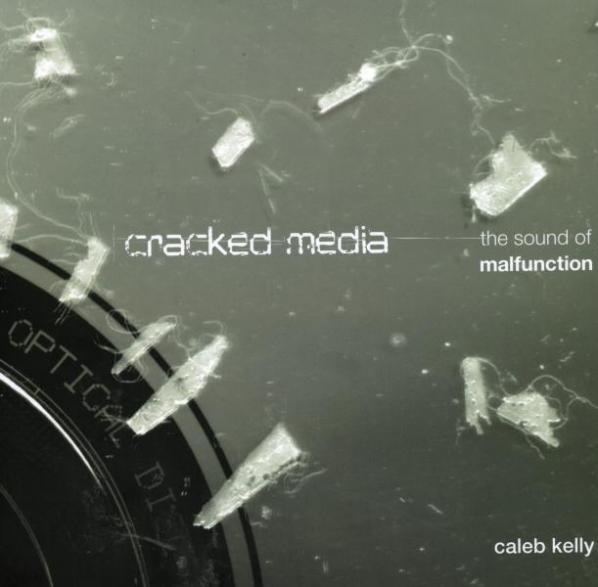
If we are to look at the glitch process, we can say that there is a point of intervention/disturbance upon the media, which is entirely a function of control on the part of the user. Afterwards, it is set loose into the system to allow the corruptions within the media to trigger chance/autonomous operations in its interpretation in the browser, etc. This is where the glitcher straddles the line between control and autonomy, as they manually insert noise into their media (control), then the codecs struggle with the ‘cracked’ media (autonomy). The glitcher, then, has the option to try a new iteration, thereby making the process cybernetic in nature. In Glitch, there is a conversation between the operator, the media and the codec. With the aesthetics created by drones, algorithmic recognition software, and satellite reconstructions, the process is far more autonomous/disjoint, and the New Aestheticist has to deal with this in the construction of their practice.
In the genre that I will call ‘mobEYEle’ imaging, the robot, satellite, or parabolic street eye abstracts from the ‘artist’, aptly turning them into an ‘aestheticist’, as their level of control is defined as that of a gleaner/pattern recognizer from the image bank of Big Data. Rhetorically speaking, we could say that a connection between the aestheticist and the generator of the image would be less abstract if, say, a New Aestheticist were to be in the room with a drone pilot, conversing about points of interest. It is likely that a military remote pilot and a graphic designer would have sharply differing views as to what constitutes a ‘target of interest’. Like that’s going to happen…
Therefore, let us just say that the collaboration of a New Aestheticist and a drone pilot is nightly unlikely, and that the New Aestheticist is therefore abstracted from the decisions of command and control involved in acquiring the image that eventually gets in their hands. This, however, presents us with two levels of autonomous agency, one human and one algotrithmic. But before I expand on this, I would like to discuss my decision to call the practitioner an ‘aestheticist’ as opposed to an artist or curator.
This decision rests on what I feel is the function of the aestheticist, that is, to glean value from an image and ‘ascribe’ an aesthetic to it. This position puts them in a murky locus between artist and curator, as they have elements of neither and both. For example, does the drone-image NA practitioner create the image; are they the artist per se, of the image? No. Although they are more closely aligned to curatorial practice as they collect, filter (to paraphrase Anne-Marie Schleiner), and post on tumblrs and Pinterests? From my perspective, the role of a curator is the suggestion of taste through and informed subjectivity through ecologies of trust and legitimacy, but the social image aggregator, although they might want to perform the same function, has no guarantee of accomplishing this unless they develop a following. Therefore, under my definition, they are neither creators nor taste-makers in the traditional sense, so what makes sense is to call them ‘aggregators’ of aesthetic material and thus my term ‘Aestheticist’.
Returning to our conversation, the drone aestheticist, then, is subject to one of two degrees of completely abstracted autonomy of the creation of the image; that of the operator or that of the algorithms operating the drone. The abstraction surrounding the human operator is easiest to resolve, as the images of interest are either the preference of the drone operator or those created by the operator under the parameters of the mission, and not the results of a New Aestheticist’s joyride on a Global Hawk. It is merely someone else’s volition selecting the image, and a confluence of personal interest deciding as to whether the image deserves to be on the New Aestheticist’s social imaging organ. However, it is the drone’s algorithmic image acquisition system that creates a more alien perspective in regards to aesthetics and autonomy of the image.
Compared to the Algorist or the Glitcher, all loosely placed under the banner of New Aesthetics, the Drone/Big Data Aestheticist is most problematic, as they are a fetishizer of sheer command and control operations that are potentially utterly abstracted from the pilot/driver’s volition. This creates a double abstraction through first the pilot, and then the algorithmic recognition system. There is no cybernetic loop here at all, as the gleaning of the item of interest from the beach of Big Data is twice removed from any feedback potential. Secondly, as I have written before, the Drone Aestheticist is exactly that, a gleaner of interesting images for use on their social image site, which in itself is a bit of an abject exercise.
Or is it? For example, if one is to say that the Aestheticist gleaning the images does so without intent or politics, and is merely operating on fetish/interest value, then this is perhaps one of the least interesting practices in New Aesthetic practice. But on the other hand, if one looks at the work of practitioners like Jordan Crandall, Trevor Paglen, or Ricardo Dominguez, who examine the acquired image as instrument of aggression, control, and oppression, this puts a new lease on the life of the Drone Aesthetic. In a way, though inquiry, there is an indirect feedback loop established in questioning the gaze of the device, its presence, and its function in its theater of operations. The politics of the New Aesthetic emerges here, in asking what mechanisms of command and control guide the machine eye and determine its targets of interest. This is of utmost importance, as the abstracted eye is guided without subjectivity or ethics and is determined solely by the parameters of its algorithms and the stated goals of its functions.
Is the aesthetic of the machine image merely a function of examining its processes, fetishizing its errors, or something else? The criteria of the New Aesthetic attempts to talk about a spectrum of digital imaging that stretches back into time far longer than 2010, and has a problematically broad sense of definition. Once these problems are set aside as a given, one of the key criteria for the evaluation of NA practice and the function of its images depends upon the degree of control and autonomy inherent in the process within the creation of the image. This is formed in a continuum of control and abstraction from Algorism and Generative Art to autonomous eyes like drones and satellites. Algorism is one of the oldest NA practices, and exhibits the closest relationship between artist, machine and determinacy of digital process. A greater degree of indeterminacy is evident in the Glitch, but the iterative process of tweaking the media and then setting it forth into the process of interpretation by the codec, foregrounds the issue of digital autonomy.
The eye of the unmanned platform abstracts creation from the human organism at least once if a human does not operate it remotely, and twice if it is. There is the Terminator-like fear of the autonomous robot, but at this time, perhaps the more salient questions regarding what I have qualified as drone/autonomous aestheticism under NA of what the function of the image is, and is it really that interesting? Are the practices of NA blurring artistic and curatorial practice into a conceptual aestheticism, creating a cool detachment from the image despite its source or method of creation? Is the bottom line to the genres of NA the degree of control that the artist or aestheticist has over the image’s creation or its modality/intent? It seems that NA is an ongoing reflection upon the continuum of control over the generation of the image, our beliefs regarding its aesthetics, and what the intentions or politics are behind the creation of the New Aesthetic image. Or, as I have written before, are we just pinning images from Big Data and saying, “Isn’t that kinda cool?”
Maybe it’s somewhere in the middle of intention and cool.
Scratch is a programming environment that is easy to use and created with children in mind. Create and share your own interactive stories, games, music and art!
Codasign in partnership with Furtherfield will be running two Scratch workshops for children and their parents at Furtherfield Gallery on Saturday 13 April: a morning session with 6-9 year olds (10-12pm) and an afternoon one with 9-12 year olds (1:30-4pm).
Please book your place.
All supporting material for the workshop will be available at learning.codasign.com.
You will design and make a game or animation using the Scratch environment.
You only need to have big ideas – no other experience required.
You need to bring a laptop and an adult. The same adult can accompany multiple children. If you aren’t able to bring a laptop, just let us know by adding a note to your registration or e-mailing info@codasign.com.
There will be drinks available, but you are welcome to bring along some snacks to feed your creativity.
Full refund if registration is cancelled over a week before the course start, 50% if within a week of the course start, and no refund if within 24 hours of the course start.
VISITING INFO
Furtherfield Gallery
McKenzie Pavilion
Finsbury Park, London, N4 2NQ
Scratch is a programming environment that is easy to use and created with children in mind. Create and share your own interactive stories, games, music and art!
MaKey MaKey is a kit that lets you turn anything into a controller. Let your imagination go wild!
Codasign in partnership with Furtherfield will be running two Scratch + MaKey MaKey workshops for children and their parents at Furtherfield Gallery on Sunday 14 April: a morning session with 6-9 year olds (10-12pm) and an afternoon one with 9-12 year olds (1:30-4pm).
Please book your place.
All supporting material for the workshop will be available at learning.codasign.com.
During this workshop, the children will practice using computational thinking and interactive design in creative projects through a variety of activities. The adults will even play a key role in these activities.
You only need to have big ideas – no other experience required.
You need to bring a laptop and an adult. The same adult can accompany multiple children. If you aren’t able to bring a laptop, just let us know by adding a note to your registration or e-mailing info@codasign.com.
There will be drinks available, but you are welcome to bring along some snacks to feed your creativity.
Full refund if registration is cancelled over a week before the course start, 50% if within a week of the course start, and no refund if within 24 hours of the course start.
VISITING INFO
Furtherfield Gallery
McKenzie Pavilion
Finsbury Park, London, N4 2NQ
+ See images of the event on Flickr.
+ Research material from the workshop available here.
+ LONDON SITUATION e-waste Questionnaire: Tell us what you think here!
We have a situation! is a series of live, trans-border, online-offline participatory performances addressing current cross-cultural European issues and concerns. Between March and May 2013 four “situations” will be created in four countries – France, Netherlands, UK and Austria. For the London Situation the focus will be on electronic waste.
A 4 day workshop exploring the problem of e-waste and the creative potential of digital and online technologies, culminating in a networked event on Saturday 23 March for a local and online audience. The event will be streamed live through the UpStage platform with an online discussion about e-waste between Furtherfield Gallery and kunstGarten Graz (AT) at the end of the event.
Live link here
Please contact Alessandra (Furtherfield) for information about times and location.
Ideally participants should be able to take part in the whole process but we welcome anyone who might wish to contribute even just for a few sessions or the final event.
Media artist Tom Keene (Furtherfield) has been setting up the “situation” for the arrival of Helen Varley Jamieson (We Have a Situation! lead artist) and the other project partners. Tom will work with Bright Sparks, a local recycling/fixing/making project, situated in the middle of a housing estate in Islington, not far from where Furtherfield Gallery is located, on researching the topic. Bright Sparks has been working with local people to re-use, repair and recycle electronics & furniture.
The underlying theme that we are planning to explore through the London Situation and that has certainly strong resonance everywhere in Europe as well as worldwide, tackles current issues around the social & economic relationships with material things, and how these alternative counter-economies are evolving alongside the materialistic obsolescence of capitalist consumption.
New EU regulations will soon require member states to collect 45 tonnes of e-waste for every 100 tonnes of electronic goods put on sale during the previous three years, with a target of 4kg of e-waste per person. That’s about 2 million tonnes of e-waste to be collected every year – out of a total of 8 million tonnes generated annually in the EU. Who will be doing this collecting? Who will pay for it? Where and how will the e-waste be recycled? And what happens to the 8 million tonnes not collected for recycling?
We have a situation! is a collaboration between four European arts organisations – APO33 (FR), Furtherfield (UK), MAD emergent art centre (NL), and Schaumbad Freies Atelierhaus Graz (AT) – and two individuals, Helen Varley Jamieson and Martin Eisenbarth. It is funded by the European Cultural Foundation.
FIND OUT MORE
+ For more information about the London Situation and to get involved please contact Alessandra (Furtherfield).
+ More information about this project:
http://www.wehaveasituation.net/
Furtherfield Gallery
McKenzie Pavilion, Finsbury Park
London N4 2NQ
T: +44 (0)20 8802 2827
E: info@furtherfield.org
Scratch is a programming environment that is easy to use and created with children in mind. Create and share your own interactive stories, games, music and art!
MaKey MaKey is a kit that lets you turn anything into a controller. Let your imagination go wild!
Codasign in partnership with Furtherfield will be running two Scratch + MaKey MaKey weekend workshops for children and their parents at Furtherfield Gallery on Saturday 16 and Sunday 17 March: a morning session with 6-9 year olds (10-12pm) and an afternoon one with 9-12 year olds (1:30-4pm).
Please book your place.
All supporting material for the workshop will be available at learning.codasign.com.
During this workshop, the children will practice using computational thinking and interactive design in creative projects through a variety of activities. The adults will even play a key role in these activities.
You only need to have big ideas – no other experience required.
You need to bring a laptop and an adult. The same adult can accompany multiple children. If you aren’t able to bring a laptop, just let us know by adding a note to your registration or e-mailing info@codasign.com.
There will be drinks available, but you are welcome to bring along some snacks to feed your creativity.
Full refund if registration is cancelled over a week before the course start, 50% if within a week of the course start, and no refund if within 24 hours of the course start.
VISITING INFO
Furtherfield Gallery
McKenzie Pavilion
Finsbury Park, London, N4 2NQ
Scratch is a programming environment that is easy to use and created with children in mind. Create and share your own interactive stories, games, music and art!
Codasign in partnership with Furtherfield will be running two Scratch weekend workshops for children and their parents at Furtherfield Gallery on Saturday 09 and Sunday 10 March: a morning session with 6-9 year olds (10-12pm) and an afternoon one with 9-12 year olds (1:30-4pm).
Please book your place.
All supporting material for the workshop will be available at learning.codasign.com.
What will you do and learn?
You will design and make a game or animation using the Scratch environment.
What do you need to already know?
You only need to have big ideas – no other experience required.
What do you need to bring?
You need to bring a laptop and an adult. The same adult can accompany multiple children. If you aren’t able to bring a laptop, just let us know by adding a note to your registration or e-mailing info@codasign.com.
What will be available during the workshop?
There will be drinks available, but you are welcome to bring along some snacks to feed your creativity.
Cancellation Policy
Full refund if registration is cancelled over a week before the course start, 50% if within a week of the course start, and no refund if within 24 hours of the course start.
VISITING INFO
Furtherfield Gallery
McKenzie Pavilion
Finsbury Park, London, N4 2NQ
Scratch is a programming environment that is easy to use and created with children in mind. Create and share your own interactive stories, games, music and art!
MaKey MaKey is a kit that lets you turn anything into a controller. Let your imagination go wild!
Codasign in partnership with Furtherfield will be running two Scratch + MaKey MaKey workshops for children and their parents at Furtherfield Gallery on Saturday 23 February: a morning session with 6-9 year olds (10-12pm) and an afternoon one with 9-12 year olds (1-4pm).
Please book your place.
All supporting material for the workshop will be available at learning.codasign.com.
What will you do and learn?
During this workshop, the children will practice using computational thinking and interactive design in creative projects through a variety of activities. The adults will even play a key role in these activities.
What do you need to already know?
You only need to have big ideas – no other experience required.
What do you need to bring?
You need to bring a laptop and an adult. The same adult can accompany multiple children. If you aren’t able to bring a laptop, just let us know by adding a note to your registration or e-mailing info@codasign.com.
What will be available during the workshop?
There will be drinks available, but you are welcome to bring along some snacks to feed your creativity.
Cancellation Policy
Full refund if registration is cancelled over a week before the course start, 50% if within a week of the course start, and no refund if within 24 hours of the course start.
VISITING INFO
Furtherfield Gallery
McKenzie Pavilion
Finsbury Park, London, N4 2NQ
Featured image: Journey to Ard al Amal (The Land of Hope). Screenshot box & video installation. Impakt festival & exhibition. Image Pieter Kers
Foundland, Ghalia Elsrakbi (SY) and Lauren Alexander (SA), is a multi-disciplinary art and design practice based in Amsterdam. With backgrounds in graphic design, art and writing Foundland’s approach focuses on research based, critical responses to current issues. While moving around in advertising, printed matter, the Internet, and off line art spaces they dig up interesting stories about Disney, SpongeBob and defected soldiers.
Annet Dekker: Where does the name Foundland come from, or what does it mean?
Lauren Alexander: We started working together in 2009 and at the time we had worked on a project about being stateless, so Foundland seemed fitting. It is quite literally a way of thinking about how to found a land and to create a space that we could use as a platform for thinking about ideas with some kind of visual output. For us, space is related to political scenarios, and also to something virtual, online, all these different places that we inhabit.
Ghalia Elsrakbi: Foundland relates also to finding and discovering something new, looking behind something. We are very interested in speculation, we speculate about images and their meaning, in order to find something unexpected.
AD: What is your focus, what are you trying to find and tell?
LA: We want to tell stories in new ways, because by telling a story in a different way, especially related to subjects which are often seen in the media, you are offering an alternative perspective.
GE: The exhibition we just did for Impakt festival is a good example. With the installation Journey to Ard al Amal (The Land of Hope) we speculated how popular characters and animations, dubbed from Japanese to Arabic, or adapted from Walt Disney, play a valuable role in imagining heroes and villains. We were looking at a history of cartoons. This isn’t obviously political, but when seeing how cartoons are used in Syria and other places, interesting issues came up and we constructed a story that reflected on the current situation. We looked for connections between the way people see cartoon characters now and how they are embedded in childhood memories. In the end what we present is a kind of imagined picture of how things could be, maybe as an alternative to watching the news.
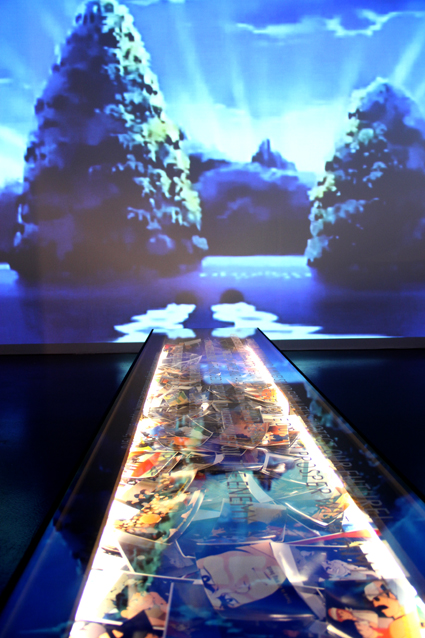
AD: Can you elaborate a bit, what images did you see and how did you (re)use them?
LA: In the installation we focused on this specific case study of the apocalypse scenario which is sketched in a cartoon series called Adnan and Leena in Arabic. In an earlier research essay Simba, the last Prince of Ba’ath country, we extracted images and characters from Arabic websites and speculate on appropriation by showing original images, before they were photoshopped. In a talk we did, we were also drawing connections to the way that Western cartoon characters are suddenly popping up in news footage, and how activists use cartoon identities on the Internet.
GE: Currently there is a full swing of the way Western stories are adapted. For example images of Mickey Mouse or SpongeBob are painted on walls in Syria. In the talk we question whether it is still Mickey Mouse that we see, the one that we remember from our children books, or if it means something else? We compared and related these images to the way such iconography is appropriated and used by both activists and ruling parties. The reuse of symbols and images and how sometimes historical moments are turned into something completely different is very interesting. Such findings are what we are really focusing on.
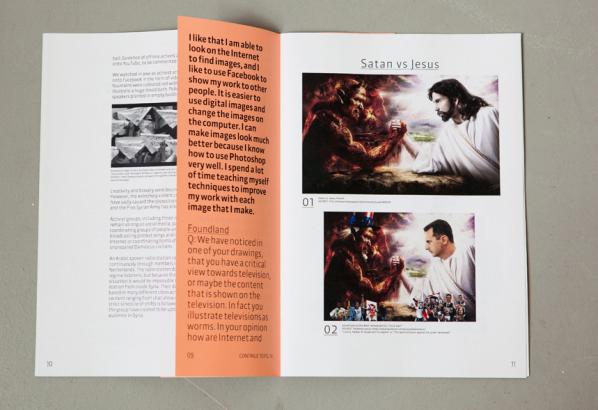
AD: There is also a long and popular tradition of autonomous animation in middle east, how does that relate to what you’ve been researching?
LA: Cartoons are very differently perceived in Syria, and also in South Africa, unlike in the Netherlands, they pose a huge threat to those in charge. For example the government is continuously suing political cartoonists like Ali Farzat in Syria and Zapiro in South Africa because their cartoons undermine existing power structures.
GE: There are indeed many artists who create political cartoons or satirical statements but with these Disney cartoons it was about finding the hidden story of an image. We recognise the cartoons from a Western perspective and the local one. By making connections and telling a different story we want to give a different perspective and a better understanding of what is really happening. Actually I grew up with Japanese Manga, but today Disney is everywhere. This is also political because in the time that Hafez Al-Assad was running Syria there was no American culture at all, when he died his son opened the country a bit for the Western market and you started to see American programmes. Nevertheless, everything is dubbed to Arabic so children don’t necessarily view it as an American production because it speaks their own language and sometimes stories and words are changed in order to better relate to Arabic countries.
LA: The connection to America is not obvious, what we found is that characters like SpongeBob and Mickey Mouse are simply friendly characters. They are your buddy, they help and like you.
GE: That is why they are used in this process of freedom fighting. ‘Your friends’ carrying the freedom flag and are used to create a kind of identification with the message that they want you to see. I mean, it is difficult to hate or not to trust these images because they are icons of friendliness. Whereas the image of a politician or some other hero who is telling a personal story can easily be damaged, a cartoon image is unbreakable. It appeals to children involved in the revolution. So, these images consist of many layers and bring up interesting questions. We aren’t looking for the true answer, because in the end we create our own story.
AD: Could you speak of a sort of universal populism or at least a continuing iconography?
GE: There are many different images, from the Lion and the Father and the Son, to things you see in public space, or images that people grew up with. These are all reused in a digital form and become part of the revolution. People tend to think of them as new images, but when you compare them to older ones, the original, it reflects very much the ideology of the regime. By putting them in a different context we try to force people to question the images and the stories.
LA: I remember that I was in South Africa when we were working on the fiction interview with a propaganda makers text and I had asked my mother to read it. She commented that ‘This is what the government used to say during apartheid, I recognize this’. I guess this shows quite a universal context. We are so used to advertisement and iconography that we don’t question it and tend to ignore the meaning.
GE: Yes, it’s not so different at all, propaganda still uses the same techniques, they have not changed and people fall for it. I think it’s very good to expose propaganda makers.
AD: What new context are you giving it?
LA: Up till now our work has been presented in a western context within the framework of festivals or art spaces.
GE: We wanted to show it to a Western audience, but now we also want to see how it will work when we go to Syria or the Middle East. This will be a challenge because we need to find a way to make that translation back again. We tried already a few times to publish texts for example, but the expectation is very different, stories are more direct and literal, you say exactly what you mean, not the way that we do it here which is reading between the lines.
AD: Is that also why you work in so many ways, from installations, to print, to presentation, to video?
LA: Yes, a lot of this is about experimentation with how things work. We often start from something that we have found online. We find a lot of information, which can be confusing, and then it is about finding the right moment, time and place to present it. Giving it all your attention to dig into an issue, know more and tell more.
GE: Each time we try to define the best way to present what we want to say. It is interesting to open and use the whole research process, it is not just about an end result that is presented. For example, now we are collecting a lot of defection movies from soldiers who are leaving the official army Syrian and joining the free army. What we notice is that the visibility of this free army is that it is only online, on YouTube. We are interested in how an identity of an army that exists on the ground and performs all kinds of operations, primarily takes place on YouTube. The videos of the defectors are almost like a physical performance of defection. We want to collect the story of it, to help people appreciate this image, why it was made, and think about what this means for us.
AD: Digging up memories and confronting people?
GE: When we started the cartoon project we noticed that people were hiding their identity online behind popular cartoon masks. It was really about how people used the Internet.
LA: We discovered that using the Internet is not always about the technical functions of connectivity, distribution, uploading and liking.
GE: If you look for example at how Syrians use the Internet, it’s really for emotional support. A few months ago there was no Internet in the whole of Syria, which was emotionally a big thing because people abroad couldn’t connect to people online and read their contributions. The revolution is nothing without these contacts. All of a sudden a Facebook campaign started called ‘Here is Damascus’. At first I didn’t understand it, but it turned out to be a reference to an event that happened in the 60’s in Cairo, while at war with Israel, the radios were cut off and there was no communication in the city. At that point the city of Damascus changed the name of their radio to ‘Cairo radio’. A political statement, like a re-enactment, happened now on Facebook. The Internet has all these different kinds of layers, of reflecting on history and bringing events to life.
See more Foundland work and updates at www.foundland.info
Featured image: Image from Fab Lab (fabrication laboratory), small-scale workshop offering digital fabrication
There is currently a significant amount of interest in the relationship between free and Open Source practices in art and the aim of this report is to map out some of these shifting relationships in contemporary models of education both online and offline. The recent expansion of so-called ‘free culture’ has contributed to placing the debate over authorship, ownership and licensing of the artwork at the centre of artistic production. Crucially, the transformation of art in the age of global culture and the consequent move from autonomous art objects into cultural artworks and services, has resulted in the emergence of three visible tendencies: 1) free/Open/Source software as artistic-pedagogical method, 2) the critical emancipation of the self-education movement and 3) the digitisation of art education practices into Open Source packages of cognitive labour.
One possible way to navigate this complex ideological terrain is the conciliatory term free/libre/Open Source software (floss), seeing it as “part of an emerging transdisciplinary field that deals with different forms of openness.” [1] At the heart of the debate is the political distinction between the Free Software Foundation[2] and the Open Source Initiative.[3] The ‘copyleft’ attitude (free software movement) asserts four freedoms for software: free from restriction, free to share and copy, free to learn and adapt, free to work with others.[4] The Open Source definition,[5] on the other hand, in spite of apparent similarities, has developed into flexible arrangements such as the Creative Commons licenses[vi][6], some of which restrict these freedoms when applied to media/cultural works and publications, not allowing for derivative artwork or its commercial use under specific license combinations.[7]
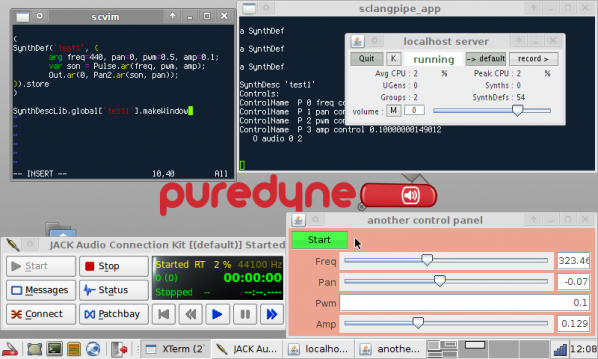
A number of projects, such as the pure:dyne[8] – GNU/Linux operating system for live audio visual processing and teaching – are, however, fully identified with the principles of free software. They have emerged from artists’ collectives whose relationship to art education is informally associated with sharing spaces, the hacklabs and free media labs where they run workshops and introduce participants to the use of free digital art tools. [9] Their mode of production is centred on ‘live code’ and feature two essential characteristics: 1) collaborative- relying on large-scale public participation and 2) distributive- offering the tools and the process notes (notation) to empower the others to carry on the work on their own.[10] This philosophy implies that the artistic performance of the work is complemented by a set of pedagogical approaches associated with the enabling of production by others. [11]

The movement for free education has gained greater relevance as a result of the global financial crisis and the battle for control of university fees.[12] In this context, art education has been developing into an artistic project while also providing an emancipatory movement reacting against dominant forms of institutionalised knowledge production. Within this movement, the role of free/open technology has been central in the mediation of self-education as a social movement.
On the one hand, artists –freelancers, sometimes temporarily/precariously plugged into educational institutions whilst working as teachers, others times as workshop facilitators in free access spaces– have opened up their classrooms to the environment of the read/write web, and with their students-collaborators, have produced and shared in wikis, blogs and Second Life, art and education resources that make an increasingly significant contribution to a larger body of knowledge that is the web. [13] Wikiversity is a model of this confluence of self-education movements and open online education.[14]
In parallel with the above-mentioned tendencies of online systems, numerous critical projects have appeared that are associated with the reclamation of space that occurs as artists have found themselves at the forefront of self-organised and self-managed self-education projects.[15] Some have happened side-by-side with the reclamation and occupation of spaces such as the Temporary School of Thought[16] and the Really Free School.[17] Part of these groups activity is the establishment of a free programme of workshops on topics that can range from free software tools to Ivan Illich and Deschooling Society.[18] Others that make opportunistic incursions into the artworld such as the Bruce High Quality Foundation University,[19] the Future Academy[20] or Unitednationsplaza,[21] are platforms for experimental art as research, investigating the production of knowledge that occurs when art education itself becomes artwork or exhibition.[22]
While the debate on free education has been enjoying significant visibility, the Higher Education sector has also joined in. A few recent initiatives have supported universities of the arts developing virtual learning environments and providing access to open education resources (OERs). This is the case with the JISC Practising Open Education Project (2010-2011)[23] with six art, design and media departments in UK universities. A number of these OERs include art work (photographs, drawings and videos), but the majority are art theory, mostly research papers, dissertations and art education research documents produced by artists-teachers-researchers as part of their continuing professional development. These are distributed with Creative Commons licenses with varying degrees of freedom, but rarely have the ‘copyleft’ attitude that has been associated with the free software.
Such an enterprise can be interpreted in the light of current debates in the fields of immaterial labour and cognitive capitalism revealing that whilst (digital) art becomes postproduction, art education is being packaged into open resources that circulate as part of the capitalist system, and become central to the new eLearning/networked economies. In addition to filling a gap in subject-specific open resources, this raises the question: why is the free and the open so popular in contemporary art education? A cynical hypothesis is that art education, by declaring itself as a type of production of knowledge, attempts to gain a new legitimacy, in the bureaucratised global knowledge market. The other possibility is that in the face of such a doomed scenario, art education searches for new possibilities beyond pure commercialism, reclaiming access through “contingencies of opening and mobility of cognitive packages beyond confines of ownership.” [24]
1. Floss as artistic –pedagogical method
The Digital Artists Handbook
The digital handbook, published by the arts organisation folly and artists’ collective GOTO10 in 2008, aims to give artists information about the available tools and the practicalities related to Free/Libre Open Source Software and Content such as collaborative development and licenses.
FLOSS+Art
This book edited by Aymeric Mansoux and Marloes de Valk in 2008 reflects critically on the growing relationship between Free Software ideology, open content and digital art. With contributions by: Fabianne Balvedi, Florian Cramer, Sher Doruff, Nancy Mauro Flude, Olga Goriunova, Dave Griffiths, Ross Harley, Martin Howse, Shahee Ilyas, Ricardo Lafuente, Ivan Monroy Lopez, Thor Magnusson, Alex McLean, Rhea Myers, Alejandra Maria Perez Nuñez, Eleonora Oreggia, oRx-qX, Julien Ottavi, Michael van Schaik, Femke Snelting, Pedro Soler, Hans Christoph Steiner, Prodromos Tsiavos, Simon Yuill. Available both in print and as torrent download
Technology Will Save Us
The project by Daniel Hirschman & Bethany Koby is a haberdashery for technology and alternative education space dedicated to helping people to produce and not just consume technology.
Openlab
Openlab Workshops was started by artist and educator Evan Raskob in mid-2009 to fulfil the need for practical education about digital art and technology. Floss workshops are developed and taught by working artists and media practitioners, giving participants direct access to practical experience.
GOTO10
GOTO10 is an artists’ collective that organises floss workshops on subjects such as Pure Data, Linux audio tools, physical computing, SuperCollider, puredyne, RFID, Audio Signal Processing, and other related areas of practice.
UpStage
UpStage is an Open Source platform for cyberformance and education: remote performers combine images, animations, audio, web cams, text and drawing in real-time for an online audience. Initiated by the globally dispersed performance troupe Avatar Body Collision, it runs the annual Upstage festival, open to proposals.
2. Self-organised and self-managed art education
Really Free School
Free school based in a squatted London pub. “Amidst the rising fees and mounting pressure for ‘success’, we value knowledge in a different currency; one that everyone can afford to trade. In this school, skills are swapped and information shared, culture cannot be bought or sold. Here is an autonomous space to find each other, to gain momentum, to cross-pollinate ideas and actions.” (Communiqué #1)
Bruce High Quality Foundation University
A free university project set up by NY-based artists’ collective The Bruce High Quality Foundation. “We believe in the artistically educational possibilities of collaboration. Collaboration, as we mean it, means a group of concerned people come together to hash out ideas, try to figure out the world around them, and try to take some agency within its future. That’s the why and how of The Bruce High Quality Foundation. BHQFU is an attempt to extend the benefits of this collaborative model to a wider number of people.”
Unitednationsplaza
A temporary, experimental school in Berlin, initiated by Anton Vidokle following the cancellation of Manifesta 6 on Cyprus, in 2006. Developed in collaboration with Boris Groys, Liam Gillick, Hatasha Sadr Haghighian, Nikolaus Hirsch, Martha Rosler, Walid Raad, Jalal Toufic and Tirdad Zolghadr, the project travelled to Mexico City (2008) and, eventually, to New York City under the name Night School (2008-2009) at the New Museum. Its program was organized around a number of public seminars, most of which are now available in their entirety online.
FOSSter creative Learning
Lesson plans that can be used in the art classroom, developed by The FOSSter Creativity Team, a group of students of the University of the Arts (USA)
3. Open Source Repositories
University of the Arts institutional OER repository
University for the Creative Arts institutional OER repository
VADS (Visual Arts Data Service) A collection of over 100,000 art and design images that are freely available and copyright cleared for use in learning, teaching and research in the UK.
OER Commons A repository of materials about teaching, technology, research in the emerging field of Open Education. Art materials at OER commons.
You can find paula’s original article on Collaboration and Freedom – The World of Free and Open Source Art http://p2pfoundation.net/World_of_Free_and_Open_Source_Art
This article is part of the Furtherfield collection commissioned by Arts Council England for Thinking Digital. 2011
Cyposium
an online symposium on cyberformance
Friday 12th October 2012
http://www.cyposium.net/
We all perform on the Internet. The social media profiles that we are contractually obliged to give our real names to are just as much performances as our World Of Warcraft or Minecraft avatars. Yet these impromptu performances of our socialised and fantasy selves lack the literary quality of drama. Not drama in the sense of a Usenet or Tumblr flamewar, but in the sense of theatre.
The 1993 New Yorker cartoon captioned “On the Internet, nobody knows you’re a dog” identifies two important features of the early public Internet. Firstly it’s a place, somewhere you can get onto. Secondly that place has limited bandwidth for establishing identity and communicating affect. This meant that the Cyberspace of the net became a site for identity play and imagined realities.
As the text-based virtual reality of MOOs gave way to the image-based Palace Chat and then three dimensional AlphaWorld the available bandwidth increased and with it the available ambiguity decreased. Describing a character or a scene or an action with a few words leaves the members of the audience much freer to exercise their own imaginations than seeing it in full motion animation with a high polygon count.
The visual, social and even economic order of virtual worlds and social media have become a more fixed and uncritical embodiment of mass media and the established social order. This has reduced their potential for alterity but it has made them useful representations both of shared reality and shared fantasy that can be used as a stage on which to perform critically, reintroducing the literay against the grain of their unreflective consumption of identity and spectacle.
Throughout this history, from the early 1990s to today, the Internet’s affordances have been used to produce dramatic performance in Cyberspace, “cyberformance”. The problem is we don’t remember this, at least not as clearly as we should. Individually, institutionally, and technologically we have lost our memories of artistically groundbreaking and important performances.
This problem is not unique to cyberformance. All digital art suffers from the decay of digital media and the creeping obsolescence of the hardware that it runs on. Internet art suffers from bitrot, software obsolescence, linkrot, the loss of web pages and sites elsewhere on the net that are connected to the work, and netrot, changes in the protocols used to distribute it.
Above and beyond those problems, cyberformance involves live perfomance. Unique events produced by historical communities at a particular moment using media that will rapidly become obsolete need to be recorded in order to be remembered or at least to be critically re-evaluated later. This creates a second layer of conservation and archiving problems.
Take the example (outside of Cyposium) of Judy Malloy’s “Brown House Kitchen”, a narrative environment created in the LambdaMOO text-based virtual reality. Despite being mentioned in surveys of virtual art in the 1990s, despite being produced with institutional support, and despite being stored on one of the longest-running textual virtual world servers the software objects that made up the work were recycled as part of the normal running of LambdaMOO and are now lost. Many other text-based virtual realities, some specifically designed for dramatic works, are not even online any more. And the protocols used to access them are old, with software to connect to them increasingly not installed by default on newer operating systems. Even those created after the Internet Archive started will not appear in it, as they are not web-based.
I mention LambdaMOO as by chance I was researching text based virtual worlds and performance in the months before Cyposium was announced. One work that was described in the literature but untraceable online was Stephen A. Schrum’s “NetSeduction”. Which Schrum presented and discussed at Cyposium. And the script of the original performance was made available through the Cyposium website. Without Cyposium, these resources would not have been made available.
These contrasting examples drive home just how badly needed Cyposium was. The Internet does enable us to digitise and experience more culture than ever before, but it also erases our memories of the culture that is native to it. And the often highly experimental nature of cyberformance makes it harder to record and remember than almost any other kind of technologically enabled art.
As well as addressing a specific need to recover the history of net performance, Cyposium is an exemplary model for a new kind of online event in the era of Massively Online Open College courses. It performs the function of a symposium or convention online, reducing barriers to access and increasing reach for institutions, speakers and audience members. The Waterwheel Tap software used for most of Cyposium allows side-channels of audience communication, which help to build a sense of place and community and allow the audience to ask (and answer) questions and share knowledge among themselves and with the speakers.
The panel discussions that Waterwheel enabled meant that old and new net performers could discuss each others work in the light of new developments or freshly reconsidered history. And we, the audience, wheoever we were and wherever we were, could watch and learn from this discussion and join in. I am often wary of the word “open”, but there was an intellectual and social generosity and inclusiveness to Cyposium that made it feel like a very open event.
A ripple of excitement went through the mailing lists I subscribe to when Cyposium was announced. Its organizers and line up promised something special, and the event itself didn’t disappoint. To be part of the audience, chatting in text alongside the live streaming video presentations, was to be part of both a welcoming ad hoc conversational community of interest and participating in a key moment in a larger historical conversation.
Cyposium went beyond recovering and presenting the history of online performance. It brought together net performers old and new in productive dialogue in front of an engaged audience and served as an example of a new kind of net native event. Now that the event itself has finished the Cyposium web site serves as an important record of an important aspect of online creativity.
This essay will appear in the forthcoming Cyposium book.
The text of this review is licenced under the Creative Commons BY-SA 3.0 Licence.
First published in Remediating the Social 2012. Editor: Simon Biggs University of Edinburgh. Pages 69-74
—-
The acceleration of technological development in contemporary society has a direct impact on our everyday lives as our behaviours and relationships are modified via our interactions with digital technology. As artists, we have adapted to the complexities of contemporary information and communication systems, initiating different forms of creative, network production. At the same time we live with and respond to concerns about anthropogenic climate change and the economic crisis. As we explore the possibilities of creative agency that digital networks and social media offer, we need to ask ourselves about the role of artists in the larger conversation. What part do we play in the evolving techno-consumerist landscape which is shown to play on our desire for intimacy and community while actually isolating us from each other. (Turkle 2011) Commercial interests control our channels of communication through their interfaces, infrastructures and contracts. As Geert Lovink says ‘We see social media further accelerating the McLifestyle, while at the same time presenting itself as a channel to relieve the tension piling up in our comfort prisons.’ (2012: 44)
Many contemporary artists who take the networks of the digital information age as their medium, work directly with the hardware, algorithms and databases of digital networks themselves and the systems of power that engage them. Inspired by network metaphors and processes, they also craft new forms of intervention, collaboration, participation and interaction (between human and other living beings, systems and machines) in the development of the meaning and aesthetics of their work. This develops in them a sensitivity or alertness to the diverse, world-forming properties of the art-tech imaginary: material, social and political. By sharing their processes and tools with artists, and audiences alike they hack and reclaim the contexts in which culture is created.
This essay draws on programmes initiated by Furtherfield, an online community, co-founded by the authors in 1997. Furtherfield also runs a public gallery and social space in the heart of Finsbury Park, North London. The authors are both artists and curators who have worked with others in networks since the mid 90s, as the Internet developed as a public space you could publish to; a platform for creation, distribution, remix, critique and resistance.
Here we outline two Furtherfield programmes in order to reflect on the ways in which collaborative networked practices are especially suited to engage these questions. Firstly the DIWO (Do It With Others) series (since 2007) of Email Art and co-curation projects that explored how de-centralised, co-creation processes in digital networks could (at once) facilitate artistic collaboration and disrupt dominant and constricting art-world systems. Secondly the Media Art Ecologies programme (since 2009) which, in the context of economic and environmental collapse, sets out to contribute to the construction of alternative infrastructures and visions of prosperity. We aim to show how collaboration and the distribution of creative capital was modeled through DIWO and underpinned the development of a series of projects, exhibitions and interventions that explore what form an ecological art might take in the network age.
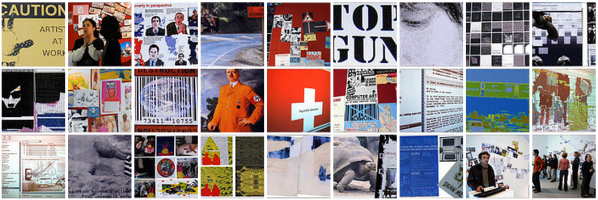
In common with many other network-aware artists the authors are both originators and participants in experimental platforms and infrastructures through processes of collaboration, participation, remix and context hacking. As artists working in network culture we work between individual, coordinated, collaborative and collective practices of expression, transmission and reception. These resonate with political and ethical questions about how people can best organise themselves now and in the future in the context of contemporary economic and environmental crisis.
Though this essay draws primarily on artistic and curatorial practices it also makes connections with the histories and theories that have informed its development: attending to the nature of co-evolving, interdependent entities (human and non-human) and conditions, for the healthy evolution and survival of our species (Bateson 1972); producing diverse (hierarchy dissolving) social ecologies that disarm systems of dominance (Bookchin 1991, 2004); and seeking new forms of prosperity, building social and community capital and resilience as an alternative to unsustainable economic growth. (Bauwens 2005) (Jackson 2009)
Furtherfield’s mission is to explore, through creative and critical engagement, practices in art and technology where people are inspired and enabled to become active co-creators of their cultures and societies. We aim to co-create critical art contexts which connect with contemporary audiences providing innovative, engaging and inclusive digital and physical spaces for appreciating and participating in practices in art, technology and social change.
The following artworks, researched, commissioned and exhibited by Furtherfield this year, offer a range of practices exemplifying this approach. A Crowded Apocalypse [1] by IOCOSE deploys crowd-sourced workers in the production of staged, one-person protests (around the world) against collectively produced, but fictional, conspiracies. This is a net art project that exploits crowd sourcing tools to simulate a global conspiracy. The work exploits the fertility of network culture as a ground for conspiracy theories which, in common with many advertisements, are persuasive but are neither ultimately provable or irrefutable (Garrett 2012).
A series of distributed performances called Make-Shift, by Helen Varley Jamieson and Paula Crutchlow, is a collective narrative about the human role in environmental stresses, developed with participants who build props for the ‘show’ using all the plastic waste they have produced that day. Makeshift is an ‘intimate networked performance that speaks about the fragile connectivity of human and ecological relationships. The performance takes place simultaneously in two separate houses that are connected through a specially designed online interface.’ [2]
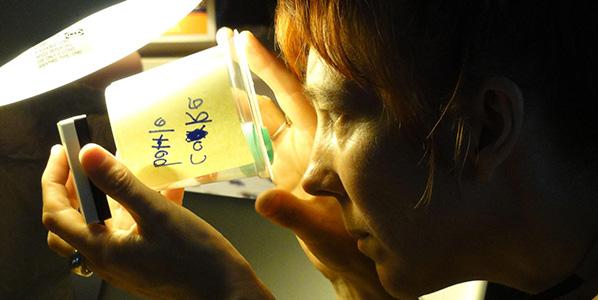
Moving Forest London 2012 [3], initiated by AKA the Castle (coordinated by Shu Lea Cheang), employs the city of London as it prepares for the grand spectacle of the 2012 Olympic Games, expanding the last 12 minutes of Kurosawa’s adaptation of Shakespeare’s Macbeth “Throne of Blood” (1957), with a prelude of 12 days, and durational performance of 6 acts in 12 hours. The Hexists (artists Rachel Baker and Kayle Brandon) perform Act 0 of this sonic performance saga, with 3 Keys – The River Oracle, a game of chance and divination [4].
Other notable works in this vein include Embroidered Digital Commons [5] by Ele Carpenter; Invisible Airs and Data Entry [6] by Yoha; Web2.0 Suicide Machine [7] by _moddr_ and Fresco Gamba; The Status Project [8] by Heath Bunting; and Tate a Tate [9], an interventionist sound work by Platform, infiltrating one of the largest art brands of the nation using a series of audio artworks distributed to passengers on Thames River boats, to protest the ongoing sponsorship of Tate Modern exhibitions by British Petroleum. Also relevant is the realm of ludic digital art practices that facilitate new socially engaged aesthetics and values such as Germination X [10] by FO.AM and Naked on Pluto [11] by Dave Griffiths, Marloes de Valk, Aymeric Mansoux.
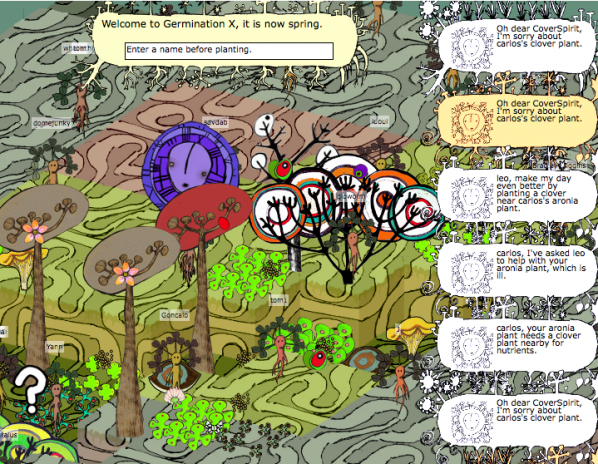
The term “DIWO (Do It With Others)” was first defined in 2006 on Furtherfield’s collaborative project Rosalind – Upstart New Media Art Lexicon (since 2004) [12]. It extended the DIY (Do It Yourself) ethos of early (self-proclaimed) ‘net art heroes’, who taught themselves to navigate the web and develop tactics that intervened in its developing cultures.
The word “art” can conjure up a vision of objects in an art gallery, showroom or museum, that can be perceived as reinforcing the values and machinations of the victors of history as leisure objects for elite entertainment, distraction and/or decoration – or the narcissistic expression of an isolated self-regarding individual. DIWO was proposed as a contemporary way of collaborating and exploiting the advantages of living in the Internet age that connected with the many art worlds that diverge from the market of commoditised objects – a network enabled art practice, drawing on everyday experience of many connected, open and distributed creative beings.
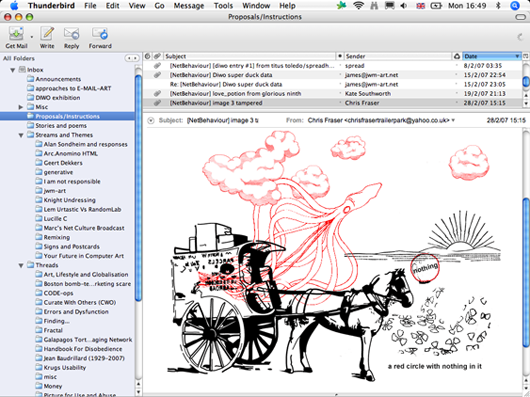
Mail box showing Netbehaviour contributions to DIWO Email Art project 2007
DIWO formed as an Email Art project with an open-call to the email list Netbehaviour, on the 1st of February 2007. In an art world largely dominated by elite, closed networks and gatekeeping curators and gallerists, Mail Art has long been used by artists to bypass curatorial restrictions for an imaginative exchange on their own terms.
Peers connect, communicate and collaborate, creating controversies, structures and a shared grass roots culture, through both digital online networks and physical environments. Strongly influenced by Mail Art projects of the 60s, 70s and 80s demonstrated by Fluxus artists’ with a common disregard for the distinctions of ‘high’ and ‘low’ art and a disdain for what they saw as the elitist gate-keeping of the ‘high’ art world…’ [13]
The co-curated exhibition of every contribution opened at the beginning of March at HTTP Gallery [14] and every post to the list, until 1st April, was considered an artwork – or part of a larger, collective artwork – for the DIWO project. Participants worked ‘across time zones and geographic and cultural distances with digital images, audio, text, code and software. They worked to create streams of art-data, art-surveillance, instructions and proposals in relay, producing multiple threads and mash-ups. (Catlow and Garrett, 2008)
‘The purpose of mail art, an activity shared by many artists throughout the world, is to establish an aesthetical communication between artists and common people in every corner of the globe, to divulge their work outside the structures of the art market and outside the traditional venues and institutions: a free communication in which words and signs, texts and colours act like instruments for a direct and immediate interaction.’ (Parmesani 1977)
So it made sense that the first DIWO project should be a mail art project that utilised email, enabled by the Internet; a public space with which anyone with access to a computer and a telephone line could use to publish. Because an email could be distributed (with attachments or links) to the inboxes of anyone subscribed to the Netbehaviour email list, subscribers’ inboxes became a distributed site of exhibition and collaborative art activity: such as correspondence, instruction, code poetry, software experiments, remote choreography, remixing and tool sharing.
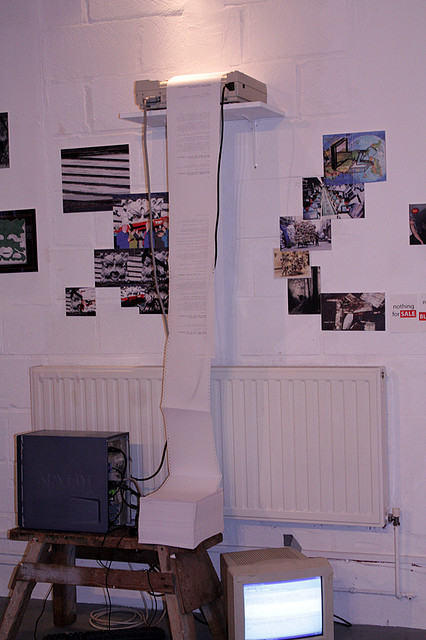
This and later DIWO projects used both email and snail-mail and (in line with the Mail Art tradition) undertook the challenge of exhibiting every contribution in a gallery setting.
The DIWO Email art project was liberally interspersed with off-topic discussions, tangents and conversational splurges, so one challenge for the co-curators was to reveal the currents of meaning and the emerging themes within the torrents of different kinds of data, processes and behaviour. Another challenge was to find a way to convey the insider’s – that is the sender’s and the recipient’s – experience of the work. These works were made with a collective recipient in mind; subscribers to the Netbehaviour mailing list. This is a diverse group of people; artists, musicians, poets, thinkers and programmers (ranging from new-comers to old-hands) with varying familiarity with and interest in different aspects of netiquette and the rules of exchange and collaboration. This is reflected in the range of approaches, interactions and content produced.
In a number of important ways the email inbox guarantees a particular kind of freedom for the DIWO art context, as distinct from the exchange facilitated by the ubiquitous sociability, ‘sharing’ and ‘friendship’ offered by contemporary social media. Facebook, Myspace, Google+, etc, provide interfaces that are designed to elicit commercially valuable meta-data from their users. They are centrally controlled, designed to attract and gather the attention of its users in one place in order to monitor, process and interpret social behaviour and feed it to advertisers. As demonstrated during the disturbances of the Summer of 2011, these social media are an extension of the Panoptican and can also become tools of state surveillance and punishment as Terry Balson discovered on being detained for 2 years after being found guilty of setting up a Facebook page in order to encourage people to riot. (BBC News, 2012)
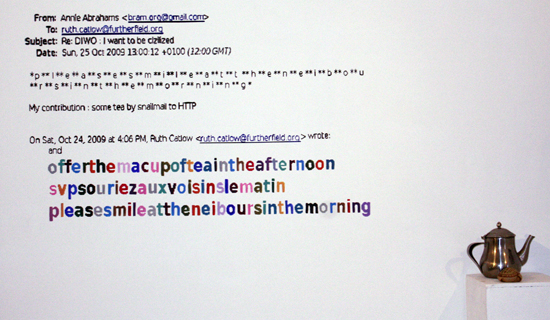
The DIWO Email Art and co-curation project is fully described and documented elsewhere [15] but it is outlined here as it gives an example of how our networked communities may intersect with everyday experience and with mainstream art worlds while also creating their own art contexts. We may be playful, critical, political and may work as possible co-creators with all the materials (stuff, ideas, processes, entities – beings and institutions – and environments) of life. This DIWO approach provides the fundamental ethos for the Furtherfield Media Art Ecologies programme.
Furtherfield’s Media Art Ecologies programme (since 2009) brings together artists and activists, thinkers and doers from a wider community, whose practices address the interrelation of technological and natural processes: beings and things, individuals and multitudes, matter and patterns. These people take an ecological approach that challenges growth economics and techno-consumerism and attends to the nature of co-evolving, interdependent entities and conditions. They activate networks (digital, social, physical) to work with ecological themes and free and open processes.
The programme has included exhibitions such as Feral Trade Café by Kate Rich and If Not You Not Me by Annie Abrahams, an art world intervention by the authors We Won’t Fly For Art and workshop programmes such as Zero Dollar Laptop workshops (in partnership with Access Space in Sheffield). It has supported research projects such as Telematic Dining by Pollie Barden and developmental artist residencies, such as Make-Shift by Helen Varley Jamieson and Paula Crutchlow.
These projects and practices have a number of things in common:
Through the Internet we all now have access to data about historic and contemporary carbon emissions. We also find visualisations of this data that provide concise and accessible graphical arguments for thinking, feeling and acting in a coordinated way at this historical moment [17] [18].
Data shows an exponential rise in global carbon emissions since the 1850s, starting with the UK. UK carbon emissions have dropped as a percentage of global emissions by region (CDIAC 2010). At the same time the quantity of carbon dioxide emitted by the UK has steadily increased since the start of the industrial revolution to annual levels now higher than 500 million tonnes (Marland, Boden and Andres 2008). This data shows how successful the UK was, during the industrial revolution, at spreading the production methods that would turn out to promote a model of sole reliance on economic growth and fossil fuels. The logic and infrastructures of capitalism are now collapsing in tandem with the environment (Jackson 2009). At the same time networked technologies and behaviours are proliferating. Social and economic transactions take place at increased speed but our existing economic and social models are unsustainable and the consequences of continuing along the current path appear catastrophic for the human species (Jackson 2009). This is a critical moment to reflect on how the technologies we invent and distribute will form our future world.
Michel Bauwens, of the Foundation for Peer to Peer Alternatives, works with a network of theorists, activists, scientists and philosophers to develop ideas and processes to move beyond the pure logic of economic growth [19]. He observes that by transposing what has been learned by sharing the production and use of immaterial goods, such as software, with strategies for developing sharing in other productive modes, the community comes to own its own innovations, rather than corporations. This puts peer production at the core of civil society. The fabrication laboratory or ‘fab lab’ system, developed at MIT in collaboration with the Grassroots Invention Group and the Center for Bits and Atoms, offers an example; a small-scale workshop that facilitates personal fabrication of objects including technology-enabled products normally associated with mass production. The lab comprises a collection of computer controlled tools that can work at different scales with various materials. Early work on the Open Source car shows how open, distributed design and manufacturing points to a possible end of patenting and built in obsolescence; constituent principles of our unsustainable consumer-based society. (Bauwens 2012)
‘[Bauwens] recognises that peer to peer production is currently dependent on capitalism (companies such as IBM invest huge percentages of their budgets into the development of Free and Open Source Software) but observes that history suggests a process whereby it might be possible to break free from this embrace. He suggests that by breaking the Free Software orthodoxy it would be possible to build a system of guild communities to support the expansion of mission oriented, benefit-driven co-ops whose innovations are only shared freely with people contributing to the commons. In the transition to intrinsically motivated, mass production of the commons, for-profit companies would pay to benefit from these innovations.’ (Catlow 2011)
A peer to peer infrastructure requires the following set of political, practical, social, ethical and cultural qualities: distribution of governance and access to the productive tools that comprise the ‘fixed’ capital of the age (e.g. computing devices); information and communication systems which allow for autonomous communication in many media (text, image, sound) between cooperating agents; software for autonomous global cooperation (wikis, blogs etc); legal infrastructure that enables the creation and protection of use value and, crucially to Bauwens’s P2P alternatives project, protects it from private appropriation; and, finally, the mass diffusion of human intellect through interaction with different ways of feeling, being, knowing and exposure to different value constellations. (Bauwens 2005)
These developments in peer to peer culture provide a backdrop to the projects presented as part of the Media Art Ecologies programme which, in turn, proposes that a focus on the networked cultures in which the work is produced, supports ecological ways of thinking, privileging attention to complex and dynamic interaction, connectedness and interplay between artist viewer/participant and distributed materials. Its projects have been developed within independent communities of artists, technologists and activists, theorists and practitioners centered around Furtherfield in London (and internationally, online), Cube Microplex in Bristol and Access Space in Sheffield. They identify the simultaneous collapse of the financial markets and the natural environment as intrinsically linked with human uses of, and relationships with, technology. They take contemporary cultural infrastructures (institutional and technical), their systems and protocols, as the materials and context for artistic production in the form of critical play, investigation and manipulation. This work, at the intersection of artistic and technical cultures, generates alternative spaces and new perspectives; alternative to those produced by (on the one hand) established ‘high’ art-world markets and institutions and (on the other) the network of ubiquitous user owned devices and social apps. These practices play within and across contemporary networks (digital, social and physical), disrupting business as usual and the embedded habits and attitudes of techno-consumerism.
We will end this essay by describing an early project developed as part of this programme, Feral Trade Café [20] by Kate Rich, an exhibition that was also a working café. Feral Trade Café served food and drink traded over social networks for 8 weeks in the Summer of 2009 and exhibited a retrospective display of Feral Trade goods alongside ingredient transit maps, video, bespoke food packaging and other artifacts from the Feral Trade network. Since 2003 participants in the project (usually travelling artists and curators) have acted as couriers, carrying edible produce around the world with them on trips they are taking anyway and delivering them to depots (friends’ and colleagues’ flats or workplaces), mostly independent art venues in Europe and North America. Rich has crafted a database through which couriers can log their journeys, tracking the details of sources, shipping and handling for all groceries in the network ‘with a micro-attention usually paid to ingredient listings’ (Catlow 2009). This database [21] is at the heart of the artwork, with special attention given to the day to day challenges and obstacles met in its distribution – tracking the on-the-fly street level tactics employed, out of necessity, by a distribution network with no staff, vehicles, storage facilities or business plan.
‘Courier Report FER-1491 DISPATCHED: 13/05/09 DELIVERED: 15/05/09 – ali jones spent a few hours trying to start a car using various techniques. eventually got it moving with a push start with the help of a stranger who was leaving behind a night of print-making.convoyed to cube where friend took parcel in her van while i parked dubious car at garage for fixing.’ [21] (Feral Trade Courier, 2009)

The café stocked and served a selection of Feral Trade products from a menu including coffee from El Salvador, hot chocolate from Mexico and sweets from Montenegro, as well as locally sourced bread, cake, vegetables and herbs. Diverse diners – local residents and long-distance lorry drivers (from Poland and Germany) – were served their food along with waybills (drawing information from the database) documenting the socially facilitated transit of goods to their plate.
The invitation to the exhibition promised visitors a convivial setting from which to “contemplate broader changes to our climate and economies, where conventional supply chains (for food delivery and cultural funding) could go belly up.” The café provided a local trading station and depot for the Feral Trade network, and a meeting place for local community food activists for research and discussion. It’s worth noting that a year later a Government Spending Review announced a cut of nearly 30% to the Arts Council of England’s budget. (BBC News 2010) Two years later global food prices were up by over 40% and set to rise another 30% in the next 10 years. (Neate 2011). A number of small new projects continue to develop from meetings between the gallery community and local community activist groups working on sustainability issues.
The materials and methods employed by this artwork, that is also a functioning café, are diverse and non-standard. The café is not scaleable and generates no jobs or surplus, let alone profit. It may build ‘social capital’, what Bordieu defines as a form of capital ‘made up of social obligations (‘connections’) which is convertible in certain conditions into economic capital and may be institutionalised in the form of a title of nobility.’ (Bordieu1986) However, it is uncertain whether this will apply to Rich as any ‘nobility’ she might acquire is undermined by her purposeful maintenance of the project’s ambiguous status as an artistic project.
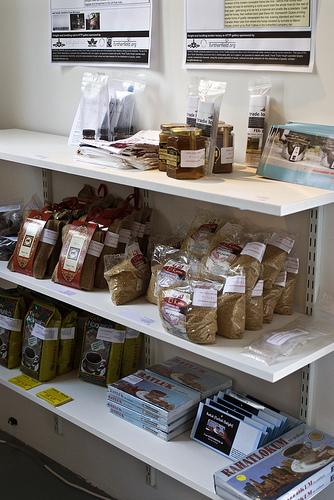
For this essay we present Feral Trade Café alongside Bauwens’ proposal for alternative P2P infrastructures. We propose that while the work is not a design, formula or practical, alternative business model (either for an artwork or a café) for mass adoption, it can be considered an ecological system for ‘mass diffusion of intellect’ (Bauwens 2005). Interaction with the project engages participants in different ways of sensing, operating and valuing the world. It is a most inefficient way of trading.
The work poses strange questions as it oscillates between artwork (sensual, expressive, rhetorical) and catering (utilitarian, literally nourishing) and to consider the meaning of our lives and vocations in local communities and a functional future society. ‘Understanding that prosperity consists in part in our capabilities to participate in the life of society demands that attention is paid to the underlying human and social resources required for this task.’ (Jackson 2009: 182) Feral Trade focuses our attention on the truly pleasurable aspects of social exchange that are lost in our quest for affluence. ‘Creating resilient social communities is particularly important in the face of economic shocks.[…] The strength of a community can make the difference between disaster and triumph in the face of economic collapse.’ (Jackson 2009: 182)
Feral Trade is both art and a lived, alternative co-created system for trading and serving food that refuses commercial exploitation, contributes meaning and strengthens bonds across an existing community. A distinctive, memorable and sensual way for people to interact, to socialise and savour the socio-political ingredients of a meal eaten while discussing strategies for avoiding ethical discomfort. Most powerfully, it is a lived critique and reinvention of a fundamental aspect of everyday life (feeding ourselves) through the subtle tactics of manipulation and play (by its many participants).
It is our contention that by engaging with these kinds of projects, the artists, viewers and participants involved become less efficient users and consumers of given informational and material domains as they turn their efforts to new playful forms of exchange. These projects make real decentralised, growth-resistant infrastructures in which alternative worlds start to be articulated and produced as participants share and exchange new knowledge and subjective experiences provoked by the work.
Conclusion – Ecological Media Art promotes participation in social ecology
Social scientist Tim Jackson has shown that the establishment of ever more efficient and productive systems of control and growth, owned by fewer, more centralised agents, is both unjust and environmentally unsustainable (2009). The reverse also applies; that the distribution of freedoms and access to sustenance, knowledge, tools, diverse experience and values improves the resilience of both our social and environmental ecologies. (Bateson 1972) (Bookchin 1991) (Jackson 2009)
Ecological media artworks turn our attention as creators, viewers and participants to connectedness and free interplay between (human and non-human) entities and conditions. It builds on the DIWO ethos. On the one hand we resist the elitist values and infrastructures of the mainstream art world and develop our own art context, on our own terms, according to the priorities of a collaborating community of creative producers (which may include diverse participants and audiences). On the other, we deal critically with the monitored and centrally deployed and controlled interfaces of corporate owned social media; wherever possible working with Free and Open Source Software to privilege commons-based peer produced artworks, tools, media and infrastructure.
Humanity needs new strategies for social and material renewal and to develop more diverse and lively ecologies of ideas, occupations and values. For this to happen more of us need to be able to freely participate more deeply in diverse artistic or poetic and technical world-forming processes and to exchange what we create and learn.
‘Those who share our ‘analysis of the contemporary political moment may also perceive a possible role for themselves in the generation of mutual commons-based interfaces for engagement that go beyond solely textual formats to arrays of performance, narrative (fact and fiction), image, sound, database, algorithm, music, theory, sculpture – to explicitly re-conceive inalienable social relations’ (Catlow 2011)[23].
Remediating the Social 2012. Editor: Simon Biggs University of Edinburgh. Published by Electronic Literature as a Model for Creativity and Innovation in Practice, University of Bergen, Department of Linguistic, Literary and Aesthetic Studies PO Box 7805, 5020 Bergen, Norway.
Book is available for download as PDF in a full version suitable for print or screen reading (14mb) and a somewhat smaller file size screen-only version (11mb) http://www.elmcip.net/story/remediating-social-e-book-released
Bateson, G., 1972. Steps to an Ecology of Mind University of Chicago and London: Chicago Press
Bauwens, 2005. The political economy of peer production. Available [online] at http://www.informatik.uni-leipzig.de/~graebe/Texte/Bauwens-06.pdf [Accessed 28th June 2012]
Bauwens, 2012. Blueprint for P2P Society: The Partner State & Ethical Economy. Shareable. Available [online] at http://www.shareable.net/blog/a-blueprint-for-p2p-institutions-the-partner-state-and-the-ethical-economy-0 [Accessed 28th June 2012]
BBC News, 2010. Arts Council’s budget cut by 30%. 20 October 2010 Last updated at 17:40. Available [online] at: http://www.bbc.co.uk/news/entertainment-arts-11582070 [Accessed 20th December 2011]
BBC News, 2012. Facebook riots page man Terry Balson detained. 8 May 2012 Last updated at 19:57. Available [online] at: http://www.bbc.co.uk/news/entertainment-arts-11582070 [Accessed 28th June 2012]
Bookchin, M., 1991. The Ecology of Freedom. The emergence and dissolution of hierarchy. Montreal, New York: Black Rose Books.
Bookchin, M., 2004. Post- Scarcity Anarchism. Edinburgh, Oakland, West Virginia: AK Press.
Bordieu, P., 1986. The Forms of Capital. English version first published in Richardson J.G., 1986. Handbook for Theory and Research for the Sociology of Education, pp. 241–258. Available [online] at http://www.marxists.org/reference/subject/philosophy/works/fr/bourdieu-forms-capital.htm [Accessed 29th June 2012]
Catlow, R., and Garrett, G., 2008. Do It With Others (DIWO) – E-Mail Art in Context. Vague Terrain. Available [online] at http://vagueterrain.net/journal11/furtherfield/01 [Accessed 26th June 2011]
Catlow, R., 2009. Ecologies of Sustenance. Catalogue essay for Feral Trade Café – an exhibition that was also a working café by Kate Rich. 13 June – 2 Aug 2009, HTTP Gallery. Furtherfield, London.
Catlow, R., 2011. Re-rooting digital culture at ISEA 2011. Available [online] at http://www.furtherfield.org/blog/ruth-catlow/re-rooting-digital-culture-isea-2011 [Accessed 28th June 2012]
Catlow, R., 2012. We Won’t Fly For Art: Media Art Ecologies. Culture Machine, Paying Attention, July 2012
CDIAC, Carbon Dioxide Information Analysis Center, 2010. Fossil Fuel CO2 Emissions. Columbia University. Available [online] at http://www.columbia.edu/~mhs119/Emissions/Emis_moreFigs [Accessed 26th June 2012].
Feral Trade Courier, 2009. Import, export database created by artist Kate Rich. Available [online] at http://www.feraltrade.org [Accessed 26th June 2012]
Garrett M., 2012. CROWDSOURCING A CONSPIRACY an Interview with IOCOSE. Available [online] at http://www.andfestival.org.uk/blog/iocose-garrett-interview-furtherfield [Accessed 28th June 2012]
Garrett M., 2012. Heath Bunting, The Status Project & The Netopticon Available [online] at http://www.furtherfield.org/features/articles/heath-bunting-status-project-netopticon [Accessed 28th June 2012]
Jackson, T., 2009. Prosperity Without Growth, Economics for a Finite Planet. London: Earthscan
Lovink, G., 2012. Networks Without a Cause. A Critique of Social Media. University of Amsterdam, The Netherlands.
Marland, G., T.A. Boden, and R.J. Andres. 2008. Global, Regional, and National Fossil Fuel CO2 Emissions. In Trends: A Compendium of Data on Global Change. Carbon Dioxide Information Analysis Center, Oak Ridge National Laboratory, U.S. Department of Energy, Oak Ridge, Tenn., U.S.A.
Neate, R., 2011. Food price explosion ‘will devastate the world’s poor’. Guardian, Friday 17 June 2011 18.42 BST. Available [online] at http://www.guardian.co.uk/environment/2011/jun/17/global-food-prices-increase-united-nations [Accessed 20th December 2011]
Parmesani, L., 1997. Poesia visiva, in L’arte del secolo – Movimenti, teorie, scuole e tendenze 1900-2000 . Giò Marconi – Skira, Milan 1997
Turkle, S., 2011. Alone Together: Why We Expect More from Technology and Less from Each Other. Basic Books
It has been almost five years since Roger Bernat, a renowned artist of the experimental theatre scene of Barcelona, premiered ‘Public Domain’. The piece, still on tour, has been performed in public spaces around the world. This audience-centred show invites individuals to participate in this engaging experience that emerges as a sociological choreography. The audience gathers in a public square and they are given a pair of headphones. Nothing warns that a performance is about to take place despite the two signs located at the edges of the square that mark the right and the left. Through this simple but effective setting the piece starts. Welcoming words and introductory instructions are broadcasted to the audiences that immediately understand that the action will be mediated by the voice that is talking to them through the headphones. ‘Would you mind if I ask you some questions’― inquiries the voice. ‘Did you come alone because someone recommended the piece to you? If so go right. Did you come on your own initiative? Go left. Did you go to the play due to work related reasons? Go to the centre. Do you think there are questions that should never be asked? Put your hand in your mouth. Do you call home the place where you live? Put your hands together on your head.’ Through this mechanism, wrapped in the relative anonymity that the group offers, the audience reveals details of their intimacy or of their fictionalized intimacy. Are there supermarkets stealers among the audience members? Have they ever followed strangers? Did they study in public or private schools? Thus, the piece explores bodily narratives playing with the sociological aspects that the audience reveals through their answers.
The development of the piece is constructed through questions that trigger the actions and drag participants into an immersive experience. Groups among the audience members are created and what starts as an entertaining proposal turns into a reflective exercise that interrogates our opinions, beliefs and experiences. Some members of the audience are on our side while others become our enemies; and then war bursts. The piece never loses its playful side although participants become aware of how the categorised distribution of individuals, without nuances, leads to a situation of confrontation. This is of course a simulation, but is this piece a transduction of reality? The theorist Shannon Jackson calls these pieces ‘social works’[i]. From her point of view, these pieces state some of the paradoxes of our systems and as experiments they contribute to discuss the nature of our public engagement. They unfold some of the contradictions of the agencies that operate in our systems while they give evidence of the relational parameters that we assume and accept to construct our social beings. In this case, the sample of audience members is taken as a small sociological study that through continuous dichotomies performs organisation and operation.
The emergence participatory theatre and performance has brought significant changes that basically related to the fact that the audience members have become the raw material of the piece. This change clearly alludes to the aim of artists to incorporate innovate disruptive actions to discuss the matters affecting the current social arena. As Claire Bishop states, there are also tensions that emerge within the performance of these works; ‘quality and equality, singular and collective authorship, and the ongoing struggle to find artistic equivalents for political positions’[ii]. From my point of view, most of these tensions appear due to the game-work nature of these pieces. In a way, labour structures are enacted through instructions that often reproduce some of the basic rules of capitalism; the use bodies to make the system work. To which extent these practices subvert the traditional working relations? Is participation a necessary tyranny for creators to produce social changes? What are the affects and effects of these practices?
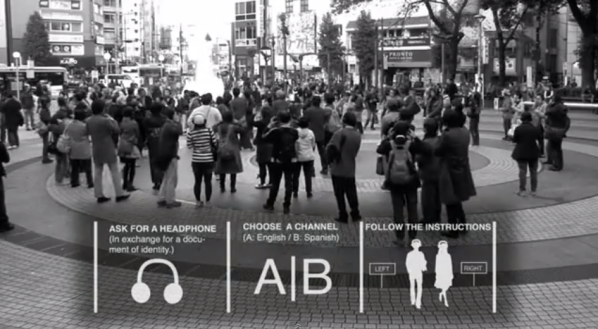
‘Public Domain’ also creates an appealing mobile bodily landscape. It is interesting to think about the relationship between the show and reality. The theatricality of the piece interacts with the social reality blurring boundaries, as one is part of the other. The piece is a social event that occurs outside the convention of a gallery, exhibition space or theatre. Thus, the citizens that are not part of the show assume this theatrical intervention as part of their reality, as part of the current social matters. The integration of technologies into the arts have widely contributed to perform new experiential practices. In this regard, technology plays an important role in triggering participation. Technology helps to distribute and operate instructions but also produce a specific aesthetics that appears thanks to the creation of hybrid practices.
The interaction among disciplines and fields has given birth to fruitful collaborations and cutting-edge practices in the arts. The current convergence of the fields of nanotechnology, cognitive science, biotechnology and communications (ITC) has given birth to the most prolific period of inventions and findings in the history of science. The possible intersections between the arts and sciences are gaining day by day a bigger interest but most of its potential is yet to be imagined. In which ways will these practices will contribute to social change? Is participation the key for a major public commitment in matters that affect our daily lives? ‘Public Domain’ proves that through a rather simple system significant concerns can be addressed in a playful but effective manner in a project that has already engaged audiences from over the world.
Roger Bernat – After studying architecture, he discovered theatre and at the age of 25 he entered the Institut del Teatre in Barcelona to study directing and dramaturgy. Soon after, he founded and directed, with Tomàs Aragay, the company General Elèctrica. Well known in Catalonia for their daring and engaged projects, General Elèctrica (1997-2001) created a dozen remarkable productions. Roger Bernat often concentrates on a variety of social groups (heroes, transsexuals, cab drivers, etc.) in his ongoing search for new theatrical forms. His best-known plays include Que algú em tapi la boca (2001), Bona gent (2003) in collaboration with Juan Navarro, Amnèsia de fuga (2004), LA LA LA LA (2004), Tot és perfecte (2005) and Das Paradies Experiment (2007). Apart from his stage work, Roger Bernat also directs videos. http://rogerbernat.info/en/
Part of Furtherfield Open Spots programme.
In partnership with CRiSAP – Creative Research in Sound Arts Practice from the University of the Arts London – LCC, Furtherfield Gallery is pleased to present Migratory Dreams – Sueños Migratorios, sound recordings of an improvisatory online performance event using spoken voice and pre-recorded sounds that took place between two Colombian communities in London (UK) and Bogota (CO) in August 2012.
Contact: info@furtherfield.org
Download Press Release:
English Version || Versión en Español
When we migrate, our perception of space expands, as we experience new territories and cultures; sometimes this perception can be diminished if we lack forms of expression to engage fully in the new place. In our dreams, feelings are expressed unconsciously, offering a free and mysterious encounter with spaces we long for, and also with spaces that we have not yet encountered in our waking reality. Dreams become a metaphor and vehicle of our migrations.
The exhibition Migratory Dreams – Sueños Migratorios invites us to listen to eight dreams that were shared in an improvisatory sound performance via the Internet, between Colombians living in London and Colombians living in Bogotá, using spoken voice and pre-recorded sounds. The performance explored the sound space that is created in-between the two locations, as well as the feelings associated with different experiences of migration, and was manifested through Deep Listening practice and dreamwork.
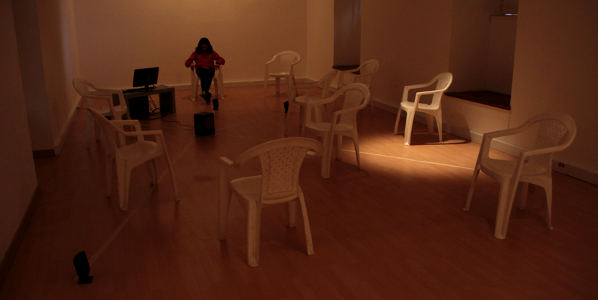
Resonating through voice in an in-between space, being heard on the other side of the world, about feelings left by the experience of re-location or dislocation, opens our sense of being and our multidimensional condition. Perception of location is sometimes as volatile as the sense of reality, and as clear and structured as the dream reality can be.
The performances were part of Networked Migrations, a practice-based research project which explored feelings of displacement and being in the ‘in-between’ of migrants communities.
Dreamers and performers London/ Soñadores y performers Londres: Amaru, Nelly, Sebastián, Steve Cárdenas Mosquera
Dreamers and performers Bogotá/ Soñadores y performers en Bogotá: Diana María Restrepo, Joela, Sandra Miranda Pattin, Tzitzi Barrantes
Programmer Max Interface/ Programador Max Interface: Emmett Glynn
Venues: Resonance FM (London), Plataforma Bogotá (Bogotá)
Collaborators in the performance: Deep Listening Institute (Kingston-NY), Plataforma Bogotá (Colombia), Resonance FM (London)
Ximena Alarcón
Ximena Alarcón is an artist who engages in listening to migratory spaces and connecting this to individual and collective memories. Her practice has involved ethnography, deep listening, and sonic improvisation, intertwined with the creative use of Internet multimedia technologies. She is interested in working interstitial or ‘in-between’ spaces where borders become diffused, such as underground transport systems, dreams, and the ‘in-between’ space in the context of migration. She completed a PhD in Music, Technology and Innovation at De Montfort University and was awarded with The Leverhulme Trust Early Career Fellowship 2007-2009 to develop “Sounding Underground” at the Institute of Creative Technologies. Since October 2011, she has been working as a Research Fellow at CRiSAP – Creative Research in Sound Arts Practice from the University of the Arts London – LCC, developing her project “Networked Migrations – listening to and performing the in-between space”.
+ More information:
http://networkedmigrations.wordpress.com/
Furtherfield Gallery
McKenzie Pavilion, Finsbury Park
London N4 2NQ
T: +44 (0)20 8802 2827
E: info@furtherfield.org
Furtherfield Gallery is supported by Haringey Council and Arts Council England.
James Lowne won the Animate Digitalis Prize in 2011, with his computer animation Someone Behind the Door Knocks at Regular Intervals. His latest animation, Our Relationships Will Become Radiant (2012) was recently screened at the BFI and Tate Modern, and is now available on DVD.
Sarah Thompson: First let’s talk about Someone Behind the Door Knocks at Irregular Intervals. How did you go about creating this piece?
James Lowne: Something that interested me was the idea of contemplation and distraction, how we relate to these contrasts in a space where images are in circulation. The production of gestures and poses that are prepared, cropped and then framed for output as media content. So for this film I tried to convey these themes, within a cinematic sense, by way of a narrative. A friend gave me a piece of music and I thought I would set down some pictures to this. I began to source pictures from different places, personal photographs, movie stills, magazine ads, and consider new arrangements of these, treating them as objects. For me this appropriation is an important part of the process.
ST: Appropriation of data objects?
JL: Images could be seen as condensed information perhaps, but what I find interesting is the effect of accumulation, like interchangeable tiles. A grand narrative of the exchange, and this is what becomes more important than the singular image. But conversely, and what I find incredible, is that always within the homogeneous there is this latent singular moment, where one image, an instance of infinite copies, presents itself as unique in a particular situation to a particular viewer. The image selects the viewer, not the other way around.
ST: It has the particular quality of exploring psychic space, which I think is a key quality of Computer Animation. Do you think this is why the medium suits you so well?
JL: Well, I think we should elaborate on the term psychic space. And also think about what we mean by computer animation. What is the working process? What is the form of presentation? Still it is being used within the parameters of filmmaking. Mainstream cinema CGI relies heavily on anthropomorphism, a long line of tradition from early cell animations. To move an object suggests giving it life of some kind, but the process of making the image move is different now, it’s much quicker for one. What the computer brings to the animator is the illusion of a 3 dimensional environment as a working space, the monitor resembling the camera frame. What interests me is the ability to very quickly explore what effects a camera can have over a subject and how the subject has been posed. Capturing gestures from different angles and rendering them into images brings the meaning of this body language into question. The computer can allow you to make these decisions at incredible speeds, whizzing the camera around the subject with your mouse and keyboard. You couldn’t do this so quickly with actual cameras and so a new selection process comes into play, and this for me suggests the relationship of space and surface, and you can work like a machine, running through infinite choices.
ST: So the relationship is perhaps more of a spatial one?
JL: Yes, but a simulated space. The computer allows us to enter into this space and this is with the use of an interface, and this is the fundamental difference from, say, drawing on paper, or painting.
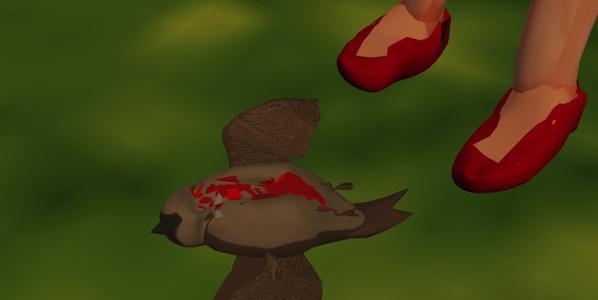
ST: The characters in both films are ‘roughly drawn’ as though you were ‘feeling the way’ as you were making it. Is that so?
JL: Drawing and writing form a starting point for my work, and I am more interested in ideas. I didn’t have a camera or any actors, but I did have a computer. I had learnt how to use all these graphic software programmes from the commercial work I had done. It struck me that the software packages end up monopolising aesthetics somewhat, with a focus on simulating cinematic styles, animating figures in a certain way, and so on. To me this seemed rather pointless and I wanted to try and get a different connection with the machine, to see if I could apply drawing through the interface. I found it very tricky, really.
ST: But through this process you make acutely emotive characters. What sort of commercial work did you make?
JL: The commercial work I had done would involve applying motion graphics onto things, or manipulating footage in post-production. I would go through frame by frame watching the actors or models in corporate adverts and film trailers. Their stylised expressions and poses I really liked, you get to think about them differently when watching them over again, and freezing on a frame of your choice.
ST: Maybe this is why these works are both funny as well as saddening. There is also a strong filmic influence like Psycho, and Blood of a Poet…
JL: For me cinema is a greater influence than animation. I like the way film can generate mood as well as story, and often the techniques of production can overwhelm the overall form. This is what is great about the old, Italian horror films of Fulci or Argento, which have relatively low production values and often, dubious narrative coherence. But this is what is so empty and distancing about them, this form makes them incredible. And the fact that I would watch them on VHS copies of variable quality only amped up the level of horror. I think these old horror films straddle that feeling of humour and terror.
ST: Like Antonioni except horror?
JL: I am not familiar with the work of Antonioni. I know Blowup, and I want to see Red Desert. But I wouldn’t make a connection with him and someone like Fulci though, that’s a whole different ball game. Fulci’s lack of filmmaking skills is the wonderful aesthetic I think, rather than the other way around.
ST: It also has qualities of traditional animation, like leaves quivering in the breeze…
JL: Yes, I like that scene as a cut away. I like the fact that in films you can uses images and sounds of nature to set certain romantic moods. I was interested in the affect that the computer generation of this style would achieve. Is it the same? The leaves look like they are kind of flashing.
ST: The narrative is all implied; do you think this puts the emphasis on the psyche of the central character?
JL: Well, I was learning about cinematic techniques as I was making the film, trying things out. Editing a sequence is very interesting to me, the way subjectivity can be manufactured by putting things next to each other. I think we tend to think about films, web and TV in a natural way when looking at media content – that this is the correct way to order a sequence of images together to tell a story – but for me this is a problem and it lends itself to playing on emotions, and this is also how we are marketed to. Is narrative implied in the dialogue between the object of advertising and the subject of consumer? In the capitalist society we are put into a space to engage with the object of choice, we shift through many surfaces of appearances quickly to construct a reality. Maybe we should edit more films like this, reflect back the illusion and test out new durations. I love the way Warhol’s films have impossible durations, making us consider ourselves rather than the work.
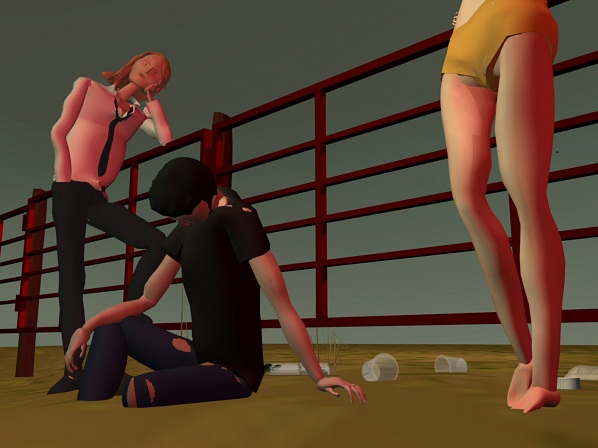
ST: We are very used to, if not inculcated in commercial object relations?
JL: I think Baudrillard uses the term absolute advertising, the form itself of advertising as an operational mode. He also speaks of the demand for advertising. I find it interesting in that we may try to determine our positions in the social sphere within this backdrop, even as we disregard it as meaningless, it has a role in mapping the coordinates in which media moves about.
ST: Do you think we see computer animation in a prejudicial way, and expect certain things from it?
JL: I think people expect certain styles and genres from their cinematic entertainment. I think we look for authenticity in things. We see computer animation everyday and don’t question it, for example on TV commercials, idents for the web, branding and corporate logos. Computer games are having an effect on cinema too. I think only if the context is changed people may question it.
ST: I mean that it’s possible to do things and say things with animation which wouldn’t be so realisable with film, animation is maybe more iconic?
JL: I think film and computing are very much as one now. Anything can be achieved in a post-production suite, and is quite often expected of film today. I think the aesthetics should cross even more rather than CGI trying to emulate film. The opening scene to David Lynchs’ Mulholland Drive for me is a perfect way of using computer graphics and film, and this achieves an amazing effect for the cinema.
ST: In Our Relationships Will Become Radiant there is a similar exploration of the psychic space between individuals to Someone Behind the Door but it is drawn out further and even more oblique. The characters have a special relationship with images in a frame? Like i-Pads almost. They find the ‘photographs’ lying on the ground.
JL: Well, I was trying to use narrative to look at subjects, to look at relationships within a network of some kind. I wanted to let the film generate some of its own relationships. In the narrative there is this kind of defined physical space that these people find themselves in, although they try to make this space limitless. I was interested in the idea that they lose their physicality somewhat, maybe disregarding their bodies, or appropriating themselves as images.
ST: Perhaps the specifics of the narrative ‘don’t matter’, it is as though you are finding the essence of manners of relating which can be more subtle in CG because you can manipulate the models more quickly?
JL: Certain narrative forms we take for granted as real, news reports or some big corporate event, the way these things are mediated to us we accept as a truth, the way that it actually is or actually happened, which is obviously not true. I think narrative forms should be explored to allow us to think about what we take for granted as truth, and even further, how do we act in the space of choice between different truths when the mediation of these subjects is the same?
ST: Is it that a narrative can be suggested, but it doesn’t actually have to be a narrative to have a narrational effect? And then it is sort of how we find meaning symbolically in pictures, and that helps us to make sense of life?
JL: Well, exactly. Questioning things is very important, especially if we are to live in a network of images. In conventional narrative forms emotion and passion can be exploited very easily, and maybe this helps keep those accepted forms of mediation in operation. Cinematic narratives can be reframed in new stylistic approaches to adapt to the present ideology, but are we breaking away from the conventional structures?
The DVD is available from the BFI shop, published by Filmarmalade, and it also includes a second new film, Corporate Glossy Warhol Burger, co directed with Gordon Shrigley
Featured image: The Simplex Algorithm
Algorithms have become a hot topic of political lament in the last few years. The literature is expansive; Christopher Steiner’s upcoming book Automate This: How Algorithms Came to Rule Our World attempts to lift the lid on how human agency is largely helpless in the face of precise algorithmic bots that automate the majority of daily life and business. So too, is this matter being approached historically, with Chris Bishop and John MacCormick’s Nine Algorithms That Changed the Future, outlining the specific construction and broad use of these procedures (such as Google’s powerful PageRank algorithm, and others used in string searching, (i.e regular expressions, cryptography and compression, Quicksort for database management). The Fast Fourier Transform, first developed in 1965 by J.W Cooley & John Tukey, was designed to compute the much older mathematical discovery of the Discrete Fourier Algorithm,* and is perhaps the most widely used algorithm in digital communications, responsible for breaking down irregular signals into their pure sine-wave components. However, the point of this article is to critically analyse what the specific global dependences of algorithmic infrastructure are, and what they’re doing to the world.
A name which may spring forth in most people’s minds is the former employee of Zynga, founder of social games company Area/Code and self described ‘entrepreneur, provocateur, raconteur’ Kevin Slavin. In his famously scary TED talk, Slavin outlined the lengths Wall Street Traders were prepared to go in order to construct faster and more efficient algo-trading transactions: such as Spead Networks building an 825 mile, ‘one signal’ trench between NYC and Chicago or gutting entire NYC apartments, strategically positioned to install heavy duty server farms. All of this effort, labelled as ‘investment’ for the sole purpose of transmitting a deal-closing, revenue building algorithm which can be executed 3 – 5 microseconds faster than all the other competitors.
A subset of this, are purposely designed algorithms which make speedy micro-profits from large volumes of trades, otherwise known as ‘high speed or high frequency traders (HST). Such trading times can be divided into billionths of a second on a mass scale, with the ultimate goal of making trades before any possible awareness from rival systems. Other sets of trading rely on unspeakably complicated mathematical formulas to trade on brief movements in the relationship between security risks. With little to no regulation (as you would expect), the manipulation of stock prices is an already rampant activity.
The Simplex Algorithm, originally developed by George Dantzig in the late 1940s, is widely responsible for solving large scale optimisation problems in big business and (according the optimisation specialist Jacek Gondzio) it runs at “tens, probably hundreds of thousands of calls every minute“. With its origins in multidimensional geometry space, the Simplex’s methodological function arrives at optimal solutions for maximum profit or orienting extensive distribution networks through constraints. It’s a truism in certain circles to suggest that almost all corporate and commerical CPU’s are executing Dantzig’s Simplex algorithm, which determines almost everything from work schedules, food prices, bus timetables and trade shares.
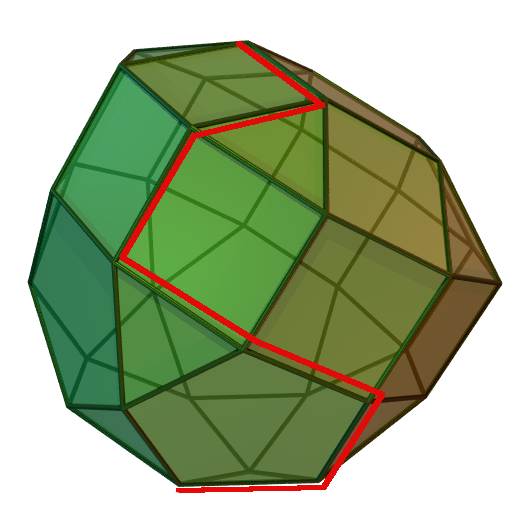
But on a more basic level, within the supposedly casual and passive act of browsing information online, algorithms are constructing more and more of our typical experiences on the Web. Moreover they are constructing and deciding what content we browse for. A couple of weeks ago John Naughton wrote a rather Foucaultian piece for the Guardian online, commenting on the multitude of algorithmic methods which secretly shape our behaviour. It’s the usual rhetoric, with Naughton treating algorithms as if they silently operate in secret, through the screens in global board rooms, and the shadowy corners of back offices dictating the direction of our world – x-files style.
‘They have probably already influenced your Christmas shopping, for example. They have certainly determined how your pension fund is doing, and whether your application for a mortgage has been successful. And one day they may effectively determine how you vote.’
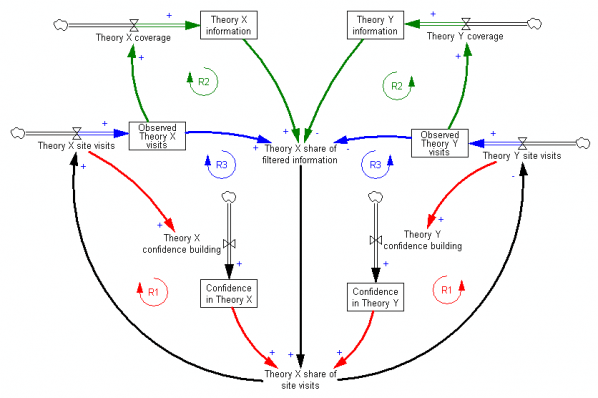
The political abuse here is retained in the productive means of generating information and controlling human consumption. Naugnton cites an article last month by Nick Diakopoulos who warns that not only are online news environments saturated with generative algorithms, but they also reveal themselves to be biased, masquerading as ‘objective’. The main flaw in this being ‘Summerisation‘; that relatively naive decision criteria, inputted into a functional algorithm (no matter how well-designed and well intentioned) can process biased outputs that exclude and prioritise certain political, racial or ethical views. In an another (yet separate) TED talk, Eli Pariser makes similar comments about so-called “filter bubbles”; unintended consequences of personal editing systems which narrow news search results, because high developed algorithms interpret your historical actions and specifically ‘tailor’ the results. Presumably its for liberal self-improvement, unless one mistakes self-improvement with technocratic solipsism.
Earlier this year, Nextag CEO Jeffery Katz wrote a hefty polemic against the corporate power of Google’s biased Pagerank algorithm, expressing doubt about its capability to objectively search for other companies aside from its own partners. This was echoed in James Grimmelmann’s essay, ‘Some Skepticism About Search Neutrality’, for the collection The Next Digital Decade. Grimmelmann gives a heavily detailed exposition on Google’s own ‘net neutrality’ algorithms and how biased they happen to be. In short, Pagerank doesn’t simply decide relevant results, it decides visitor numbers and he concluded on this note.
‘With disturbing frequency, though, websites are not users’ friends. Sometimes they are, but often, the websites want visitors, and will be willing to do what it takes to grab them.’
But lets think about this; its not as if on a formal, computational level, anything has changed. Algorithmic step by step procedures are mathematically speaking as old as Euclid. Very old. Indeed, reading this article wouldn’t even be possible without two algorithms in particular: the Universal Turing Machine, the theoretical template for programming which is sophisticated enough to mimic all other Turing Machines, and the 1957 Fortran Compiler; the first complete algorithm to convert source code in executable machine code. The pioneering algorithm responsible for early languages such as COBOL.
Moreover, its not as if computation itself has become more powerful, rather it has been given a larger, expansive platform to operate in. The logic of computation, the formalisation of algorithms, or, the ‘secret sauce’, (as Naughton whimsically puts it) have simply fulfilled their general purpose, which is to say they have become purposely generalised, in most, if not all corners of Western production. As Cory Doctorow put in 2011’s 28c3 and throughout last year, ‘We don’t have cars anymore, we have computers we ride in; we don’t have airplanes anymore, we have flying Solaris boxes with a big bucketful of SCADA controllers.’ Any impact on one corner of computational use affects another type of similar automation.
Algorithms in-themselves then, haven’t really changed, they have simply expanded their automation. Securing, compressing, trading, sharing, writing, exploiting. Even machine-learning, a name which infers myths of self-awareness and intelligence are only created to make lives easier through automation and function.
The fears surrounding their control are an expansion of this automated formalisation, not something remarkably different in kind. It was inevitable that in a capitalist system, effective procedures which produce revenue would be increasingly automated. So one should make the case that the controlling aspect of algorithmic behaviour be tracked within this expansion (which is not to say that computational procedures are inherently capitalist). To understand algorithmic control is to understand what the formal structure of algorithms are and how they are used to construct controlling environments. Before one can inspect how algorithms are changing daily life, and environmental space, it is helpful to understand what algorithms are, and on a formal level, how they both work and don’t work.
The controlling, effective and structuring ‘power’ of algorithms, are simply a product of two main elements intrinsic to formal structure of the algorithm itself as originally presupposed by mathematics: these two elements are Automation and Decision. If it is to be built for an effective purpose, (capitalist or otherwise) an algorithm must simultaneously do both.
For Automation purposes, the algorithm must be converted from a theoretical procedure into an equivalent automated mechanical ‘effective’ procedure (inadvertently this is an accurate description of the Church-Turing thesis, a conjecture which formulated the initial beginnings of computing in its mathematical definition).
Although it is sometimes passed over as obvious, algorithms are also designed for decisional purposes. Algorithms must also be programmed to ‘decide’ on a particular user input or decide on what is the best optimal result from a set of possible alternatives. The algorithm has to be programmed to decide on the difference between a query which is ‘profitable’ or ‘loss-making’, or a set of shares which are ‘secure’ or ‘insecure’, or deciding the optimal path amongst millions of variables and constraints, or locating various differences between ‘feed for common interest’ and ‘feed for corporate interest’. When any discussion arises on the predictive nature of algorithms, it operates on the suggestion that it can decide an answer or reach the end of its calculation.

Code both elements together consistently and you have an optimal algorithm which functions effectively automating the original decision as directed by the individual or company in question. This is what can be typically denoted as ‘control’ – determined action at a distance. But that doesn’t mean that an algorithm suddenly emerges with both elements from the start, they are not the same thing, although they are usually mistaken to be: negotiations must arise according to which elements are to be automated and which are to be decided.
But code both elements or either element inconsistently and you have a buggy algorithm, no matter what controlling functionality it’s used for. If it is automated, but can’t ultimately decide on what is profit or loss, havoc ensues. If it can decide on optimised answers, but can’t be automated effectively, then its accuracy and speed is only as good as those controlling it, making the algorithm’s automation ineffective, unreliable, or only as good as human supervision.
“Algorithmic control” then, is a dual product of getting these two elements to work, and my suggestion here is any resistance to that control comes from separating the two, or at least understanding and exploiting the pragmatic difficulties of getting the two to work. So looking at both elements separately (and very quickly), there are two conflicting political issues going on and thus two opposing mixtures of control and non-control;
Firstly there is the privileging of automation in algorithmic control. This, as Slavin asserts, examines algorithms as unreadable “co-evolutionary forces” which one must understand alongside nature and man. The danger that faces us consists in blindly following the automated whims of algorithms no matter what they decide or calculate. Decision-making is limited to the speed of automation. This view is one of surrendering calculation and opting for speed and blindness. These algorithms operate as perverse capitalist effective procedures, supposedly generating revenue and exploiting users on their own well enough (and better than any human procedure), the role of their creators and co-informants is a role best suited to improving the algorithm’s conditions for automation or increasing the speed to calculate.
Relative to the autonomous “nature” of algorithms, humans are likely to leave them unchecked and unsupervised, and in turn they lead to damaging technical glitches which inevitably cause certain fallouts, such as the infamous “Flash Crash” loss and regain on May 6th 2010 (its worrying to note that two years on, hardly anyone knows exactly why this happened, precisely insofar no answer was decided). The control established in automation can flip into an unspeakable mode of being out of control, or being subject to the control of an automaton, the consequences of which can’t be fully anticipated until it ruins the algorithm’s ability to decide an answer. The environment is now subject to its efficiency and speed.
But there is also a contradictory political issue concerning the privileging of decidability in algorithmic control. This as Naughton and Katz suggest, is located in the closed elements of algorithmic decision and function. Algorithms built to specifically decide results which only favour and benefit the ruling elite who have built them for specific effective purposes. These algorithms not only shape the way content is structured, they also shape the access of online content itself, determining consumer understanding and its means of production.
This control occurs in the aforementioned Simplex Algorithm, the formal properties which decide nearly all commercial and business optimising; from how best to roster staff in supermarkets, to deciding how much finite machine resources can be used in server farms. Its control is global, yet it too faces a problem of control in that its automation is limited by its decision-making. Thanks to a mathematical conjecture originating with US mathematician Warren Hirsch, there is no developed method for finding a more effective algorithm, causing serious future consequences for maximising profit and minimising cost. In other words, the primary of decidability reaches a point where it’s automation is struggling to support the real world it has created. The algorithm is now subject to the working environment’s appetite for efficiency and speed.
This is the opposite of privileging automation – the environment isn’t reconstructed to speed up the algorithm automation-capabilities irrespective of answers, rather the algorithm’s limited decision-capabilities are subject to the environment which now desires solutions and increased answers. If the modern world cannot find an algorithm which decides more efficiently, modern life reaches a decisive limit. Automation becomes limited.
——————–
These are two contradictory types of control; once one is privileged, the other recedes from view. Code an algorithm to automate at speed, but risk automating undecidable, meaningless, gibberish output, or, code an algorithm to decide results completely, but risk the failure to be optimally autonomous. In both cases, the human dependency on either automation or decision crumbles leading to unintended disorder. The whole issue does not lead to any easy answers, instead it leads to a tense, antagonistic network of algorithmic actions struggling to fully automate or decide, never entirely obeying the power of control. Contrary to the usual understanding, algorithms aren’t monolithic, characterless beings of generic function, to which humans adapt and adopt, but complex, fractured systems to be negotiated and traversed.
In between these two political issues lies our current, putrid situation as far as the expansion of computation is concerned – a situation in which computational artists have more to say about it than perhaps they think they do. Their role is more than mere commentary, but a mode of traversal. Such an aesthetics has the ability to roam the effects of automation and decision, examining their actions even while they are, in turn, determined by them.
* With special thanks to the artist and writer Paul Brown, whom pointed out the longer history of the FFT to me.
MaKey MaKey is a kit that lets you turn anything into a controller. Let your imagination go wild!
Codasign in partnership with Furtherfield will be running two MaKey MaKey workshops for children and their parents at Furtherfield Gallery on Saturday 16 February: a morning session with 6-9 year olds (10-12pm) and an afternoon one with 9-12 year olds (1-4pm).
All supporting material for the workshop will be available at learning.codasign.com.
What will you do and learn?
During this workshop, the children will practice using computational thinking and interactive design through a variety of activities.
What do you need to already know?
You only need to have big ideas – no other experience required.
What do you need to bring?
You need to bring a laptop and an adult. The same adult can accompany multiple children. If you aren’t able to bring a laptop, just let us know by adding a note to your registration or e-mailing info@codasign.com.
What will be available during the workshop?
There will be drinks available, but you are welcome to bring along some snacks to feed your creativity.
Cancellation Policy
Full refund if registration is cancelled over a week before the course start, 50% if within a week of the course start, and no refund if within 24 hours of the course start.
VISITING INFO
Furtherfield Gallery
McKenzie Pavilion
Finsbury Park, London, N4 2NQ
Scratch is a programming environment that is easy to use and created with children in mind. Create and share your own interactive stories, games, music and art!
Codasign in partnership with Furtherfield will be running two Scratch workshops for children and their parents at Furtherfield Gallery on Saturday 09 February: a morning session with 6-9 year olds (10-12pm) and an afternoon one with 9-12 year olds (1-4pm).
Please book your place.
All supporting material for the workshop will be available at learning.codasign.com.
What will you do and learn?
You will design and make a game or animation using the Scratch environment.
What do you need to already know?
You only need to have big ideas – no other experience required.
What do you need to bring?
You need to bring a laptop and an adult. The same adult can accompany multiple children. If you aren’t able to bring a laptop, just let us know by adding a note to your registration or e-mailing info@codasign.com.
What will be available during the workshop?
There will be drinks available, but you are welcome to bring along some snacks to feed your creativity.
Cancellation Policy
Full refund if registration is cancelled over a week before the course start, 50% if within a week of the course start, and no refund if within 24 hours of the course start.
VISITING INFO
Furtherfield Gallery
McKenzie Pavilion
Finsbury Park, London, N4 2NQ
We live in a world riddled with contradictions and confusing signals. Our histories are assessed, judged and introduced as fact yet there are so many bits missing. We accept what is given through soundbite forms of mediation and end up using the easy bits as our defaults, and build up these assumptions as our ‘imagined’ guidelines. This article examines how these accepted defaults are being challenged by contemporary artists. Each have expressed their own particular (unofficial and official) form of interventions at the Tate Gallery. Featuring art works produced by artists’ and art groups, such as Graham Harwood, Platform, IOCOSE and Tamiko Thiel, we explore their connected enactments and critiques of the existing conditions. Whether it is based on economic, ecological, historical, political or hierarchical situations, they are making others aware of their creative arguments in different ways.
You will not see them accepting an award at the Turner Prize. But, their work has become as equally significant (perhaps even more) than, the mainstream art establishment’s franchised celebrities. There is now wider art audience out there, connected to the Internet and they are aware of the issues of the day. Yet, this context is not reflected back by traditional art venues and art press. Instead, we receive more of the same. The mainstream version of contemporary art has found its allies within a global and corporate culture, where business dictate’s art value. Critical and imaginative contexts contrary to neoliberal demands, are left aside. We cannot trust the ‘official’ art world to produce a realistic vision of what contemporary art really is. It is up those who are not reliant on or diverted by these powerful frameworks and elusive economies, to bring about a different set of examples of an existing parallel world which is thriving, and so much more interesting and relevant.
“Art is subject to a double protection. In the market, it is shielded from unwarranted treatment through controlled ownership. In the museum world, experts decide what should be seen, alongside what, with what interpretation and in what circumstances. A wide public is courted but allowed no power over what it sees. The very ethos of this culture—of exclusivity, elitism and control—is now at odds with the culture people make themselves.” [1] (Stallabrass 2011)
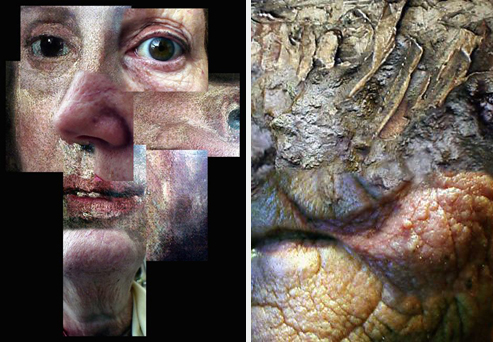
“From adolescence I had visited the Tate, read the Art books and generally pulled a forelock in the direction of the cult of genius, on cue relegating my own creativity to the Victorian image of the rabid dog. We know well enough that this was how it was supposed to be. The historical literature on ‘rational recreations’ states that, in reforming opinion, museums were envisaged as a means of exposing the working classes to the improving mental influence of middle class culture. I was being inoculated for the cultural health of the nation.”[2] (Harwood)
In 2000, Graham Harwood[3] received the first Net Art online commission from the Tate Gallery London for the creation of his art work ‘Uncomfortable Proximity'[4]. Viewing the visual images/collages created by Harwood; reminds one of the moment when Dorian Gray in Oscar Wilde’s ‘The Picture of Dorian Gray'[5] views his disfigured self portrait. Considered a work of classic gothic fiction with a strong Faustian theme. The facade of his own idealised beauty is revealed as something less attractive and deeply disturbing. Harwood’s approach in offering the viewer to click on the image to see what lies behind shows the people he represents, to be seen as lurking secrets, as ghosts, mutants, lepers and outsiders.
![Dorian in front of his portrait in the 1945 film The Picture of Dorian Gray.[6]](http://www.furtherfield.org/wp-content/uploads/2012/12/dorian-gray.jpg)
“Tate Britain stands on the site of Millbank penitentiary incorporating part of the prison within its own structure. The bodies of many of the inmates remain concreted into the foundations of the building. The drains that run from the building to the Thames, a stones through away, bleed this decay into the silt of the Thames.”[7] (Harwood 2006).
Harwood brings to the fore the forgotten people. The lives of others, whose stories are now just distant markers of a past, dominated by a colonial history. These are the losers, the then ridiculed and exploited chavs of their day.
“‘Chav’ is an insulting word exclusively directed at people who are working class.”[8] (Jones 2012).
The first section of ‘Uncomfortable Proximity’ maps high society rituals of tastefulness and its inherent hypocrisy. The second, representations and histories of different people such as friends, family and others, who are unseen in terms of the institution’s remit of tastefulness. To do this he used the historically respected paintings (on-line images) on the Tate web site by artists such as Turner, Hogarth, Hamilton, Gainsborough, Constable and others.
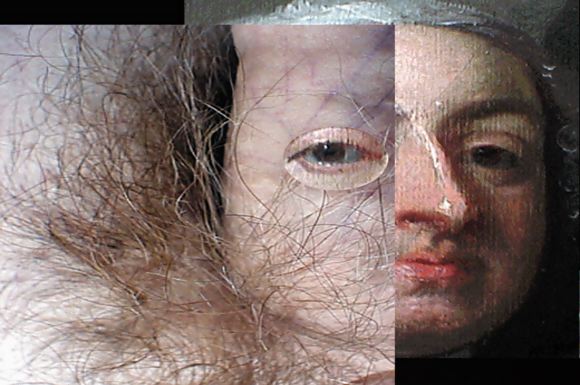
“This work forced me into an uncomfortable proximity with the economic and social elite’s use of aesthetics in their ascendancy to power and what this means in my own work on the internet.”[9] (Harwood 2006)
London’s Tate Britain area, before it was reconstructed into an art gallery, in the early 19th century was a national prison. The Millbank Penetentiary, was hailed as the greatest prison in Europe, at a cost of £500,000 it was finally built in 1821. It was Jeremy Bentham, the British philosopher and philanthropist who designed it using his pionering ideas creating the prison as a ‘panopticon’.
“At its centre was the Governor’s House, which allowed prison guards to keep watch over 1,500 transportation prisoners housed in separate cells in the surrounding pentagonal blocks. There were three miles of cold, gloomy passages: the turnkeys invented a code of chalked directions to stop getting lost in the maze!”[10]
Sentenced prisoners were processed in the prison each year and up to 4,000 would then be sent off to distant lands, such as Australia. Within the panopticon, prisoners would not know whether they were being watched or not.
“The panopticon Panoptic power built into the architecture of Benthams’ prison Prefigured what some refer to as the “electronic panopticon” or “surveillance society” which includes: the mass surveillance & collection of data by government on populations; the surveillance & collection of data on consumers for marketing purposes; the management surveillance & control of the workforce by industry.”[11] (Ballantyne)

Somehow Harwood manages to bite at the hand that feeds him, “the artist very deliberately used the work to question the role of digital media in promotion and collection. His Web site copied the Tate publicity site, with his own content inserted, causing substantial institutional disruption around the marketing department because the Tate’s Web site, in common with those of many art museums, was seen primarily as a marketing tool, then perhaps as interpretation, but never before then as a venue for digital art.[12] (Cook, 2001).
At his point it’s worth considering how some artists have experimented with the behaviour of parasites in order to explore their artistic autonomy at the edge of things. The rise of hacking and ‘art and hacktivism’ has brought about artists reimagining their creative intentions not in terms of existing within the frameworks of galleries and museums (although many do show their work in these types of venues as well). Many have chosen not to comply to the ‘official’ script of marketing demands and values imposed by mainstream art world hegemony, or concede to centralised web 2.0 structures dominating Internet culture and our mobile networks.
“The word ‘parasite’ comes from ‘para sitos’, meaning ‘beside the grain’, and refers to those animals that take advantage of grain stores to feed. […] they are not part of the restricted economy of exchange, profit, and return that is at the heart of capitalism, and to which everything else ends up being subordinated and subsumed. Thus they find an enclave away from total subsumption not outside of the market, but at its technical core.”[13] (Gere 2012)
![Haw under arrest before the State Opening of Parliament in 2010. Photo: Jeff Moore. Telegraph.[14]](http://www.furtherfield.org/wp-content/uploads/2012/12/haw-police_1924712b.jpg)
In June 2001, activist Brian Haw began his protest against the economic sanction on Iraq, opposite the Palace of Westminster in central London, until his death of lung cancer in June 2011. He earned himself a place in the history books for what he devoted ten years of his life doing, camping in a tent outside the Palace with numerous placards. First it started with only a few banners and then through the years the number of banners accumulated, with its content pointing out to the public and politicians, the huge suffering and killing of people in Iraq supported by the UK government. “Even as fresh attempts were begun to oust him, he won an award for being that year’s ‘most inspiring political figure’.”[15] (Stevenson 2011)
In 2006-7 British artist Mark Wallinger created an installation called State Britain, replicating all of the tents and banners at Parliament Square. Featuring it as his main entry for the Turner Prize at Tate Britain. “Faithful in every detail, each section of Brian Haw’s peace camp from the makeshift tarpaulin shelter and tea-making area to the profusion of hand-painted placards and teddy bears wearing peace-slogan t-shirts has been painstakingly sourced and replicated for the display.”[16] It also included copies of other people’s contributions, consisting of messages and banners amassed by Haw over the years, as a constant and dedicated daily protester, winning Wallinger the Turner Prize.
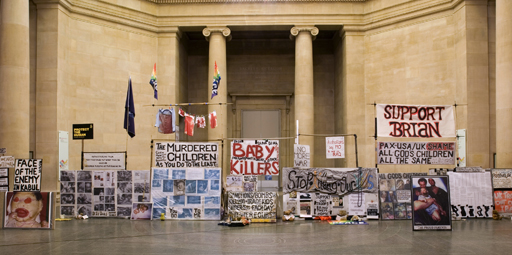
“…the larger hand-painted signs are defanged by their new context. “Beep for Brian,” once an irreverent call-to-arms taken up by many motorists plowing through the Westminster traffic, has become an absurdity, un-honkably sealed within the echoing marble box of the Tate. Never has the notion of the “lost original,” that timeworn legacy of Duchamp’s ready-mades, carried such a melancholic charge.” [17] (Street)
In contrast to his peers who also came out of the YBA (BritArt) movement in the late 80s and early 90s, which includes individuals such as Damien Hirst, Rachel Whiteread and Tracey Emin, Wallinger is a committed socialist. Damien Hirst was “the leading light in the YBA movement, is a famously good businessman and is now one of the richest men in England.”[18] (Shaw 2011)
“I did feel removed from the YBA thing. But it almost immediately raised people’s game. There was money and there was an audience. Or, to be strictly accurate, there was money – it really was a very targeted strategy to begin with – and the audience came along a bit later.”[19] (Wallinger 2011)
Wallinger’s comments about the audience coming along later rings true. The power of money and marketing created an audience that before,was not there, specifically for the YBA’s. Emerging artists at the time, who were not part of this elite where left out of the picture, not because of their art but because of their lack of connections with YBA circles. Many artists casted their creative intentions and values aside and re-invented their art in accordance to YBA themes, with a hope they would be accepted by this (then) new, mainstream art establishment. From the early 80s, and well into the 90s, UK art culture was dominated by the marketing strategies of Saatchi and Saatchi, a formidable force in the advertising world. The same company had been responsible for the successful promotion of the Conservative party (and conservative culture) that had led to the election of the Thatcher government in 1979. Saatchi and Saatchi Applied their marketing techniques and corporate power, with an accomplished parallel coup within the British art scene, creating an elite of artists who embraced the commodification of their personalities alongside depoliticized artworks.
Stewart Home proposes that the YBA movement’s evolving presence in art culture fits within the discourse of totalitarian art “the critics who theorise the yBa understand that by transforming art into a secular religion, rather than a mere adjunct of the state, liberalism imposes its domination over the ‘masses’ far more effectively than National Socialism. The focus, especially in the mass media, must be on the artists rather than the artwork.”[20] (Home 1996)
“To be an artist is to contend with the present, and there are not many other careers that afford the freedom to radically examine life and society. To put it bluntly, if artists are studying and writing more about politics, culture, and education, it’s probably a reflection of the unprecedented dysfunctionality of the societies in which they live.”[21] (Deck 2005)
Every now and then something slips through the highly taught institutional web of marketed ideologies and it causes a state of ‘healthy’ unease. One such intervention is the recent collaborative project Tate à Tate.[22] It is a public intervention consisting of an audio guide that people can download onto their MP3 players or mobile phones. The material is accessible from http://tateatate.org – you download a selection of audio files and then take a physical tour to Tate Britain. It is best experienced if you take the Tate Boat to Tate Modern, or you can listen at home. The artists selected to make the sound works are Ansuman Biswas, Phil England, Jim Welton, Isa Suarez, Mark McGowan and Mae Martin.
Mark McGowan, through his daily and weekly online video broadcasts on Youtube and Vimeo, has gained a large Internet-based audience. His videos have appeared on the BBC and the Russia Today news channel. He is a performance artist and constant ‘angry’ critic of the UK government. He has never voted and, is equally critical towards whatever party happens to be in power at the time. Mcgowan’s antics have received interest because of the directness of his arguments. He speaks for and to those who do not have a voice. He reflects upon unjust situations happening in real life. He has become an alterantive force to a ‘politically’ corporate media, who offer no way in for those are not already connected with the elites of institutionalized power.
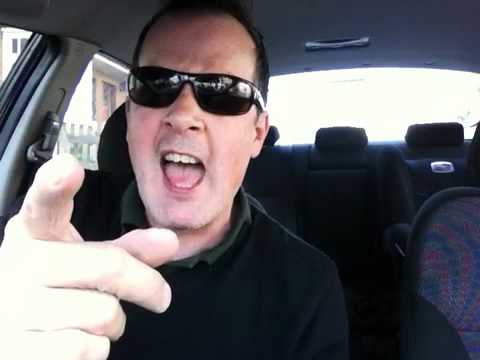
McGowan, has caused various controversies. In 2007, during Celebrity Big Brother when Jade Goody made what seemed to be racists remarks to her house-mate Shilpa Shetty; he publicised an event in support of Goody, which was a protest to burn an effigy of shetty. In the end did not take place.
His position, was that working class people were being used by the media as product to feed a machine, exploiting everyday people’s vulnerabilities. It is also an attack on the media invention of ‘Chavs’, a deliberate attempt to demonise the working classes of Britain. In retrospect, many viewed incident on Celebrity Big Brother as a clash of classes, and not necessarily a rascist issue. But, it was all too late, the media took control of what it saw as a chance to create a larger spectacle out of an already bleak situation.
“The media despised her. […] ‘Vote the pig out!’ demanded the Sun, which also referred to her as an ‘oinker’. Others taunted her as a vile ‘fishwife’ and ‘The Elephant woman’. As the campaign became a hysterical witch-hunt (indeed, one fo the headlines was: ‘Ditch the Witch!’), members of the public stood outside of the studios with placards reading: ‘Burn the Pig!’.” [23] (Jones 2012)
Dominant ideologies are cultivated hegemonically as part of the mainstream consciousness. And even though, the messages communicated through these channels do not accurately reflect real life, they do reflect stereotypes and easy packages of soundbite items on a cruder (lack of) understanding of what human values are, indivudally and collectively. These ‘mediated’ structures, socially re-construct according to ‘commercialised’ trends rather than looking at deeper resonances. Which should also include a necessary critique of their own roles and responsibilities, aksing what does it do to the psyche of a culture when you creating a spectacle out of the everyday; from fantasy into a permanant state of hyper-reality for profit?
“The poverty of the accepted culture and its monopoly on the means of cultural production lead to a corresponding impoverishment of the theory and manifestations of the avant-garde. But it is only within this avant-garde that a new revolutionary conception of culture is imperceptibly taking shape. Now that the dominant culture and the beginnings of oppositional culture are arriving at the extreme point of their separation and impotence, this new conception should assert itself.” [24] (Debord 1957)
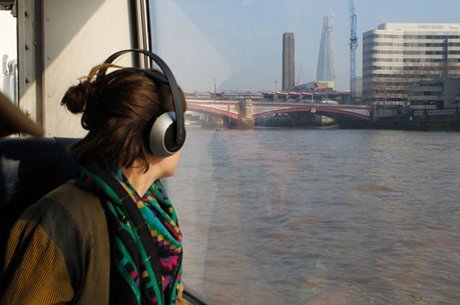
In art, in politics, and in all avenues of power in our culture, the working classes have no voice. It seems that the only way to claim personal power is by submitting to the embarrassing scenario of applying as a contestant on what is ironically termed as reality TV. and, this involves singing someone else’s already ‘bland’, tedious songs, usually written by corporate music media. The divide of class is ever present as colonial systems prevail in exploiting not only foreign resources and the destruction of indigenous peoples’ histories and their ways of living; but also in the very states and countries where these corporate ‘friendly’ neoliberalist cults reside. In respect of oil and funding of the arts, Tate à Tate pulls these issues out from being hidden into a mainstream dialogue through their own interventions.
As the markets have gained an increasingly tighter hold on global economics and everyday people’s lives, a rise of international protests has also gained impetus. We have the Occupy protests which have spread from Wall Street to London to Bogota, in over 950 cities in 82 countries. We also have the UK Uncut protest movement challenging the government’s austerity cuts. The Internet has been a valuable medium, allowing people to connect and organise together. This has enhanced crossovers where artists have become activists and activists artists. New forms of ‘networked’ and ‘activist’ expression, exploiting the imaginative skills of artists (and others) has brought brought about a mix of ideas once used by the Situationists. If you are a typical gallery attendee or a purchaser of mainstream art magazines, awareness of current political and ecological issues through these cultural interfaces are rare. Interventionist art challenges this standard. Causing a social anomaly, fracturing the facade of what we are usually informed of as ‘national’ value.
Tate a Tate is a collaboration between the groups Platform, Liberate Tate and Art Not Oil. The work was a response to when BP was promoting its sponsorship activities in the run-up to the 2012 Olympics. Against the British Museum, the National Portrait Gallery, the Royal Opera House and Tate Britain, aligning themselves with BP (British Petroleum). By receiving sponsorship from BP they say these institutions are “legitimising the devastation of indigenous communities in Canada through tar sands extraction, the expansion of dangerous oil drilling in the Arctic, and the reckless business practices that lead to the deaths of eleven oil workers on the Deepwater Horizon. BP’s involvement with these institutions represents a serious stain on the UK’s cultural patrimony.”[25]
Mel Evans, Platform: “Tate à Tate began from a creative impulse to install something somehow immovable in Tate. Platform and Liberate Tate were collaborating on the publication ‘Not if but when: Culture Beyond Oil’, which features international artists work in response to the BP Gulf of Mexico catastrohpe, and sets out the key debates on oil sponsorship of the arts. We had noticed our critics were often alluding to a kind of inevitability of BP sponsorship.”
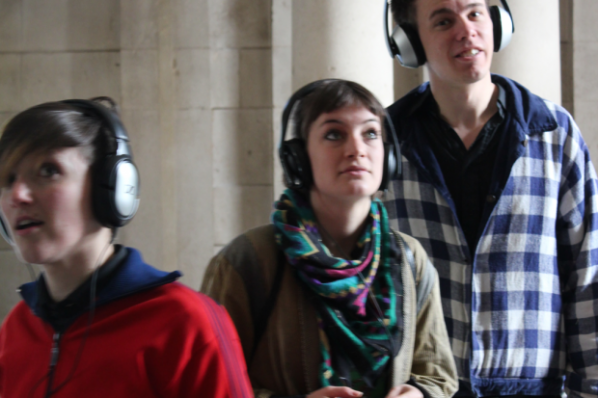
“Liberate Tate’s spectacular performances, although headline grabbing, had all been swiftly cleaned up by Tate staff. Although we knew tough questions were being asked by the Board of Trustees, and 8,000 members and gallery-goers had petitioned Director Nicholas Serota to drop the sponsorship, we also wondered to what extent Tate could absorb our efforts into its own politically savvy artistic persona. So the idea of an audio tour seemed the perfect way for us to create a permanent installation in Tate, challenging BP’s continued presence in the gallery, and recreated by every participant that takes the free download and goes ‘undercover’ in Tate.”
“The process began with a call out for proposals which received a terrific response. From this we came down to three proposals that we thought were equally fantastic and sufficiently different to all warrant exploration – which is where the three chapter journey was born, from Tate Britain to Modern via Tate Boat. From the launch in March 2012 onwards we quickly learned that participants were keen to pick a favourite of the three, their choices were hard to predict.”
“For some, the water related narratives in ‘This is Not An Oil Tanker’, created by Isa Suarez featuring Mae Martin, Mark McGowan and Jasmine Thomas, make the piece the most emotive experience. Others prefer the structure and highly informative content of ‘Drilling the Dirt (A Temporary Difficulty)’ by Phil England and Jim Welton, and likewise other tastes feel most comfortable in the more meandering and evocative ‘Panaudicon’ created by Ansuman Biswas. Panaudicon by Ansuman Biswas at the Tate Britain is by far the most successful… its interaction with and interpretation of its environment is a lot more complex. As initiators of a project with which we want to reach diverse audiences, we’re glad there’s something in there for everyone.”
![Winner of the recent Greenpeace Rebrand BP Competition. Designed by Laurent Hunziker [26]](http://www.furtherfield.org/wp-content/uploads/2012/12/rebranded.jpg)
You can understand why questions around the Tate’s association with BP is of utmost importance. Especially, when considering the oil company has had as many as 8,000 oil spills in the USA alone. There is a long list of disasters and much information linking BP’s troubling courtships with oppressive regimes. Shell, BP, Exxon, Gazprom, Rosneft and other companies, as I write this, are engaged in a frenzied rush in the Arctic risking yet another oil spill and threatening us with even more climate change. And all this effort is for only three years worth of oil.
‘”For over 800,000 years, ice has been a permanent feature of the Arctic ocean. It’s melting because of our use of dirty fossil fuel energy, and in the near future it could be ice free for the first time since humans walked the Earth. This would be not only devastating for the people, polar bears, narwhals, walruses and other species that live there – but for the rest of us too.” [27] (Greenpeace 2012)
Recently in 2012, BP agreed to pay the largest criminal fine in US history for its corporate negligence, in causing the catastrophic Deepwater Horizon oil spill in the Gulf of Mexico. “This was a disaster for the record books: The offshore exploratory well was the deepest drilling ever, plunging more than 30,000 feet through ocean and seabed strata, and the spill was the largest in U.S. history, spewing 206 million gallons of oil — nearly 20 times what the Exxon Valdez had dumped into Prince William Sound in Alaska a decade earlier.” [28] (Schiffman 2012).
In 2011, the New Orleans, LA. Attendees of the ‘Gulf Coast Leadership Summit’ witnessed a positive statement from a representative of the US Department of Health and Human Services (HHS) as he announced to everyone’s surprise a ban on toxic dispersants, and a new free health care plan for spill and cleanup victims. Not just that, there was also another progressive announcement by the BP co-presenter that day who publicly expressed regret for his company’s past actions, he said the oil giant would also pay the bill for the new health care plan.
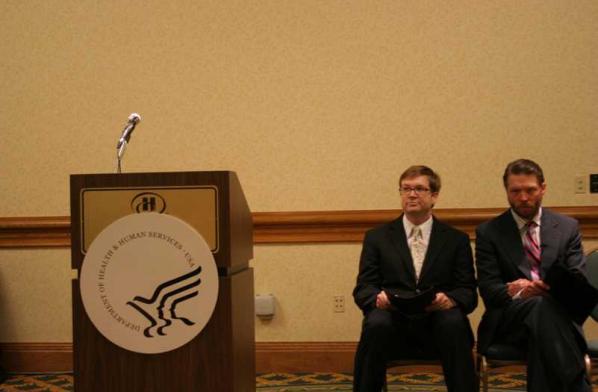
Of course, it was all to good to be true. it was a hoax by the Yes Men [29].
“…except for the audience, everyone was a fake. The impostors Dr. Dean Winkeldom and Steve Wistwil, both Gulf Coast residents, collaborated with the Louisiana Bucket Brigade[30], an organization whose goal is to create sustainable communities free from industrial pollution. The organization decided to create a hoax to publicize what should be happening in response to the emerging health crisis.” [31] (Flaherty 2011)
“The Louisiana Bucket Brigade action was supported by the Yes Lab, a project of The Yes Men that helps activist groups carry out media-getting creative actions on their own. Four years ago in New Orleans, The Yes Men impersonated an official from the Department of Housing and Urban Development to announce, among other things, that HUD would re-open public housing and make oil companies pay up for wetlands destruction.”[32] (ibid)
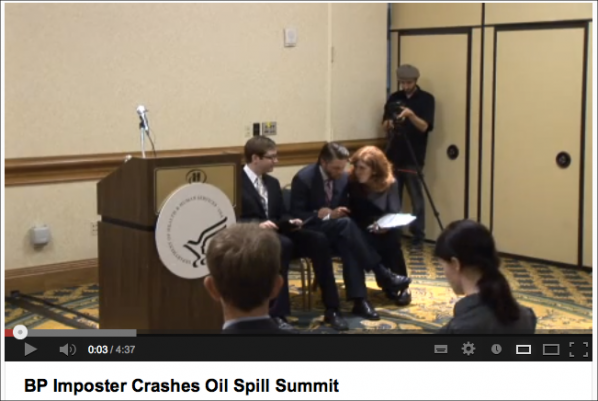
Morgan Quaintance reviewed it for Art Monthly and found that “the Tate Britain and Tate Boat works suffer from a confused sense of purpose… on the other hand, England and Welton’s Tate Modern piece is a note-perfect subversion of the standard form.
Meanwhile Kate Kelsall reviewing for Don’t Panic online reported “There is something irresistibly subversive about slinking around an establishment with your headphones in, taking orders from a voice that resembles a TomTom or sleep aid recording…
Jonathan Jones, after the Tate had renewed its deal with BP wrote in an article in the Guardian “Oh, give me a break. The campaign to stop Tate, the National Portrait Gallery and other museums from accepting money from Britain’s controversial petroleum outfit is the stupidest and most misplaced of supposedly radical campaigns. Why not do something useful like join Occupy? While protests around the world this year, from Wall Street to Tahrir Square, have picked the right causes and enemies, the BP art campaign is mistargeted, misconceived and massively self-indulgent.”
First off, some claims, some general, some particular. I’m going to use these to speak about the work under consideration and in turn call upon that work to support the claims. A kind of virtuous critical circle.
General: works of art are not messages but objects. They don’t say things nor ask questions, nor assert, nor investigate. Neither do they as objects have messages somehow encoded or embedded within them. To assert otherwise is a massive category error.
As objects they may of course be brought in evidence, copied, become conversation pieces, be described well, be described badly, be described perversely, be seen, be half seen, be missed, be lost, be found, be written about, point to things, be compared and many other things, some of which have not yet been imagined.
Further, artworks are fuzzily-bordered and not necessarily of a physical or temporal piece – the object is not simply the object (and ‘the object’ might not be physical but words, a concept, a sound recording, a protocol) but everything that accretes as a result of it – commentary, jokes, other artworks made in response. If mathematical terminology wasn’t so regularly and toe-curlingly abused in the arts, we might refer to them as manifolds, not necessarily connected.
Even the historical is not immune. There’s a reaching back in time where an established work is transformed retrospectively by homage – ‘Las Meninas’ an obvious case in point.
Also: the work of art is finite – it was born and it will, one day, cease to exist (and it will be forgotten, or there will be no-one to remember it). Everything changes, everything dies.
This implies, too, that although the individual author matters, as product of a unique formation and a unique set of locations in time and space, every artwork is socially authored.
Particular: Abraham’s work represents a new conjunction of technology, collaboration and performance as a generator of moving image. It has precursors (freely acknowledged, indeed celebrated) but it is qualitatively new. The moving image work comes in two flavours, fresh and preserved, both with their own particular and delicious savour. Abrahams conducts live performances on the internet. These performances occur singly, as pieces in themselves, or form part of the programme of events accompanying exhibitions. The moving image pieces in this show are all derivations of this kind of performative event. Except derivation has an air of the hierarchical and the types of piece form no hierarchy any more than fresh or smoked salmon do.
A final general claim: writing about art is not a science but itself an art. Sometimes the brush will be delicate and sometimes broad. There is no recipe or rules or template. One can be too delicate – sometimes confusion is good, particularly in the matter of the affective. Crude thinking sometimes gets us further, paralleling, not dissecting, the richnesses of work. There are some mysteries one should leave as such.
OK. Onwards and upwards…
Performative is currently a much used, some might say overused, word. One quite common usage is to suggest that a work contains visible or at least trackable traces of its own making, a kind of archaeological or sedimentary record, and that perhaps this might have been to varying degrees intentional.
Of course it’s arguable any work of art is performative in this way and that it’s quite hard to erase the trail behind you whether what you make is time based or photographic, sculpted or made with hand applied pigment of one sort or another. Continuous looking and thinking about art for any length of time, especially allied to making stuff oneself, whether dabbling or something more serious, hones an increasing sensitivity to these questions. And this matters; particularly when it comes to over-nice distinctions between close relatives such as the still and moving photographic image and esoteric arguments about how time is differently present or presented in each of these and in other further flung practices too. The new scholasticism feeds on ever finer such distinctions.
So it’s a relief to come across work, which is genuinely performative, enough so that even someone undrenched in theory can see it, can get it and can be delighted and exalted by it. Furthermore work that smells unmistakably of the human, that abuts the high and the low, the crude and subtle, that blurs boundaries, that borrows and echoes the work of others not with the pinched expression of someone with a theoretical framework but in a spirit of ‘why?’ and ‘let’s play’ – the two childish precursors of grown up science and art.
Annie Abrahams’ show at the Centre Régional d’Art Contemporain Languedoc-Roussillon in Sète is a graceful and elegant dog’s dinner of a show. Physically it’s odd, exiled to the upper floor (still a generous space) whilst Catherine Gfeller, someone altogether more easily glossed and hence exhausted (though not without merit) gets the more conventional downstairs galleries (and attracted the lion’s share of the press on the opening night.)
Said upper floor comes in two instalments – a lovely hangar type space, where a game of golf seems distinctly possible, with a kind of tail leading off it, a long thin corridor which fattens a little towards its farther end maybe 100 metres away.
The layout of the show utilises this peculiarity nicely. In the big room a very large two projection installation, Angry Women, spans one corner and takes up a considerable portion of the two adjacent walls.
In the far corner, diagonally opposite, a monitor, with two chairs and two sets of headphones, of which more later.
Leaving the larger space, two more monitor based pieces at junctions where it’s possible for an individual to sit and others to pass. Five chairs arranged in a circle with copies of two books of interviews on each (one with Abrahams, and one with a selection of other cultural figures) and highlighter pens. In the middle of the circle, a pile of blankets. A larger wall piece of rough and ready cardboard placards with texts (“mutuellement vulnérable”, “euphorie communicative”, many others) in various hands.
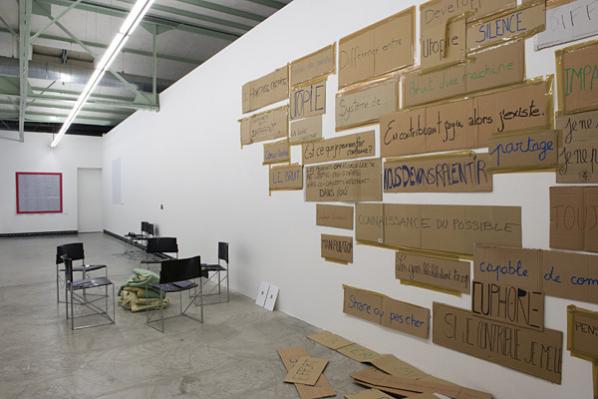
At the far end, a number of framed photo and images based pieces plus a work consisting of a single photograph and headphone delivered audio (it’s a snapshot – snapshot size, snapshot aesthetic – of husband and wife volunteer fire fighters. The audio is manipulated audio of texts on the subject of fear read by them. Let’s not try and place all this into any sort of context yet. Let’s set out our stall, enumerate, account, describe.)
A final deft touch is the symbolic linking of the two areas by a ribbon of text occupying the 15 or so centimetres above the floor, skirting board height, the topic of which appears to be mental illness (and all elegantly lettered except for one point where a letter had been omitted and is inserted with a caret symbol.)
Most of the pieces employ texts or performances – both gestural and textual – by others – often created according to some seed question or protocol. The texts often come from questions posed on the internet but sometimes from workshop or outreach type (type –this is to tentatively and provisionally locate the thing – it’s outreach Jim, but not as we know it) activity.
The performers in the moving image pieces are geographically dispersed but brought together at a single time by webcams and some custom software that Abrahams has used on a number of occasions where the web-cammed-in participants occupy a space in a rectangular grid (aficionados of seventies UK quiz shows such as Blankety Blank will get it immediately).
There’s a fragility, a delicacy, a tentative hold on existence, a testing of our belief, about these works that so many works of fine art – as opposed to design – have. The sense that what we have incorporates the idiosyncrasies, indeed the weaknesses of the support materials and media, into a final object (the same sense as when an artist wilfully uses something manifestly not intended for art, or allows mistakes to stand, or omits, or makes all too evident repairs; this is not new. Think pentimenti, or the hasty addition of an extra panel of canvas or paper to take account of expanding ambition or vision, or the aestheticized unevenness of Japanese tea-ware.) This sense of object-hood rather than message or statement is key. An objecthood which in retrospect could not have been other, but equally could not have been proposed, foreseen, except in its protocols of playfulness.
The pixellation, dropout, glitching, concomitant upon the pushing of the current state of the network to its limits in the multi participant pieces (and this reminds one of how flicker and roll and a general fuzziness become now part of the Acconci piece Abrahams draws upon in her Theme Song After Acconci – which reasons of space preclude too much detail about here – suffice it to say Abrahams honours, compresses, feminizes, satirises and intensifies the original. If Acconci could have had access to a “better” technology, one where the speed was constant, where no flicker or roll appeared, would he have then felt it served his purpose better? Did what he saw even look fuzzy or worn to him? Probably yes, compared with the film standards of the day, as does Abraham’s work compared with high end digital video [and even the current, rather good, quality of You Tube].)
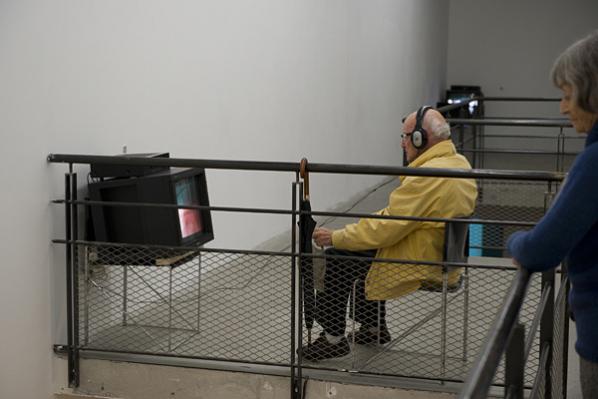
To offer participants a protocol is paradoxically both to assert and to cede control, to know and to not know how things will turn out (an analogy is the use of chance in the works of Polish composer Witold Lutosławski, where the mechanisms make the generality of the sound, its broad texture, predictable but any particular instance impossible to predict or even fully imagine [but all, please note, a matter of degree because the finer the grain, the greater the level of magnification, the more we can find such uncertainty in anything unfolding over time – it’s a question of our norms – what is the difference between the Stockhausen piano pieces where the performer can choose the order of segments and a Mozart sonata where the tempo may be quite widely varied? – in principle, none])
The piece Pourquoi avons-nous des difficultés à ouvrir un ordinateur et en changer le disque dur? plays on a single monitor with the screen divided into two areas. In each we see, sometimes with difficulty and ambiguously, parts of a computer, screws, connections and hands.
We hear two voices, one that of Abrahams and the other her co-performer, discussant, what have you, Eliza Fantozzi, speaking in French. In the version at Sète there are English subtitles which even for non English speakers provide a kind of functionality, meaning, in that the words tend to be positioned on a line from left to right according to who is speaking. When both speak suggestive gaps appear, though these cannot be read definitively).
The subtitles are in a strange (for a native English speaker) near-English (the title, for example, is translated as “Why do we have difficulties to open a computer and change its hard disk?”).
This is, it must be said, cute, amusing and engaging and it underscores the altogether naughty childlike quality of the entire interchange. The characters (for I think one should mistrust the assumption, however tempting, that we have here unmediated access to the actual participants) are playful – amused and amusing. At the same time they ruthlessly anatomise the roots of their difficulties with technology (but the performativity avoids being on–message in any sense and makes for something strange, complex and even uncomfortable. At one point Fantozzi complains of the lack of colour variety inside the machine and starts painting the components with nail varnish to “create a much merrier circuit” – Je crée un circuit beaucoup plus gai).
Later Abrahams lays into a ribbon connector with a pair of scissors and then starts apparently fringing it with regular cuts half way across … There is an association of the decorative, the playful and a rejection of the serious which is somewhat too close to many gender stereotypes to be entirely comfortable. (The piece was originally performed on international women’s day 2011) And yet, and yet – the end result is complex, for there is a steeliness to the play and a self respect and assertiveness. Perhaps (I don’t know. I don’t think there is a definitive answer. I don’t think close reading or theory can bring us it either) it is the very truthfulness, the richness of the incorporation of the world as it is and not as we might like it to be from which this springs.
Before we get to the physically largest and most imposing presence in the show we’ll look at its neighbour, comprising two chairs, a monitor and two sets of headphones.
Double Blind (Love) is a record of a 264 minute telematic performance by Annie Abrahams and the US artist Curt Cloninger which took place on November the 29th 2009. Annie Abrahams was in the Living Room (Espace de création contemporaine) Montpellier, France and Cloninger in the Black Mountain College Museum and Arts Center, Asheville, North Carolina, US.
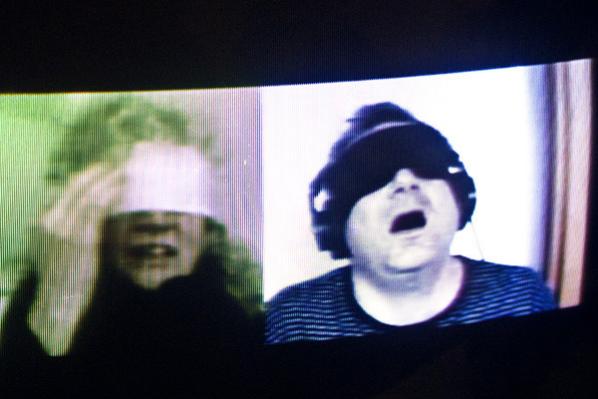
Both wore blindfolds for the entire duration of the performance, which was a joint telematic musical (and I use the word advisedly; though Abrahams describes Cloninger as a musician she appears to reject the description for herself. I think she is mistaken) performance taking the form of an improvisation, largely vocal but with some keyboard input from Cloninger, around a short musical cell from the track Until the End of the World by U2. The section in question has a repetition of the word “love” for its sole lyrical content and occurs just over midway through the song. It would perhaps ordinarily be described as a chorus but in fact appears only once in the song (although it continues as a backing vocal throughout the next verse), one of the first of many tiny idiosyncrasies on our pathway, peculiarities which add cumulative spice and interest to the project. I’d always found U2 banal and full of bombast but going to the song, under the circumstances of researching this piece, with necessarily open eyes and ears was a small epiphany, one of a number occasioned by a systematic engagement with Abraham’s work.
It’s worth noting that much of the structure of this piece came originally from Cloninger. In the previous year he had performed a number of pieces under the title “pop mantra” where in a live situation he repeated a similar pop music cell for a period of hours (“usually blindfolded”).
Cloninger had also video documented these performances though at this point this is documentation and lives no independent life of its own.
Let’s take a look at these proto ‘Double Blinds’. There is as yet no suggestion of interchange, of development. Although this is clearly a more obvious option with two performers, conscious development is not impossible in a solo performance. It does however appear to be consciously excluded. In an echo of the process or systems driven works of the seventies, Cloninger sets something in motion and allows it to unfold. He attempts to repeat the phrase many times. Presumably his arms start to ache and his voice to tire. This trial of endurance becomes a principal motor of the pieces. What does this evoke? For me, and you might share this, there are the dance marathons of the twenties, the notion of sport, especially individual sport, of pitting oneself against oneself; there is ritual repetition – Sufi whirling, or that carrying out of repetitive, gruelling and apparently pointless tasks sanctified in some Buddhist traditions; the pilgrimage; there is a kind of practical prayer through ritual, suffering or self-abnegation.
The motoric unwinding and associated characteristics obtain in Double Blind, too. What is new, what comes from Abrahams, is the telematic – the fact of separation by an ocean and the fact of collaboration. Indeed there is an inbuilt sharper contradiction as the collaboration separated by so much physical distance is of the peculiar intimacy that attends musical partnership, improvisatory or not. (A couple of years before Abrahams had performed a telematic kiss for three hours with the US artist Mark River.)
Despite Abraham’s denial the finished performance falls entirely within the established parameters of the musical. Precedents such as the work of Meredith Monk could be cited for Abraham’s compelling vocalisations – song, whisper, shout, scream, cry of pleasure, cry of pain – whose musico-dramatic logic and sensitivity to her performing partner, this listener at least, finds totally satisfying. It’s a touching partnership, with both performers bringing a fierce commitment to the task in hand but also each bearing different gifts – Cloninger, a formed musical sensibility supported by conventional skills and Abrahams a kind of discovery/invention of improvisation (indeed of music) ab ovo.
Thousands of years in 4 and half hours.
There is a formal challenge and satisfaction too, common to both Abraham’s and Cloninger’s concerns – how much transcendence can be mined, discovered, invented, from the small, the insignificant? Can it be exhausted before we are exhausted and what does the transfiguration brought about by the attempt suggest about us as human beings?
Two performers. Two chairs for two spectators only. Likewise, two sets of headphones.
Grace.
Opposite, stretching luxuriantly out, is the exhibition’s jewel in the crown – Angry Women, created by Abrahams and twenty two other women of many nationalities, speaking about anger; acting out, demonstrating, reflecting, on anger, on webcams from their different individual locations and in their native tongues, with the images being sent to the 3X4 grid, in a format that Abrahams has made her own. Because of the limits of even current streaming technology it was necessary to conduct two separate performances (separated by an interval of a couple of months). The length of each performance was determined by a protocol where a minute’s silence by all participants signalled the end. This resulted in pieces of differing lengths which lack of synchronisation adds another layer of fragile grace to the final projections, projected large on adjacent walls around the corner joining them with sound from the left images fed to the right speaker and vice versa.
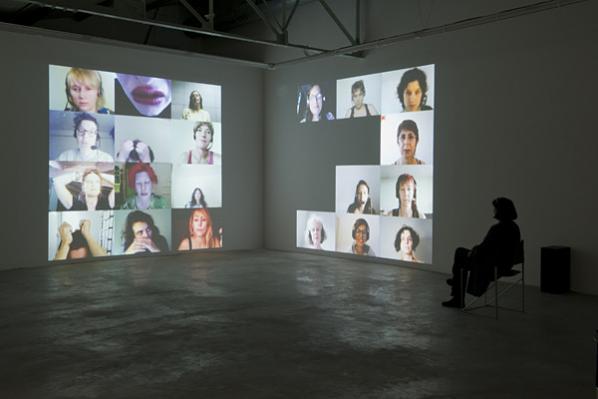
The effect is visceral – we face what feels like a wave of humanity, not so much in numbers, although 23 is impressive, but in the infinite malleability of the face, hands and of gesture and expression and of how these things can occupy the frame. Sometimes that frame will resemble a Giacometti portrait, with the subject appearing to recede into what seems to be endlessly deep space. At others red lips or an open mouth, sensual and terrifying by turns, occupy the whole of the space – and furthermore each cell is constantly in flux (because these are living, breathing unpredictable human beings). There is something both of portraiture and of the dance at work, and a species of found poetry too, which the moving image work has in common with the collaborative texts at the other end of the exhibition. The combination of iron control, planning, foresight (the grid, the protocols) with a letting go and a trust elsewhere – the phased lengths, the blank space for the person who didn’t turn up, the performative possibilities – makes for something of great richness.
Additionally it’s clear that those of the performers who have previous experience are consciously playing with and against their fellows – gestures are mirrored, sounds echoed, the fiction of looking elsewhere (to the side, or above) in the grid is impressively deployed.
The angry women turn out to be at one and the same time very particular –unique – women and women in general too; the women in general turn out to be human beings in general (and general en masse because each so particular) and the human beings in general turn out to live in this, one, our, very particular, world – that mysterious, frightening and wonderful place.
In keeping with the cheering on of lack of clarity, of mess, of crudity I’ve espoused so far in this piece (and will continue so to do, here and elsewhere) I want to say we need to take the exhibition (and the world) as a whole. Offering us the video and the still image pieces and audio means we cannot but think of them together (we can choose to artificially isolate pieces but we cannot undo our knowledge of that whole). So to the extent that I have selected topics here I have done violence to Abraham’s art, which has no message, is not confined to any one medium, collaborates in multiple ways, borrows, steals (and gives) and presents us with a set of marvellous and mysterious objects which afford us a spectrum of entirely new pathways to the world, to seeing it, talking and thinking about it, ourselves, after we have gone to the bar or got on the train north to Paris and thence homewards, happy and somehow a little changed.
—-
Training for a Better World – Annie Abrahams
Centre Régional d’Art Contemporain Languedoc-Roussillon, Sète, France
28/10/2011 to 01/01/2012
‘About 50% of global trade is channelled through tax havens and 83 of the 100 largest multinationals are based in the Netherlands for fiscal reasons. The flow of money seeks the path of least resistance – but where exactly do those paths lie today?’
This is how graphic designer Femke Herregraven began a presentation about her new online game Taxodus. Herregraven designed the prototype of Taxodus, a game about offshore tax avoidance, during a master class at Sandberg-Mediafonds. The offshore system offers companies advantages in countries where legislation relating to non-nationals guarantees certain privileges, for example, when it comes to corporate structures, in certain areas of business confidentiality, or low taxation. Taxodus is an accessible way to discover how you can avoid paying taxes, and if you can’t get away with it completely, how you can make sure you pay the lowest possible amount.
Annet Dekker: Taxodus is a game about offshore business practices. How does it work?
Femke Herregraven: As a player you choose an existing multinational company or bank with a specific profile and then you look for the most favourable countries to set up a subsidiary and accumulate income by paying as little tax as possible. Each country has a specific transaction profile. For example, companies involved with Intellectual Property Rights find the Netherlands most appealing, while oil companies are drawn to other countries. The game offers a random number of options and calculates what these yield for you. You can compare the results with other countries to achieve the game’s goal of reaching the end with as little expenditure as possible. The game is based on actual information on withholding tax in global tax treaties.
AD: This isn’t a topic you usually encounter in art. Where does your interest in this subject originate?
FH: In 2010 I was asked by the Virtueel Museum in Amsterdam to research the identity of the Zuidas during a residency. The Zuidas, which literally translates as ‘South Axis’, also known as the ‘Financial Mile’, is a large, rapidly developing business district in Amsterdam. Much like Richard Florida, they wanted to ‘cheer up’ the neighbourhood. My questions about the companies located there received only vague responses; there weren’t any lists, or names, or post boxes, and with the exception of known names like Google and Facebook, the other companies that are based there was a mystery. To trace what type of businesses might be located there I spent weeks indexing the entire Zuidas from the Chamber of Commerce’s trade register. I indexed the occupants by street and house number and then compiled three telephone books from the data. All sorts of unusual data and patterns became evident – some addresses only have one occupant, while others have more than a thousand of the so-called mailbox companies that only exist on paper. This is also apparent from the names: some only consist of Roman numerals.
All this information piqued my curiosity and I wondered why these companies were situated there and what they were up to. The next step was delving into Dutch tax law and it became clear that there are enormous financial benefits to setting up a company in the Netherlands. This is a major selling point when Holland is promoted abroad. The entire offshore system has operated below the radar for a long time – sometimes we catch a glimpse of it – but quite how it works in its entirety almost no one knows. The first step to understanding this is visualising it to gain insights, and then you can ask specific questions. Taxodus classifies this information by visualising it: from mining in the Congo to oil companies in Italy and Libya.
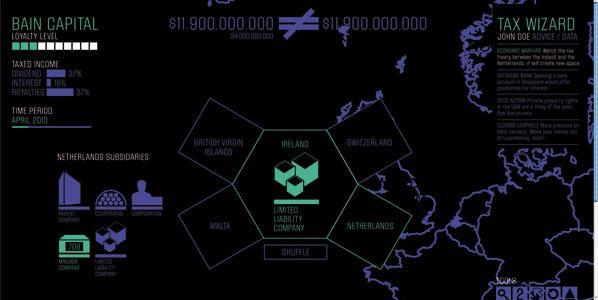
AD: It all sounds very murky!
FH: It’s all completely legal, but shady at the same time. If a foreign company doesn’t want to open a physical office in the Netherlands, it hires a trust office that takes care of the bookkeeping, drafts the annual reports and appoints a CEO. There are countless small trust offices that manage huge numbers of foreign companies on paper. Everything is done according to Dutch law and the tax benefits in Holland are hugely beneficial for foreign companies. For example, small businesses in the Netherlands pay more than thirty per cent tax, while foreign companies avoid a large part of that taxation due to tax planning. The presumption that foreign companies basing themselves in Holland is beneficial for national employment is also misleading because most of these companies only exist on paper and don’t employ anyone. The trust offices advise against opening a physical office and taking on any staff because Holland attaches great value to its employment policy, which makes dismissing personnel difficult. A ‘mailbox’ company avoids all these complications.
AD: But the way in which you visualise this is also subjective because you manipulate the data.
FH: Yes, I selected companies that people will know or which appeal to the imagination. Unfamiliar names won’t really be noticed, but once you realise that almost everyone participates in this system, from Mitt Romney’s Bain Capital, Walmart, Google and Facebook to Chanel, then it takes on a different immediacy or value for many people. If you look at this on a wider scale – globally – you will see, for example, that 60 per cent of large companies in Portugal, Italy, Greece and Spain use the Netherlands to take advantage of these types of constructions. This is legal and it’s also beneficial to the Netherlands, but when Dutch politicians insist on more transparency from Greece and lecture the country from up on high it smacks of hypocrisy. You see the same thing with a lot of development aid to countries in Africa: most of that money is diverted to the bank accounts of African leaders in offshore tax havens. Someone has done the maths: the debt of the entire African continent is less than the monies African leaders hold in offshore tax havens. A ‘mailbox’ company by itself is not that suspicious, but with everything else it creates the holes through which (public) money can disappear. My primary intention is to make these flows of money visible and question them, because once it’s out in the open people can decide for themselves if this is our idea of a sustainable economy.
AD: Of course, your game can also be interesting for existing companies who can use it to see where and how they can best invest? Is Taxodus the new Monopoly?
FH: Yes, in a way it is, but in reality companies have been doing this for ages. General Electric supposedly has a department employing about a thousand people who are busy with this on a full-time basis. I don’t think my game will suddenly improve things. Yet, the point is that the knowledge about international tax planning is now only in the hands of experts like fiscal lawyers and accountancy firms, and isn’t accessible to the rest of us. That’s also what Taxodus is about, making a tool so that we can track what they’re up to.
Monopoly is an interesting comparison because it originated as a critique of capitalism and private monopolies. The games are comparable, but Taxodus goes further. If you make a move in the game that correlates to reality then you are informed about this and receive a reality-bonus. It’s at this point in the game that investigative journalism comes into play.
AD: How do you relate to investigative journalism?
FH: My projects frequently begin from a journalistic position and for this one I meet with journalists, fiscal lawyers and researchers quite often. Yet, I’m a designer and I don’t want to write articles but use other methods to provide insights into topics. For me design is not an end in itself but a way to research, express and contribute to debates in society. This means also collaborating with other disciplines and experts: a group of fiscal experts is currently helping to remove errors and provide feedback. Obviously, it’s impossible to create a 1:1 translation, there will always be things that aren’t entirely accurate or that have to be left out, but it is important that the broad outlines are clear and correspond with reality.
AD: Why a game?
FH: Avoiding and evading tax is complex but you can learn the psychology of this system by playing the game. Taxodus is actually a kind of chess game. The rules aren’t simple and your eventual benefits depend on all sorts of interrelated factors. You have to continually take strategic decisions to advance in the game. All this information is incorporated into the game and the various tax treaties between different countries gradually become clearer. You are aided in this by advisors. At the start of the game you chose a particular advisor. Different advisors offer different advice, some will try to find legal alternatives while others try to convince you to bend the rules. Players can ask for a second opinion at any point in the game and manipulate regulations and treaties. This enables players to steer the game in the direction they choose. As in reality, a player has to have the possibility to have complete control. Ideally the game should be a do-it-yourself kit that you can add things to, an open game of strategy.
AD: What do you mean exactly? Can you name an example?
FH: The simplest way is to play it alone; the more complicated version is played with others in real time. At a certain point you can earn loyalty points by, for instance, evading high taxation for your parent company. Once you’ve arrived at the loyalty level, you can change roles, perhaps becoming a government employee who modifies regulations ever so slightly to make it more beneficial for yourself. You can also block other players in this way. This is an obvious reference to the increasing merging and blurring of the interests of large corporations and political leaders.
AD: How do you keep up with actual changes in the real world?
FH: It isn’t as if new information is constantly being made available – a lot of countries are reluctant or refuse to release ‘sensitive’ information. Tax treaties and regulation doesn’t change too often, but when they do, these changes will also be incorporated in the game. The English researcher Nicolas Shaxson, who is very active in charting the offshore system, says that people have to first become aware of what’s happening before they can think about how to deal with it. I hope my game and visualisations can contribute to this awareness raising.
AD: When or how does the game end?
FH: You have a certain amount of time before you have to submit an annual report for your company, then your trajectory is incorporated into the database and you can see what your score is. You can also compare it to other players and download their fiscal structure, which adds an element of competition and makes it a crowd-sourced investigation. By playing you contribute to the research and help expose the layers.
AD: Will Taxodus be a commercial success?
FH: My main concern is to make a tool that makes this small yet incredibly significant part of our opaque financial world more transparent, and especially more public. I think artists have a responsibility to broach topics like this. People find it all quite shocking when I tell them about Taxodus, but for those who are directly involved in the actual system it’s mere child’s play. This type of project can stimulate discussion and determine what is and what isn’t desirable.
This approach was shown to be successful with another project, the Art Reserve Bank. We set up a bank with a small group of artists and designers and introduced a new currency in the heart of the Zuidas as a way to encourage discussions about the financial sector. Our bank – a vault, an exchange counter and a glass house with a minting press: a bank brought back to basics – is located across from the ABN AMRO headquarters, and each day some of the employees and other people come by to see what we’re doing and have a chat. People also buy our coins, which are designed by a different artist each month. It doesn’t always go smoothly, but there is certainly enough curiosity. One problem is that people are personally interested but refuse to make any statements in a professional capacity. De Nederlandsche Bank (the Dutch central bank) recently sent us a letter stating that we cannot use the word ‘Bank’, threatened us with a fine of up to 2 million euros and invited us for a talk. These types of discussions are what we aim to achieve. Our goal isn’t necessarily to introduce a new currency; instead we want to underscore that fact that the bankers and financial experts of this world do not have exclusive rights to debate and decide what happens on financial markets.
———
A Dutch version of this interview appeared in Tubelight, September 2012.
Femke Herregraven: http://www.bitcaves.net
Sat 19 – Sun 20 January 2013: One Minute Volume 1-2
Sat 26 – Sun 27 January 2013: One Minute Volume 3-4
Sat 02 – Sun 03 February 2013: One Minute Volume 5-6
Contact: info@furtherfield.org
In partnership with 20-21 Visual Arts Centre, Furtherfield Gallery is pleased to host One Minute Volumes 1-6 curated by the film-maker Kerry Baldry over three consecutive weekends in January and February 2013. The programme will also be shown at 20-21 later in 2013.
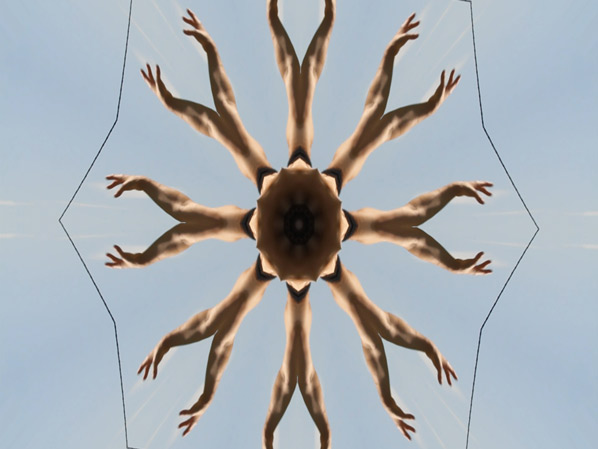
One Minute Volumes 1-6 are an eclectic mix of artists moving image constrained to the time limit of one minute and include over 80 artists at varying stages of their careers.
The artists involved range from established figures, such as Guy Sherwin and Catherine Elwes, to comparative newcomers through a multinational roster of those in between; and the methods deployed and content treated of are hugely diverse, a master class in the very short form film.
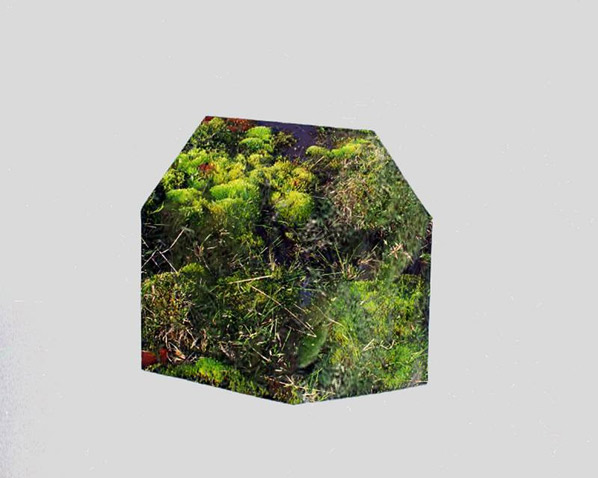
Gabrielle Schwartz writes in a recent review in Varsity, a Cambridge University publication:
‘There was no way of knowing what is going to come next; only that (while it might be beautiful, it might be funny, it might be incredibly weird) either way, it would be finished in a minute’s time – and so you might as well wait and see. This element of expectation as well as the consistently thought-provoking and entertaining quality propelled me through the volume, never once resulting in boredom’.
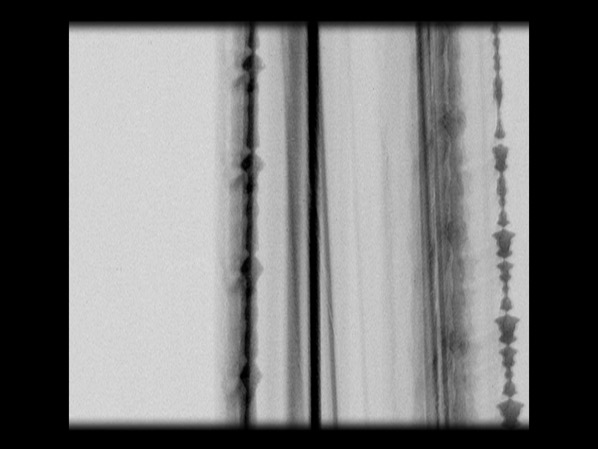
FACT in Liverpool, Artprojx Space – London, Directors Lounge – Berlin, London Underground Film Sessions – Horse Hospital, London. National Museum of Contemporary Art, in Bucharest, Plymouth Arts Centre, S1 Artspace – Sheffield, The Hull Short International Film Festival, Castlefield Gallery – Manchester, Peloton Gallery – Australia
Chris Meigh-Andrews, Kerry Baldry, Steven Ball, Kelvin Brown, Rose Butler, Daniela Butsch, Samantha Clark, Callum Cooper, Michael Cousin, Chris Paul Daniels, Gordon Dawson, Claudia Di Gangi, Fil Ieropoulos and Lilly Zinan Ding, Ron Diorio, Annabel Dover, Catherine Elwes, Clint Enns, Andy Fear, Unconscious Films, The Gluts, Dave Griffiths, Leister/Harris, Steve Hawley, Nick Herbert, Tony Hill, Virginia Hilyard, Elizabeth Hobbs, Riccardo Iacono, Hilary Jack, Tina Keane, David Kefford, Deklan Kilfeather, Kate Jessop, Nick Jordan & Jacob Cartwright, Esther Johnson, Helen Judge, Hollington & Kyprianou, Bob Levene, Barry Lewis, Lynn Loo, Paulo Menezes, Katherine Meynell, Louisa Minkin, Claire Morales, Kayla Parker and Stuart Moore, Jonathan Moss, Simon Payne, Alex Pearl, Gary Peploe, Martin Pickles, Stuart Pound, Laure Prouvost, Anahita Razmi, Emily Richardson, Nicki Rolls, Barbara Rosenthal, Jennifer Ross, Edwin Rostron, Matthew Rowe, Eva Rudlinger, Sam Renseiw and Philip Sanderson, Alex Schady, Janine Schneider, Margie Schnibbe, My Name Is Scot, Erica Scourti, Guy Sherwin, James Snazell, Tansy Spinks, Marty St.James, Priya Sundram, Michael Szpakowski, Richard Tuohy, Zhel (Zeljko Vukicevic), Phillip Warnell, Liam Wells, Mark Wigan, Michael Woody, Eleni Xintaras, Juan Zamora.
http://oneminuteartistfilms.blogspot.co.uk/
Produced by Furtherfield and 20-21 Visual Arts Centre.
Kerry BaldryKerry Baldry is an artist/filmmaker who works in a range of media including film and video. She is a Fine Art Graduate from Middlesex University who went on to study film and video at Central St. Martins. Her first commissioned film was to make a film for BBC2’s One Minute Television which was broadcast on The Late Show – a joint collaboration between BBC2 and Arts Council England.
Over the last 6 years, aside from producing her own work, she has been curating, promoting and distributing a self initiated, unfunded project titled One Minute, One Minute Volume 6 being the latest in the edition. One Minute Volumes 1-6 are an eclectic mix of artists moving image constrained to the time limit of one minute and includes over 80 artists at varying stages of their careers.
Furtherfield Gallery
McKenzie Pavilion, Finsbury Park
London N4 2NQ
T: +44 (0)20 8802 2827
E: info@furtherfield.org
Furtherfield Gallery is supported by Haringey Council and Arts Council England.
Millie Niss was known, first and foremost as a net artist. Her works tend to have interactive characteristics in them, with thought-provoking writing and the Dancing Rhinoceri of Bangladesh is exactly that, an interactive poem with a strong message.
A poem written for an interactive platform can be labelled many things, including ergodic literature[1], electronic literature[2], interactive fiction[3] and hypertext[4] to name but a few terms. ‘Writing, exterior to the mind requires equipment culturally constructed[5]’ to communicate it, and so in this case, the interactive platform is the equipment relevant to the cyberculture of the early twenty-first century. Interactivity is to cyberculture as typography is to traditional writing[6]. Initially, it may seem to be a simple task to read this poem that is laid out completely in one-screen that appears to have a fixed amount of words (seventy), but as we begin the journey of reading this interactive poem, we realise the potential it holds and the complexity of the work. It ‘requires that we understand electronic literature not only as an artistic practice (though it is that, of course), but also as a site for negotiations between diverse constituencies and different kinds of expertise[7]’.
This case study will be an exploration of how the Dancing Rhinoceri of Bangladesh can be understood and read in its various potentials, from the surface, looking at the interface and reader experience, to the text, as a reading exercise and finally to the core, exploring the source of its creation through technology.
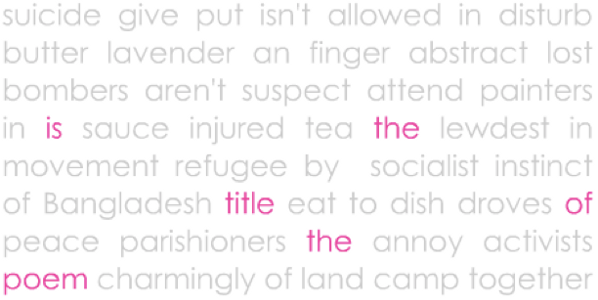
The Dancing Rhinoceri of Bangladesh welcomes readers with a looped instrumental soundtrack and the first highlighted sentence of ‘this is the title of the poem’ (see image below). The soundtrack, though Asian sounding, has more of an Oriental influence to it than Bangladesh, but it is still effective. With a strong rhythm and a clear tune played by a stringed instrument, the music sets a light mood for the reader. Catchy and short, the never-ending loop of music hooks the reader in.
As one explores the poem by moving the mouse around the page, it becomes obvious that mouse-movements over certain words trigger changes in the highlighted words. Certain words also trigger verbal sentences or oral commentary[8].
The speed in which a reader explores the poem through mouse movements will create different experiences. Slow movements will allow readers to read and take in the various highlighted sentences in ‘an apparently random order[9]’, whilst fast movements will create a sort of chaos where more than one oral commentary may be triggered at the same time creating audio overlaps whilst the pink highlighted words will seem to randomly light up the page.
The simplicity of the colour scheme works very well to complement the poem itself. With just the colours pink and grey, it creates a pleasant atmosphere for the reader, whilst being serenaded by the non-intrusive exotic music. Since the triggers require only the movement of the mouse and do not require any clicking, the reader experience can be a simple one. There are also no pause periods required for page loadings during reading where there would usually be in hypertext. As Millie Niss tells us,
‘My goal was to make a textually-based work that uses techniques other than ordinary hypertext. So instead of clicking to get to a new part of the poem, all the text is presented on the screen at once… The content is revealed by mousing over a word which highlights words scattered across the field which combine to form a sentence.[10]’
This calm and pleasant atmosphere the poem creates for the reader in its visual and audio stimulations creates a juxtaposition to the message and meaning the poem itself brings. We will explore this in the next section.
Before moving on though, it is important that we acknowledge that this poem may be appreciated in the genre of concrete poetry as well, due to it’s visual nature where ‘the object is to present each poem as a different shape[11]’. The shape in this case, is a square, with seventy words listed within it. ‘It is… a matter of pictorial typography which produces ‘visual poetry’’ and ‘it may be on the page, or on glass, stone, wood and other materials[12]’. If the interactive element of the poem is to be removed, leaving only seventy words on the page, it would still stand to communicate the same message albeit in a slightly different manner. It would also serve to ‘bombard the user with all the data at once[13]’, rather than presenting the arrangement of lines of poem to the reader. The interactivity takes in elements of generative art ‘whereby an algorithm is used either to generate texts according to a randomised scheme or to scramble and rearrange pre-existing texts[14]’. In this case it would be the latter, a rearrangement of pre-existing texts.
In a detailed reading of the Dancing Rhinoceri of Bangladesh, it becomes apparent that every word listed on the page represents a sentence that appears highlighted or is an oral commentary. See Appendix A for a transcription of the entire poem.
In its basic literary form, it is a surrealist poem. Millie Niss tells us this directly in the lines ‘the surrealist did this without all this technology’ and ‘to understand is not the point’[15], describing it as ‘a combinatorial excursion into the textual possibilities of rhinoceri and other matters[16]’. Surrealist artists loved the iconic rhinoceros and used it as a muse in writing and in art. Salvador Dali was obsessed with the rhinoceros’ horn as he thought that it was ‘divine geometry because it grew in a logarithmic spiral[17]’. Eugene Ionesco, a surrealist playwright famously wrote Rhinoceros, a play about a French city, where the people slowly turn into rhinoceros, until only the protagonist is left as the only human[18]. A more subtle but bizarre use of the rhinoceros is perhaps by Roald Dahl in his book James and the Giant Peach, where James’ parents were eaten by ‘an enormous angry rhinoceros which had escaped from the London Zoo[19]’. Not only is the context surreal, it is also contradictory as the rhinoceros in its true nature is an herbivore.
The surrealists attempted to express in art and literature the workings of the unconscious mind and to synthesise these workings with the conscious mind. The surrealist allows his work to develop non-logically (rather than illogically) so that the results represent the operations of the unconscious.[20]
The non-logical development of the Dancing Rhinoceri of Bangladesh can probably be seen in the lack of structure, which itself is non-conforming towards poetry. The apparent random nature of the highlighted selection of words coupled with the uncontrollable force that is the reader and mouse movements create the synthesis of the unconscious and conscious mind, mimicking the way our eyes and brains would pick words out of a paragraph when we read or glance at writing to gauge the meaning of the text quickly, creating a ‘charming piece of stream of consciousness[21]’. In fact, it is what Lev Manovich says is ‘the very principle of new media… [it] objectifies the process of human thinking which involves connecting ideas, images, [and] memories[22]’.
The poem, as in any piece of art, carries a message or meaning. Where much of electronic poetry ‘can focus too much on the look of the poem and not the meaning[23]’, Millie Niss ‘tried to evoke a mood and some plot elements so that the poem had some core context and was not merely a random assortment of sentences[24]’. This can be seen from the direct hints that Millie Niss leaves us in the following lines:
they won’t like this in Bangladesh
it sounds like newspaper headlines
you shouldn’t glorify bombers
From these, we know that the poem is about bombers in Bangladesh that have recently (in reference to when the poem was published) been reported in the news. This aggressive and violent topic juxtaposes the visual and audio display as mentioned earlier.
Tracing these points back to the historical, cultural and political references, we can see that in 2001, the Islamist organisation, Jamaat-Ul-Mujahideen became noticed widely in Bangladesh due to bombs and documents being discovered[25]. Also, 11 September 2001 saw international fear and paranoia of terrorism, especially in America when the World Trade Centre in New York was attacked. Millie Niss then published the Dancing Rhinoceri of Bangladesh in 2002[26].
The poem gives us some indirect hints as well in the following lines:
are the rhinoceri from the zoo
is this a modern plague of frogs
isn’t the rhinoceros an herbivore
tyrannical rhinoceri disturb peace activists
book this abstract suspect socialist poem
These suggest that the rhinoceri represent bombers, questioning if the bombers portray animalistic behaviour, questioning the actions of killing when assuming that the basic nature of humans are good and kind (in the herbivore reference). The plague of frogs suggests a biblical reference of a tyrannical power, creating further unease in the poem by placing Christianity and Islam together.
From here, we can see that irregardless of how the poem is read and what order a reader may move the mouse in, the core meaning of the poem remains the same. This is the case, even if as mentioned in the earlier section, the poem is read without the interactivity and just as a concrete poem; the words laid out will suggest and bring across the meaning intended.
Although the poem may seem surreal and random at first, we know now that meaning was fully intended and in the next section, we will see how technology is used to create exactly what Millie Niss wanted the poem to do.
Technical terminology for writing in media has been discussed heavily in the last twenty years or so, amassing various names and genres that may mean the same thing, or may be slightly or even drastically different. Some of these terms were listed in the introduction of this paper and when explored, create a problematic area of definitions. This can be seen from Espen J. Aarseth’s introduction in Cybertext, Perspectives on Ergodic Literature where he spends a considerable time defining the differences in terminology and areas of subjectivity. The key area that I would like to highlight from it is the focus on what the literature is being read from[27]. As Jessica Helfand puts in bluntly, ‘the rectangle of the computer monitor frames everything we see on screen.[28]’
In the context of the Dancing Rhinoceri of Bangladesh, the term electronic literature is probably the most appropriate. It is exactly what it says, literature that is presented and thus read from an electronic platform. And in most electronic literature, it is ‘texts that can only be read in a virtual environment[29]’. The characteristics of new media as described by Lev Manovich[30] and Martin Lister et al.[31] will be used below to help describe what the term electronic means for the Dancing Rhinoceri of Bangladesh.
The Dancing Rhinoceri of Bangladesh was created with Macromedia Flash, which is now known as Adobe Flash. It is a multimedia platform software that is used to add animation, video and interactivity to web pages. Though Millie Niss started computer programming since the age of eight, she says that her becoming a net artist was accidental and due to the fact that she had bought ‘a copy of Macromedia Flash in 1999 without knowing exactly what it was[32]’ which she then ‘realised almost immediately that the software’s multimedia capabilities allowed (her) to create an immersive experience… instead of a flat description[33]’.
In order to manipulate this software to be able to create the Dancing Rhinoceri of Bangladesh, Millie Niss would have needed to have the complete layout planned, including how the words were to be arranged on the screen, what effect each mouse movement would have and all the design characteristics. What seemed random to the reader would have been organised at creation. This was misrepresented in a review of the poem where it was said that ‘it is not a poem that was written first then put into an electronic setting[34]’. Due to the detailed programming required in Flash, it would not be technically possible for Millie Niss not to know what sentences or poetry lines she was going to use from the start. The triggers and layout may have perhaps been developed or manipulated during the programming phase but the poetry lines would have had to have been written or decided together with the seventy words.
As we know, there are seventy words distributed across the screen. When each sentence is highlighted, it is clear that the arrangement of the words were carefully placed, to allow a somewhat equal spread across the screen. This allows the reader to read the sentences from top to bottom (left to right) comfortably and that the sentences are never too bunched up in a corner. This represents digital and digitisation where each word can be seen as a discrete unit where all digital things are made of discrete units that are put together to create it.
Although mouse actions clearly create movements within the poem, this is a new media trick, where every movement is actually accompanied by a still image and the idea of change is one that is simulated in our mind or thought process. Every still image is fixed and programmed by Millie Niss, accompanied with clear instructions as to what (movement) triggers each image. ‘With the help of a mouse,… a computer can be transformed into an intelligent being capable of engaging us in dialogue.[35]’ The sound track, which itself is a loop that is continuously repeated, helps create the illusion of seamless movement. ‘The computer can seamlessly generate both text and sound because both are ultimately represented in binary code[36]’ which is digital. This phenomena can be compared to what is known as modularity or fixity and flux, which describes all digital things to be in a fixed state at all times. It is the manipulation of the user, through programmed instructions in each case that affects a change, represented by modularity or flux, but at every point of modulation or flux, they are still fix states.
The mouse movements also represent automation where triggers automatically bring up images that have been pre-programmed. This is similar to hypertextuality, but where hypertext would require the reader to actually click on each trigger point, the automated triggers make this more interactive. Although in this case, the highlighted texts are not randomly generated and are purposely programmed, it still references both cognitive modes of human thinking and machine execution, in which Stephanie Strickland emphasises on in ‘Writing the Virtual: Eleven Dimensions of E-Poetry’ in what she calls recombinant flux. Millie Niss, together with Martha Deed later wrote Oulipoems in which randomisation is fully adapted[37].
Like hypertext, interactivity in the poem creates non-sequential writing and creates variability for the reader. Every reading experience, by different or similar people will be different. The order in which the sentences are read or heard will differ. Further, depending on what hardware and software the reader uses to access this poem, the reading experiences are heavily affected. For example, a reader who do not have speakers on or attached to the computer may miss the soundtrack and oral commentary. Some computers may not have Adobe Flash player installed, so readers may need to do the installation themselves before reading, in which case, some readers may not even bother, either due to tediousness or computer illiteracy issues.
This is the computer layer that is the master of the poem. The cultural layer can be seen as the context and message of the poem itself, but without the computer layer, it cannot be accessed, as ‘Alexander Galloway in Protocol puts the case succinctly: “Code is the only language that is executable”. Unlike a print book, electronic text literally cannot be accessed without running the code[38]’.
This is a crucial issue for electronic literature when compared to traditional print literature. The lifespan and view-ability of electronic literature is completely dependent on accessibility and promotion. When Millis Niss wrote and published the Dancing Rhinoceri of Bangladesh, Macromedia Flash was the latest technology for interactive web applications. Most web platforms supported it. However, today, although Adobe boasts that the Adobe Flash Platform can ‘provide everything you need to create and deliver compelling applications, content, and video to the widest possible audience across screens and devices[39]’, it is not actually as accessible as it says due to recent developments on mobile platforms, costs and licensing factors. It was only earlier in November 2011 that the company announced that they will not be continuing with Mobile Flash developments, which allows their closest competitor, HTML5 to overtake them in the lead. This is also driven by the fact that Adobe Flash requires a private paid license whereas HTML5 is a shareware, with open networks of developers. This news also raised the question of lifespan for Adobe Flash for computers, suggesting that it won’t be long before Adobe Flash would be obsolete[40].
What happens to the Dancing Rhinoceri of Bangladesh when Adobe Flash becomes defunct? Whilst we ponder on that question, the accessibility of it is slowly reducing and less people will not only not know about the poem, but even if they did, may not be able to access it.
“The problem exists for both software and hardware. Commercial programs can become obsolete or migrate to new versions incompatible with older ones, and new operating systems (or altogether new machines) can appear on which older works will not play. With a foreshortened canon limited to a few years and without the opportunity to build the kinds of traditions associated with print literature, electronic literature risks being doomed to the realm of ephemera, severely hampered in its development and the influence it can wield.[41]”
***
The Dancing Rhinoceri of Bangladesh is more than just a poem. As with all electronic literature, it requires more than just literacy to access, understand and appreciate. It is a piece of art, which carries in itself, cultural, historical, political and technological implications and meanings. Though it is a literary genre that is starting to gain recognition in the mainstream, the future of electronic literature depends on the future of technology and how old technology is archived and preserved, for in its core, it is ultimately a form of new media and net art.
[1] Espen J. Aarseth, Cybertext: Perspectives on Ergodic Literature (Baltimore, USA: John Hopkins University Press, 1997)
[2] Electronic Literature Organisation, http://eliterature.org/ Accessed 30/12/11
[3] N. Katherine Hayles, Electronic Literature: New Horizons for the Literary (Indiana, USA: University of Notre Dame, 2008) p.8
[4] Various
[5] Ellen Lupton and J. Abbott Miller, Design Writing Research, Writing on Graphic Design (London: Phaidon Press, 2006) p.5
[6] ibid.
[7] Hayles, Electronic Literature p.38
[8] Millie Niss, Why I Write for the Web, http://www.secretsaunasirens.com/2009/10/spork-was-born-in-arctic-as-all-good.html Accessed 30/11/11
[9] Niss, Why I Write
[10] ibid.
[11] The Penguin Dictionary of Literary Terms and Literary Theory, 1999 ed. p.171
[12] ibid.
[13] Lev Manovich, The Language of New Media (USA: Massachusettes Institute of Technology, 2001) p.77
[14] Hayles, Electronic Literature p.18
[15] see Appendix A
[16] Lynda Rutledge Stephenson, Literature in Cyberspace http://lowres.uno.edu/classes/cyberlit/papers/roadtrip/roadwaye-essay.pdf Accessed 30/11/11
[17] Biography of Salvador Dali, http://www.biographyonline.net/artists/salvador-dali.html Accessed 30/12/11
[18] Rhinoceros by Eugene Ionesco, http://www.rhinoionesco.cjb.net/ Accessed 31/12/11
[19] Roald Dahl, James and the Giant Peach, (London: Puffin Books, 2001) p.7
[20] The Penguin Dictionary of Literary Terms p.882
[21] Appendix B, Response 4 from Ksenia Scherbino
[22] Lev Manovich, On Totalitarian Interactivity, http://manovich.net/TEXT/totalitarian.html Accessed 28/11/11
[23] Lauren Ramstad, Electronic Poetry as Literature, 2009 http://www.uweb.ucsb.edu/~laurenramstad/Untitled-3.html Accessed 30/11/11
[24] Niss, Why I Write
[25] Jamaat-Ul-Mujahideen http://globaljihad.net/view_page.asp?id=993 Accessed 30/11/11
[26] Sporkworld http://www.sporkworld.org/webpub.html Accessed 30/11/11
[27] Aarseth, Cybertext p.1-23
[28] Helen Armstrong (ed.) Graphic Design Theory, Readings from the field (NY: Princeton Architectural Press, 2009) p.121
[29] Ramstad, Electronic Poetry as Literature
[30] Manovich, The Language of New Media
[31] Martin Lister et al. New Media: A Critical Introduction, Second Edition (UK: Routledge, 2009)
[32] Niss, Why I Write
[33] ibid.
[34] Review, Rhinoceri and Faith http://april-litresponse.blogspot.com/2010/02/rhinoceri-and-faith.html Accessed 30/11/11
[35] Manovich, The Language of New Media p.94
[36] Hayles, Electronic Literature p.145
[37] Millie Niss and Martha Deed, Oulipoems http://collection.eliterature.org/1/works/niss__oulipoems.html Accessed 01/01/12
[38] Hayles, Electronic Literature p.35
[39] Adobe Flash Platform, http://www.adobe.com/flashplatform/ Accessed 31/12/11
[40] Charles Arthur, Adobe killed mobile Flash, giving Steve Jobs the last laugh, The Guardian Technology, 9 November 2011 http://www.guardian.co.uk/technology/2011/nov/09/adobe-flash-mobile-dead Accessed 31/12/11
[41] Hayles, Electronic Literature p.40
Books and Journals
Helen Armstrong (ed.) Graphic Design Theory, Readings from the field (NY: Princeton Architectural Press, 2009)
Espen J. Aarseth, Cybertext: Perspectives on Ergodic Literature (Baltimore, USA: John Hopkins University Press, 1997)
Haskell M. Block, ‘Surrealism and Modern Poetry: Outline of an Approach’, The Journal of Aesthetics and Art Criticism, Vol.18 No.2 (Dec 1959): 174-182
Roald Dahl, James and the Giant Peach, (London: Puffin Books, 2001)
Rachel Greene, Internet Art (London: Thames & Hudson Ltd, 2004)
N. Katherine Hayles, Electronic Literature: New Horizons for the Literary (Indiana, USA: University of Notre Dame, 2008)
Martin Lister et al. New Media: A Critical Introduction, Second Edition (UK: Routledge, 2009)
Ellen Lupton and J. Abbott Miller, Design Writing Research, Writing on Graphic Design (London: Phaidon Press, 2006)
Lev Manovich, The Language of New Media (USA: Massachusettes Institute of Technology, 2001)
Hamlet on the Holodeck, The Future of Narrative in Cyberspace (NY: The Free Press, A Division of Simon & Schuster Inc., 1997)
Christiane Paul ed. New Media in the White Cube and Beyond – Curatorial Models for Digital Art (US: University of California Press, 2008)
Reference Materials
The Penguin Dictionary of Literary Terms and Literary Theory, 1999 ed.
Web Articles
Charles Arthur, Adobe killed mobile Flash, giving Steve Jobs the last laugh, The Guardian Technology, 9 November 2011 http://www.guardian.co.uk/technology/2011/nov/09/adobe-flash-mobile-dead Accessed 31/12/11
Lev Manovich, On Totalitarian Interactivity, http://manovich.net/TEXT/totalitarian.html Accessed 28/11/11
Millie Niss, Why I Write for the Web, http://www.secretsaunasirens.com/2009/10/spork-was-born-in-arctic-as-all-good.html Accessed 30/11/11
R. D. Pohl, Millie Niss (1973-2009), Buffalo News ArtsBeat, 7 December 2009 http://blogs.buffalonews.com/artsbeat/2009/12/millie-niss-19732009.html Accessed 30/11/11
Lauren Ramstad, Electronic Poetry as Literature, 2009 http://www.uweb.ucsb.edu/~laurenramstad/Untitled-3.html Accessed 30/11/11
Scott Rettberg, Dada Redux: Elements of Dadaist Practice in Contemporary Electronic Literature http://eleven.fibreculturejournal.org/fcj-071-dada-redux-elements-of-dadaist-practice-in-contemporary-electronic-literature/ Accessed 30/11/11
Lynda Rutledge Stephenson, Literature in Cyberspace http://lowres.uno.edu/classes/cyberlit/papers/roadtrip/roadwaye-essay.pdf Accessed 30/11/11
Biography of Salvador Dali, http://www.biographyonline.net/artists/salvador-dali.html Accessed 30/12/11 Jamaat-Ul-Mujahideen http://globaljihad.net/view_page.asp?id=993 Accessed 30/11/11
Review of Rhinoceri and Faith http://april-litresponse.blogspot.com/2010/02/rhinoceri-and-faith.html Accessed 30/11/11
Web sites
Adobe Flash Platform, http://www.adobe.com/flashplatform/ Accessed 31/12/11
Electronic Literature Collection, Volume 1 http://collection.eliterature.org/1/ Accessed 01/01/12
Electronic Literature Organisation, http://eliterature.org/ Accessed 30/12/11
Netpoetics.com, http://netpoetic.com/ Accessed 30/11/11
Rhinoceros by Eugene Ionesco, http://www.rhinoionesco.cjb.net/ Accessed 31/12/11
Sporkworld by Millie Niss and Martha Deed http://www.sporkworld.org/ Accessed 30/11/11
APPENDICES are available upon request. Please email yen(at)yenooi.com
This paper was initially written for a postgraduate assignment. As this is a working version, please note that it should not be cited yet unless the author is contacted first. To do so, please email yen(at)yenooi.com.
This work is licensed under a Creative Commons Attribution-NonCommercial-NoDerivs 3.0 Unported License.
I met Eugenio Tisselli in Edinburgh at the Remediating the Social conference in November 2012. Eugenio gave a presentation on the project Sauti ya wakulima, “The voice of the farmers”: A collaborative knowledge base created by farmers from the Chambezi region of the Bagamoyo District in Tanzania, and “by gathering audiovisual evidence of their practices they use smartphones to publish images and voice recordings on the Internet”, documenting and sharing their daily practices.
I was struck by his sensitivity to the social contexts and political questions around this type of project engagement. This interview explores the challenges we all face in connecting to a deeper understanding of what technology can succeed in doing beyond the usual hype of the ‘New’ and its entwined consumerist diversions. Not only does the conversation highlight how communities can work together in collaborating with technology on their own terms. But, it also discusses the artists’ role in the age of climate change and the economic crisis, locally and globally.
Marc Garrett: Can you explain how and why the Sauti ya wakulima, “The voice of the farmers” project came about?
Eugenio Tisselli: Sauti ya wakulima is the fruit of my collaboration in the megafone project, started in 2004 by Catalan artist Antoni Abad. During six years, we worked with different groups at risk of social exclusion, such as disabled people, immigrants or refugees. The idea was to provide these groups with the tools to make their voices heard: smartphones with a special application that made it easy to capture images, sound recordings or short videos, and a web page where these contents could be directly uploaded. Using these tools, the participants of each project were able to create a collaborative, online “community memory”, in which they could include whatever they considered to be relevant. Although megafone was relatively successful and, in some cases, made a positive impact on the people who participated, I was worried that the project was becoming too dispersive. We worked in six countries, with extremely different groups. So, in 2011, I decided to follow my own path and apply a similar methodology into more focused projects, related with sustainable agriculture and environmental issues. I realized that the projects which sought to increase the empowerment of a community could become too complex for a single artist to handle. That’s why, in Sauti ya wakulima, I’m not “the artist”, but a member of a transdisciplinary team which includes biologists, agricultural scientists and technicians. Such a team came together after my PhD advisor Angelika Hilbeck, my colleague Juanita Sclaepfer-Miller and myself came across the possibility of working with farmers in Tanzania. The network formed by local researchers, farmers and ourselves was quickly formed, so we started the project on March, 2011.
MG: I find it interesting that you made the decision to put the role of artist aside. This reminds me of a discussion in Suzi Gablik’s book published in 1995 ‘Conversations before the end of time’; where James Hillman in an interview talks about learning to refocus our attention from ourselves and onto the world. Further into the conversation Gablik says “In our culture, the notion of art being a service to anything is an anathema. Service has been totally deleted from our view point. Aesthetics doesn’t serve anything but itself and its own ends”.[2]
So, I have two questions here. The first is how important was it for you to put aside your status as an ‘artist’, and what difference did it make?
And, where do you think you and others may fit when considering the discussion between Gablik and Hillman?
ET: It is important for me to make it clear that I didn’t abandon my role as an artist. Instead, I fully assumed my status, but only as a member of a transdisciplinary team. I believe that this may be a point of departure from the classical view of the artist as a “lone genius”, which is closely related to the discussion about service in art. So I’ll try to interweave both questions together. In a recent publication, Pablo Helguera aimed to set a curriculum for socially engaged art. He identified the new set of skills to be acquired by the artists, and the issues they must address when dealing with social interaction. But, as Helguera suggests, perhaps what’s most important is to overcome the “prevailing cult of the individual artist”, which becomes problematic for those whose goal is “to work with others, generally in collaborative projects with democratic ideals.” [3] To me, this implies that the artist must give up control of the work to a certain degree. I find myself in this scenario, and I think of my role in Sauti ya wakulima as that of an instigator and coordinator. Furthermore, all of us involved in Sauti ya wakulima aim to effect actual changes in the lives of the participating farmers, rather than obtaining purely symbolic results. Our project is a socially engaged artwork that wants to be useful, to deliver a service.
We are living in urgent times, beyond any doubt. Looming global challenges, such as climate change, radically cancel the luxury of being useless, of not doing anything. This includes the artist who, as any other citizen, is called to use his or her abilities to help in preventing a catastrophe. I especially like Franco “Bifo” Berardi’s proposal about the new task that the artist might assume: that of reconstructing the conditions for social solidarity. This work of reconstruction would oppose competition, a value often found in the markets that deal with self-referential, self-serving artworks. Solidarity, writes Berardi, is neither an ethical nor a political program, but a pure aesthetic pleasure [4]. In my opinion, the artists who still embrace the idea that art should only serve its own ends will become those who play the lyre while our world burns.

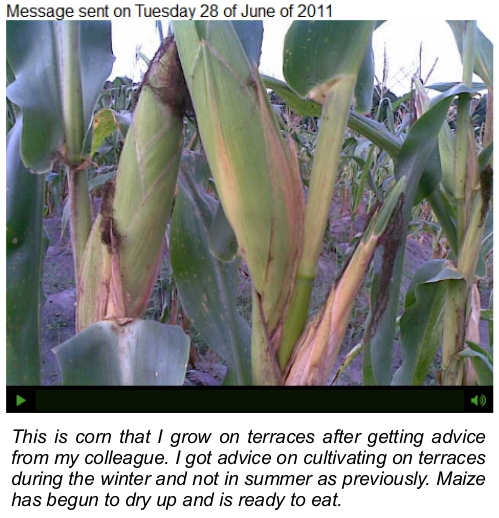
MG: What kind of behaviours began to emerge once the farmers took control of the smartphones supplied?
ET: It was quite interesting to see that the farmers started to use the phones for purposes which were different from those that we had originally proposed. This happened very soon after the project started. Only one month had passed, and the farmers had already started to go beyond merely documenting the effects of climate change. They interviewed other farmers, and asked them all sorts of questions about their crops and agricultural techniques, their opinions and views. In short, they slowly laid out a web of mutual learning. This was a real eye-opener for us. As we began to observe this, the environmental researchers in the team became worried that the farmers were deviating from the goals that we had set. I wanted to leave room for this deviation, as I was particularly interested in studying the process of technological appropriation. So I had to convince the researchers that we should leave enough room for the farmers to freely explore the potentials of the smartphones. It was not easy but, in the end, negotiating the tensions between a goal-oriented and an open-ended research turned out to be quite fruitful.
On one hand, the farmers found that they could shape the project to fit their interests which, as they said, were to “learn about what other farmers in remote areas were doing.” On the other, the researchers finally realized that the images and voice narrations posted by the farmers were an invaluable source of information about what was actually going on in the farms and within the communities. Sometimes, agricultural initiatives may be designed with an insufficient understanding of the social context in which they are applied. By allowing the farmers to publish a wide range of topics, Sauti ya wakulima became a “community memory” that reveals rich details about farming and the social life of rural communities in Bagamoyo.

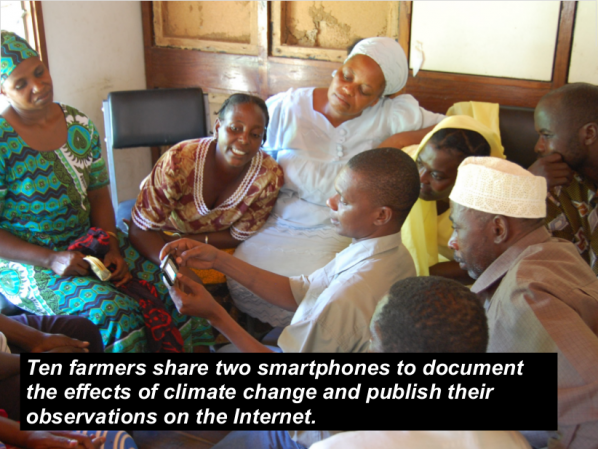
MG: In your presentation at Remediating the Social, I remember a quote from one of the farmers saying “The project helped me learn that phones can be used for other things besides calling people, and that computers can also be used to solve problems: they are not just a fancy thing for the rich people in towns.” What’s interesting here is, these words could be said any where. And that our consumer orientated culture could still learn a few things regarding uses of technology.
What lessons can the farmers teach ‘us’ in a culture where computers are part of the everyday life?
ET: I have interpreted this particular quote in two different ways. The first, most obvious one, is that the farmers discovered that the smartphones and the web can be useful tools, which may be shaped and adapted to meet their needs. For many of them, Sauti ya wakulima was their first chance at trying out these technologies. And, happily, the project showed us all that they can become an important ingredient in making farmers’ lives a little better.
However, my second interpretation is not as optimistic: in the quote, there is an explicit comparison between the (poor) farmers living in remote areas and “the rich people in towns.” Moreover, the fact that smartphones are explicitly considered as fancy devices points towards issues which need to be handled very carefully. In every part of the world, technological gadgets are quickly becoming symbols of social status. Currently, I am working in a rural zone in southern Mexico where cellphone coverage was nonexistent only two years ago. But as soon as the first antennas were installed, young people in those communities started buying smartphones, and now there is an open competition to see who has the fanciest one. A similar thing happens in Bagamoyo.
So, of course, smartphones can be useful tools, but they can also bring more consumerism into poor communities. This is very dangerous. I’d like to stress that, in our project, the smartphones are used as shared tools. This means that there is a limited number of devices available, and everyone must have a chance to use them at least once. I believe that this is a small but significant contribution towards diluting the extreme individualism and consumerism that are closely linked to these technologies.
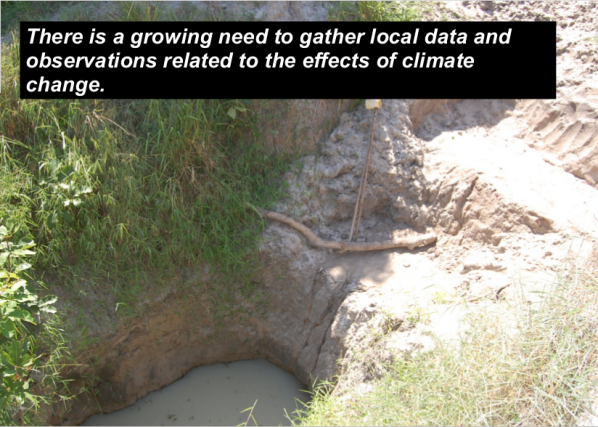
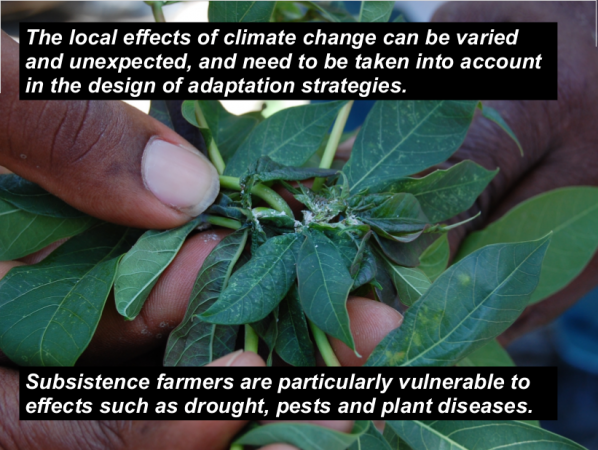
The farmers I have met in Bagamoyo have a very strong sense of community. Although their farms can be very far apart, sometimes with no roads between them, they still get together very often. They work together, learn together, have fun together. That’s the biggest lesson I’ve learned: we need each other’s presence. Quoting “Bifo” again, we are living in a time of precarization of the encounter of bodies in physical space. I agree with him that the most important poetic revolution has to be the re-activation of bodies. The farmers, with the great efforts they make to get together, and the great joy they find in doing so, have taught me a great deal: I need to get out of Facebook and step in to the “here and now”, together with others.
MG: What has this experience taught you. And how will it impact your future practice as an artist?
ET: I have partially replied to the first part of this question. But besides learning how to re-dimension the importance of computers in my life, I have also learnt a lot about agriculture. This is not a minor thing for me: after all these years of living in big cities, and realizing that I lack a basic connection to the earth, I believe I have found the best possible teachers. Of course, I’ve also learnt a lot about how to work with non-expert users of technology. This has made me better as a teacher. And, as you can imagine, many of the things we take for granted at home won’t necessarily work in Bagamoyo. So, doing projects in difficult environments has taught me to adapt, and to transform things that escape my control into opportunities. All of this changes me, not only as an artist but as a human being. My artistic practice is already quite different from what it was before Sauti ya wakulima. I have adopted a very critical position towards technology. Now, this is also a major shift: I started programming creatively when I was ten years old, and have been a media artist almost since then. But I feel I can’t go on with those artistic explorations, knowing what I know now. Consequently, last year I wrote and published a small note explaining why I stopped creating works of e-Literature, a field in which I was involved for more than ten years [5]. That was both a closure and a point of departure. Let’s see what the future brings.
Excerpt from ‘Why I have stopped creating e-Lit’ by Tisselli (November 25th, 2011)
Dear friends: this morning I went for a walk along the Naviglio Grande in Milan, and I entered a shop selling second-hand books. There I found a small book, “The Computer in Art”, by Jasia Reichardt, published in London in 1971. The book described the works of pioneers of Computer Art, such as Charles Csuri or Michael Noll, who were active at that time. A real gem. But the biggest surprise came when I turned to the last page, on which the previous owner had written: “I married on 23, November. I would like to be a man, not artist, not engineer, a man.”
I took the book with me.
Those involved in the Sauti ya wakulima / The voice of the farmers project.
The farmers: Abdallah Jumanne, Mwinyimvua Mohamedi, Fatuma Ngomero, Rehema Maganga, Haeshi Shabani, Renada Msaki, Hamisi Rajabu, Ali Isha Salum, Imani Mlooka, Sina
Rafael.
Group coordinator / extension officer: Mr. Hamza S. Suleyman
Scientific advisors: Dr. Angelika Hilbeck (ETHZ), Dr. Flora Ismail (UDSM)
Programming: Eugenio Tisselli, Lluís Gómez
Translation: Cecilia Leweri
Graphic design: Joana Moll, Eugenio Tisselli
Project by: Eugenio Tisselli, Angelika Hilbeck, Juanita Schläpfer-Miller
Sponsored by: The North-South Center, Swiss Federal Institute of Technology – Zürich
With the support of: The Department of Botany, University of Dar es Salaam (UDSM)